

Catamaran Hulls- Everything You Need To Know
- Post Written By: Boater Jer
- Published: July 17, 2022
- Updated: July 19, 2022

Disclaimer: You might notice that we recommend products in some articles. We may earn a commission for referring you if you click the link and buy a product.
We only recommend products we’ve tried/tested/own (that’s why you won’t find thousands of affiliate links on my site). If you have experience with one of the products we’ve mentioned, please share your experiences in the comments at the end.
Catamaran hulls are not like normal boats but provide increased stability. Let’s take a look at these incredible boats and how their hulls create one of the most versatile watercraft available today.
The Tamil Cholas used catamarans to ferry their troops to invade Malaysia, Indonesia, and Burma. The early paravars or fishing communities in the southern part of Tamil Nadu used two-hulled boats to fish. Polynesian seafarers were also early users of the catamaran, utilizing the watercraft to get to hard-to-reach islands. ( source )
Although the catamaran hull concept is a relatively new introduction to modern boat design , the boat has been in use since the 5th century. It was used for fishing, traveling, and transporting people and supplies.
Parts Of A Catamaran
Here are the basic parts of the modern sailing catamaran:
- Hulls are what sets this boat apart from the rest. The catamaran has two hulls, while the monohull, as the name suggests, has only one hull. Most of the advantages of this boat are hinged on these two hulls.
- The bridge deck connects the two catamaran hulls.
- On top of the catamaran hulls and the bridge deck is the deck . It is where owners attach most of the equipment in a boat.
- You can locate the berth, the galley, and other living amenities in the cabin .
- The cockpit is where you find the navigation equipment of the boat . It is where you control the catamaran’s rudder, sails, and engine.
Types Of Catamaran
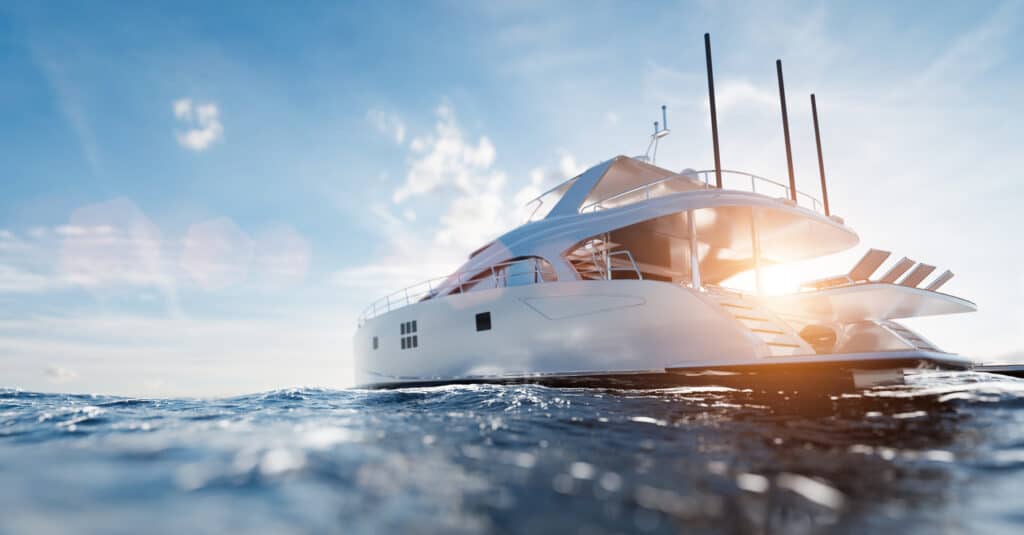
The modern catamaran is far more different than its crude ancestor. Instead of tree cutouts, catamarans are now carbon fiber or fiberglass. Here are the different types of catamarans:
Based On function
Pontoons are usually present on rivers and lakes and sometimes even on oceans, but they only travel near the shore.
In a catamaran pontoon-type boat, the pontoons serve as storage areas, where you will find the onboard motors. They are useful for water leisure activities such as short water trips, tubing, wakeboarding, and water skiing.
Some pontoons may also serve as houseboats. They provide a broader, more stable platform ideal for a floating house. Plus, the space is bigger, and most of it is above water. It offers a better viewing option than a monohull. ( Source )
Small Waterplane Area Twin Hull is a catamaran-type boat that the United States Navy initially used for military purposes. They provide the water stability that is necessary when transporting heavy military equipment.
One example of a military SWATH catamaran is the Spearhead class EPF. It is as long as a World War II escort destroyer, yet it is twice as fast at 43 knots. It can reach that speed because of its two separate hulls.
Because of their innate speed, SWATH catamarans can become patrol boats in lakes and rivers. They can easily outrun and outmaneuver standard watercraft.
Nowadays, there are SWATH cruise ships and other non-military variations. ( Source )
Based On Design
- Sailing Catamaran
The smaller sailing catamarans do not have auxiliary engines, so the owner can propel the boat by harnessing the wind using the sails. It’s a popular choice for people with very little or no sailing experience because they are light and easy to use.
The larger sailing catamarans are for group charters and long-distance cruising. They have become so popular lately that they now outnumber monohulls in tropical locations all over the world. They have a last, a headsail, and a mainsail. And the twin hulls have one engine each.
- Power Catamaran
Unlike their sailing cousins, the powered catamarans do not have sails. They have massive engines which provide high speed. Their twin hulls are stronger and can carry and protect the large motors.
The smaller “powercats” are used mainly for fishing. The bigger ones are rented out for charters and cruises.
Catamaran Hulls Performance
Thanks to the catamaran hulls, the boat offers many advantages over other boat types.
- Because its dual-hull design provides a broader base, it offers more water stability than monohull boats. It makes the cat (catamaran) a popular choice for fishing expeditions and cruises.
- Riding a catamaran is ideal for people who feel seasick whenever they ride boats. The twin hulls prevent the boat from moving from side to side. The hulls allow the boat to travel smoothly, even on moderately choppy waters.
- The catamaran is the best choice when storing provisions and other household items with less heeling and bobbing.
- The twin hulls’ stability is ideal for many activities such as cooking and partying.
- Cats offer more moving space because of their broader base, thanks to dual hulls.
- With a catamaran, you have two great options on where to hang out. You can do it on the spacious deck or below the galley.
- Compared to a monohull of the same size, the catamaran can accommodate more equipment and people.
- The living area in a catamaran is above the water line. This feature provides more natural light, a greater view of the outside, and better air circulation.
- Since catamarans do not have keels, they can anchor on shallow waters, something that most monohulls will not be able to do. This ability of catamaran boats is impressive, especially if you are going around areas with many reefs and small islands.
- Catamaran hulls allow the boat to cut through the waves easier and faster. It means they require less engine power than their monohull counterparts.
- Because it has two engines and two rudders, the catamaran can easily maneuver in very tight spaces.
- Because they do not carry heavy keels, catamarans can sail faster than monohulls.
- The catamaran’s stability, speed, and weight make it a safer option than the monohull. It can sail in shallow waters, make a 360 degrees maneuver effortlessly, and carry more provisions.
Disadvantages Of A Catamaran
Like any other boat type, the catamaran also has drawbacks and limitations. Here are some of them:
- The catamaran hulls prevent the boat from sailing as fast as the monohull upwind. The two hulls cause drag, and this slows the boat considerably.
- Because of its bigger size, looking for a docking site can be more difficult and costlier than a monohull.
- For hardcore sailing fans, the experience of sailing with a catamaran will never be able to match that of sailing with a monohull. To them, the challenge of true sailing is just not there with a catamaran.
What Are The Hulls Of The Catamaran Called?
According to the Online Etymology Dictionary, the Tamil word கட்டுமரம், which is pronounced as kattumaran, is where the word catamaran takes its name. The word means “pieces of logs tied together”. Through the years, the term has evolved into what is now a catamaran in English.
What Are The Characteristics Of A Catamaran Hull?
- Both hulls of a catamaran complement each other to achieve very minimum water resistance.
- Because of this, it takes less energy to propel a catamaran, whether via an engine or sails.
- The catamaran hulls provide stability to the boat. The twin-hull significantly reduces bobbing.
- The catamaran’s ability to keep steady on the water makes it an ideal vessel for cooking, dining, and storing provisions.
Are Catamarans Good In Rough Water?
Catamarans are amazingly stable in rough water. The catamaran’s design and build, which provides stability, are factors why it is one of the best boats to use when the waters are choppy.
Yes, catamarans are relatively more expensive than monohulls. Nevertheless, since single-hull boats are less expensive, their resale value is also cheap.
If you add all the advantages that a catamaran offers – safety, comfort, and speed- it does not come out expensive.
patekphilippe.io
Share this post with your friends, subscribe to our newsletter.
Join us in our love for all things water. And Adventure.

How To Clean A Kayak
Kayaks fabrication uses several different materials that react differently to the water. These materials also respond differently to the conditions of the kayak storage. Kayaks are, in most cases, only used seasonally, which means they spend a significant time stored out of sight and out of mind. The biggest challenge to cleaning a kayak is

How Much Does A Catamaran Cost? (Big Crazy $$$?)
You’ll want to know the Catamaran cost if you find sailing on lakes and fishing exciting. Then, a catamaran boat is your best bet. A catamaran is a watercraft featuring two parallel hulls. The name ‘catamaran’ is from the Tamil word, kattumaram, which means logs bound together looking like the first fishing boat designs. How

How Long Does It Take A Canoe To Go… (Canoe Calculator Here)
You asked, and we answered: Here’s a calculator to determine how long your canoe trip will take. The calculator uses the average speed of an average canoe in calm water. Here it is: The Canoe Trip Time Calculator: Canoe Trip Calculator Enter the distance: Kilometers Miles Calculate Canoe Articles & Information replica rolex
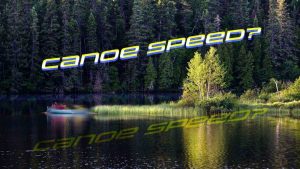
How Fast Can Canoes Go? We Find Out (With World Records).
Sliding over the glass-like stillness of a peaceful morning lake, a ride in the canoe is an incredible experience. The mist rising slowly off the water and wildlife waking to the coming day can be a nearly magical experience for the canoeist. However, it may not be only about peace and tranquility. If you like

A Boaters Guide to Suzuki Outboard Engines
Till 1994, Suzuki manufactured two-stroke outboard engines. But to grow in the boat market, it began manufacturing four-stroke outboard motors, whose popularity was a big hit. Still, many people wonder if Suzuki makes good outboard motor? People may doubt the quality of Suzuki’s outboard engines. However, with proper maintenance, the motors can last for thousands

Can Sailboats Go Against The Wind? Here’s How!
Can sailboats go against the wind? Let’s find out! There is a saying that you can’t change the direction of the wind and would have to adjust your sail; how true of it. One cannot alter the wind’s current by will or any other method; that is why one should adjust their sail accordingly. Generally,

Boat Information By Type
© 2023 Boating.Guide, A Hyperwave Media Group Ltd. Publication.
Privacy Overview
Catamaran Design Guide
Spectacular sunsets in the Pacific turn the horizon into a brilliant spectrum of gold and orange colors.
Copyright © 2006, 2008 by Gregor Tarjan. Click here for terms of use.
performance, yet desire high daily averages and passage times, which should be as short as possible. When choosing a large multihull, sailors look, above all else, for safety and comfort, long before the consideration for flat-out speed comes into the discussion. Nevertheless, performance is a highly important design consideration. No catamaran sailor wants to sail slower than a same length ballasted keelboat. Below are some EVALUATION & COEFFICIENTS useful coefficients, which will help compare monohulls and multihulls objectively.
Bruce Number (BN)
below "Indigo," a magnificent Wormwood 70, sailing in sparkling Caribbean waters.

Various multihull characteristics and design features can be expressed in mathematical formulas. Their results are crucial and will give prospective owners a basis of comparison between different types of catamarans. These numbers are important, as they eliminate ambiguity and clearly display various advantages or concessions of a design, which would be hard to quantify any other way. Mathematical coefficients not only will provide insight into a boat's performance in varying conditions, they also reflect concerns about loads to be carried safely, speed and stability.
We have already mentioned the Displacement/Length and Sail Area/ Displacement ratio in our chapter on Multihull Advantages, illustrating the point of a multihull's efficiency. Let's look at some other coefficients that give us an indication of a boat's performance.
What is performance and how do we really measure it? Most people who buy a cruising catamaran are not really interested in racing
The Bruce Number is very similar to the Sail Area to Displacement ratio although the formula is slightly different. It is the square root of the sail area in feet, divided by the cube root of the boat's displacement in pounds:
SA = upwind sail area (mainsail and 100% jib)
Displ = weight of the boat in pounds
Similar to the Sail Area to Displacement ratio, the higher the coefficient the faster the boat and better is its performance in light air. Typically a BN of 1.1 will be the threshold between fast and more sluggish multihulls. A heavy displacement monohull might have a BN of .7, whereas a modern cruising catamaran shows a BN of 1.3. Offshore multihull racers can have BNs of 2.0 and higher. The BN will also tell us about a catamaran's ability to withstand stronger winds before reefing. A boat with a higher BN is usually overcanvassed in strong conditions and will have to be reefed earlier than one with a lower coefficient.
On the other hand, they will be able to produce more "power" than their counterparts in lighter winds and perform better.
Sail Area to Wetted Surface (SAWS)
SA/WS = Sail Area Wetted Surface Coefficient
SA = upwind sail area
WS = total underwater surface area (hull and appendages)
This formula simply divides the upwind sail area of the boat (mainsail and 100% jib) by the wetted surface. This coefficient will give us a statistical indication of the multihull's lightair performance since in low wind conditions skin friction becomes an important factor. Monohulls can have coefficients of at least 7% more than multihulls.
Hull Fineness Ratio (HFR)
The Hull Fineness Ratio, known as the hull's beam-to-length ratio, is an interesting number. It is derived by simply dividing the waterline length of the hull by the waterline beam of the hull.
Max. WL/Max. Beam WL = Hull Fineness Ratio Max. WL = length of the hull at waterline in ft. Max. Beam WL = beam of the hull at the waterline in feet.
Monohulls, when compared to multihulls, have low hull/fineness ratios. In Part 1 of this

book, discussing "Efficiency," we saw that ballasted keelboats are limited to Archimedes' principle of hull speed (1.34 x VWL). Multihulls do not have these theoretical barriers, because their hulls are narrower.
The thinner the hull the faster it will be able to travel through the water. But, attention! It will also carry less unless you are on a mega cat. Typically, a 40' cruising catamaran's HFR will range from 8:1 to 10:1. Dennis Conner's above While sailing under spinnaker and experiencing virtually no roll at all, guests will always find a comfortable spot to relax on the foredeck, an impossibility on a monohull.
There are various methods of calculating the transverse stability of a catamaran. One of the simplest and most utilized techniques is establishing a relationship between the height of the Center of Effort (CE), displacement, beam and sail area. Multihull designer, James Wharram added safety factors of 20% to compensate for gusts and the dynamic environment of the ocean. Another method is described in the text below.
Multihull Stability & Capsizing Moment d - Displacement (kg) x half beam (m) max ~ Sail Area (sq m) x Height of Center of Effort (m)
P max = maximum pressure exerted onto sails
Multihull Stability & Capsizing Moment

height of sailplan CE
half overall beam (half hull beam)
racing cat "Stars and Stripes" had a 16:1 HFR. Of course, the larger the boat, the narrower the hulls will become in comparison to its length. For example, the HFR of a 100' luxury catamaran may be 12:1, providing it with a high speed potential. However, monohulls can show HFRs of 3:1, though the comparison is complicated as their angle of heel affects the measurement.
One has to be very careful when analyzing the Hull Fineness Ratio of a cruising catamaran, because other factors such as the actual shape of the hull cross sections (Prismatic Coefficient, PC) can throw the analysis off balance. Go-fast sailors like to think that fine hulls are always fast. That is not necessarily true because a slim hull could have a large underwater volume, thus slowing it down. Consequently, a wide waterline-beam hull could have less drag than a narrower one. It could have a shallow underbody (low PC), which would be beneficial to load carrying (Pounds Per Inch Immersion Number, PPI) and early surfing characteristics at speed.
Stability Coefficient (SC)
This mathematical formula has been devised by the distinguished catamaran designer and sailor James Wharram and his team. This coefficient analyzes a multihull's ability (in a static environment) to resist capsizing due to wind.
( 0.682 VW x (.5 Boa) ) x .555 = CW .00178 x SA x h
W = Wind speed, apparent, in mph CW = Critical Wind Speed to capsize in mph SA = upwind sail area in sq ft. h = height of Center of Effort (CE) of total sail area
Boa = Beam overall
This formula will tell us how much wind it will take to overturn our multihull. By instinct we will know that a catamaran with a wide stance and a conservative sail plan will be very stable offshore. The SC formula will inevitably illustrate that a wider beamed catamaran with a tall sail plan will be as resistant to wind induced capsize as a short-rigged, narrower boat. This is not so if one considers the chaotic environment of waves and the real world of heavy weather sailing. It is interesting to note that a wide beamed boat (regardless of the SC) is more resistant to capsize in seas due to the effects of a higher moment of inertia. In an open-ocean environment, which is everything but static, the SC formula has little meaning. Nevertheless, it serves as a good basis to evaluate stability as a factor of wind force.
below When the wind suddenly comes up, all that is needed is a couple of turns on the jib furler to quickly reduce the headsail size. The catamaran will hardly sail any slower, but feel more comfortable.

Wide hulls and a large overall beam will increase the overall righting moment of a catamaran. A word of caution: Excessive beam will reduce the fore and aft stability. Designers strive to compromise hull fineness ratios, place heavy weights towards the CG (Center of Gravity), and engineer hull and overall beam to achieve a seaworthy balance, which is safe, yet provides ample liveaboard accommodations.
Catamaran Stability Considerations

Diagonal Stability & Beam-to-Length Ratio (BLR)
Stability of a multihull, or the resistance to capsize, should be seen as three components. Athwartship Stability is one well-publicized type and the one often talked about. The other much more important types are Fore and Aft and Diagonal Stability. Fore and aft stability is established by the relationship between the boat's waterline length and the distance between the hull centerlines. It will reflect the catamaran's resistance to tripping. This relationship should be in the vicinity of 39% to 42%. For a seaworthy cruising multihull it is important maintain the proper ratio between length and beam, which, in turn, balances equal amounts of athwartship with diagonal stability. The goal should be to prevent the possibility of a sudden discrepancy of powers between fore and aft and sideways resistance. Most of today's multihulls keep these two component forces in equilibrium, making them extremely seakindly and safe.
Some early design multihulls were very narrow, partly due to the material limitations of that time. But things have changed. Contemporary composite construction allows designers to build wider boats without compromising stiffness. Production catamarans of today have a wide stance and have the benefit of greater safety margins in gusty wind conditions than their older cousins. Multihulls are sophisticated structures and true modern miracles. They provide a more comfortable ride and more interior room. Thanks to modern materials they weigh less and perform better than catamarans built only 10 years ago.
Some catamarans, especially production boats, which are very popular in the charter fleets, are growing wider by the year. The businesses who rent these beamy monsters adore them. Lots of room plus open decks are ideal for clients and the bigger (wider) the boat, the more paying guests can share the fees. But there certainly is a limit as to how wide is too wide. Extreme beam can be dangerous. It can lead to instability fore and aft and to excessive bridgedeck slamming, as the relative distance from the bridge deck to the water will decrease with an increase in width. A vessel with excessive beam might seem stable athwartships, but it will compromise overall stability.
We know that multihulls can, in extreme cases of seamanship error in wild storms, be thrown over from any side - front, back and beam-on. The best examples of this phenomenon are racing multihulls, especially Formula 1 trimarans, which have fine hulls for speed and huge sailplans to provide driving power. They are initially extremely stable athwartships (High Beam-to-Length Ratio), but have a tendency to become unstable fore and aft. They will surf down waves and reach a point where the power of the sails, and speed, will exceed the ability to keep the bows out of the water and the boat will pitchpole. This is the reason why catamaran designers usually draw their multihulls with a Beam-to-Length relationship of between 50% and 55%. The longer the vessel the lower that percentage becomes.
I am currently involved in the "Gemini" project, which presents an example. It very well might become the world's largest sailing catamaran. She will have an overall length of 145 feet, yet her beam will "only" be 54.4'.

Please, don't worry. "Gemini" will not be tender and tip over in the slightest breeze. On the contrary, this monster will be one of the most stable craft afloat, although the beam-to-length relationship is only 37%. The relatively low beam-to-length ratio also involves the fact that the boat would be too heavy and building costs would be prohibitive if she were to have a standard 52% BL relationship. Most importantly, could you imagine turning a 75-foot-wide boat?
above Asymmetric spinnakers on furlers are great inventions. They add instant sail area, yet can be doused in a matter of seconds when the wind picks up strength.

above Although this Edel 35 was a good-looking and popular catamaran, it suffered from excessive bridgedeck pounding, which was caused by only several inches of clearance between the saloon's underwing and the sea.
Obviously there is a sweet spot in the beam vs. stability question. Designing too beamy a boat will also necessitate more freeboard to preserve bridgedeck clearance which, in turn, will increase windage and complicate maneuvering. Unless sophisticated aramid construction methods are utilized, more beam will also add more weight and stress to the structure. Adding more mass will, to a certain point, help make the boat more stable, but where do we stop? Is it better to add weight or width to make a boat stiffer? Of course, both characteristics are interrelated as a beamier boat normally is also heavier. Just adding weight to a catamaran simply to make her more stable will not pay off. Consequently, making a boat too wide might increase living space yet it will also burden the structure, require a beefier manufacture, and yield an even heavier boat. Needless to say, a boat which is too wide will also create practical restrictions such as maneuvering, the ability to haul the vessel and much higher building costs.
Beam has a great effect on bridgedeck clearance, which is one of the most vital characteristics of a good cruising catamaran. As standard practice, the well-known rule of 1" of bridgedeck clearance for each foot of beam was a safe way to prevent excessive wave slap. The wider the beam the more the relationship changes and the necessary height of 1" per foot of beam needs to be increased to 1.3" or more. In the extreme case of overly square boats, that number will have to be closer to 1.8" per foot of beam. This will have a negative effect on any seaworthy multihull that has a bridgedeck saloon. The wide beam will necessitate a high cabin sole to remain a safe distance from the waterline. In order to provide standing headroom, the coachroof might be higher than practical, which could result in a boxy, high-windage multihull. Not only will this be unattractive, but also raise the Center of Gravity (CG) which really should be kept as low as possible.
More overall beam on the other hand (given that there is still sufficient bridgedeck height) has a less known benefit, as it reduces the possibility of hull-wave interference, which is particularly important for fast designs. The wave interaction between the hulls can lead to additional resistance, and especially in an agitated sea state, the formation of wave crests can pound the bridge deck. Most early narrow-beamed catamarans suffered from this phenomenon,
Ultimately, a boat's design has a major influence on its ability to stand against the forces of nature, and to keep occupants safe. Manufacturing excessively wide catamarans is like trying to market monohulls with super deep-draft keels. Both are totally impractical. We designers have to make sensible compromises and learn from past experiences of what has worked at sea by balancing the benefits of a wide boat with its disadvantages.
below This narrow-hulled Outremer 64 Light has completed her third circumnavigation with the same owners. Note the smooth underwing clearance, lacking any protrusions or steps.

"A great cape, for us, can't be expressed in latitude and longitude alone. A great cape has a soul, with very soft, very violent shadows and colors. A soul as smooth as a child's, and as hard as a criminal's. And that is why we go!"
~ Bernard Moitessier

Dinghies, windsurfers and every imaginable type of water toy can be stored conveniently on large catamarans and easily launched from the wide transom steps for shore-side pleasures. Note the twin life rafts located in special compartments on the massive aft crossbeam.
Continue reading here: Hull
Was this article helpful?
Related Posts
- Design Dynamics - Catamarans Guide
- Hull Construction - Ship Design
- Geometry - Ship Design
- Principles of Yacht Design Ena
- Heavy Weather Tactics - Catamarans Guide
- Configuration Types - Catamarans Guide
Readers' Questions
What length should a stub keel be to waterline length on a catamaran?
There is no set rule for the length of a stub keel on a catamaran in relation to its waterline length. The length of the stub keel will depend on various factors, such as the size and design of the catamaran, intended use, and specific requirements of the boat builder. Generally, the stub keel on a catamaran is designed to provide stability and improve sailing performance, so it is important to consult with a naval architect or boat designer to determine the appropriate length for a specific catamaran.
What is a 16 passenger catarmarn like?
A 16-passenger catamaran is a type of boat or vessel specifically designed to carry 16 people comfortably. Catamarans are multihull boats with two parallel hulls, which are connected by a deck or a structure. They offer stability, speed, and efficiency in the water. A 16-passenger catamaran can vary in size and design, but generally, it will have enough seating or lounge areas for all passengers. It may have indoor cabins with beds or seating areas, as well as outdoor spaces for relaxation or socializing. These boats often come equipped with amenities such as bathrooms, kitchens or galleys for meals, and sometimes even entertainment systems. The catamaran's size can influence its specific features. Some catamarans are designed for day trips or shorter excursions, while others are built for longer journeys or overnight accommodations. Additionally, they can be used for various purposes, such as whale watching, diving trips, ferry services, or private charters. Overall, a 16-passenger catamaran provides a comfortable and stable platform for small groups or gatherings, allowing passengers to enjoy the beauty of the water while ensuring safety and comfort.
Is the catamaran hull floor always on the waterline?
No, the hull floor of a catamaran is not always on the waterline. The design of a catamaran allows for the hulls to be elevated above the waterline, reducing drag and increasing speed. The position of the hulls in relation to the waterline can vary depending on factors such as the weight distribution, load, and sailing conditions.
How close to a catamarans design reefing points should you go?
You should always be careful when approaching reefing points on a catamaran and stay as far away as possible. Generally, you should aim to stay at least 10 meters away.
What keel to length ratio for catamarans?
The keel-to-length ratio for catamarans typically ranges from 0.1 to 0.25.
Is 70% length to beam ok for a catAMARAN?
Yes, it is generally accepted that a catamaran should have a length to beam ratio of between approximately 6:1 and 8:1. Therefore, a 70% length to beam ratio would be within an acceptable range.
What is the waterline length to baem ratio of a typical cruising catamarans?
This ratio will vary depending on the type and size of the catamaran. Generally, the ratio should be between 1:1.5 and 1:2.5, with 1:2 being the most common.

How To Create the Perfect Cruising Catamaran Layout
As an Amazon Associate, we earn from qualifying purchases. We may also earn commissions if you purchase products from other retailers after clicking on a link from our site.
More than ever before, sailing fans are gaining an interest in catamaran layouts and designs that define performance. Many others are also looking into either buying a cruising catamaran or designing and building one. While building a catamaran is no piece of cake, this article shows you how to create the perfect cruising catamaran layout.
To create the perfect catamaran layout, carefully consider factors like a good hull design, optimal helm station placement, boat stability, and adequate load-carrying capacity. Excellent galley positioning, ease of handling, and spacious living and sleeping quarters are also crucial.
The modern cruising catamaran is a far cry from the simple Polynesian double canoe of old. That’s because structural innovations and new composite materials have resulted in multihulls with impressive cruising abilities. Keep reading to learn more about exceptional catamaran layouts.
The Changing Trends in Catamaran Designs
The early cruising catamaran designs resulted in boats that could sail much faster than traditional sailing boats. In addition, they could glide with ease in shallow waters and required less wind and crew. Unfortunately, these cruising cats were heavy, had small, cramped interiors, and boasted somewhat challenging handling abilities.
Today’s cruising catamarans are different. They boast the utmost comfort, high speeds, and the safety of a well-designed cruising yacht. They are also more exciting, visually appealing, deliver the smoothest of rides, and sport more spacious interiors.
Have a look at the below video showcasing the top ten cruising catamarans:
Features To Look Out for in Catamaran Design Layouts
Cruising catamaran designers understand what most sailors look for in a cruising vessel. They, therefore, design cruising multihulls that address these pertinent issues and more. Some of the features you might want to consider having in your dream boat include the following:
- Responsive performance. Outstanding performance allows for pleasurable cruising and ensures your safety since you have more options during difficult weather.
- Excellent load-carrying ability . This allows you to have an extended cruising vacation or ocean crossing.
- Boat stability . Go for lightweight, robust construction, which results in a lot of buoyancy.
- A low center of gravity for smooth rides and enhanced performance. Centering weight around a low center of gravity improves the overall sailing quality, reduces pitching movement and reduces the risk of capsizing .
- Adequate bridgedeck clearance to reduce slamming and provide better performance in rough conditions. A high bridgedeck also means less noise and slapping action from the waves hitting the boat bottom, thus ensuring a quieter, smoother ride.
- Comfortable sailing. To enjoy a quality life on board, you need comfort while at sea. Thus, elements like gentle movement, no creaks or groans, no bridgedeck slamming, and minimal pitching are essential for quality, peaceful and restful sleep.
Now that you know what a cutting-edge catamaran features, let’s look at how to create the perfect cruising catamaran layout.
Build a Larger-Sized Catamaran
The early catamarans ranged between 36-42 feet (10.9-12.8m). At the time, this appeared to be a good size in terms of safety and ease of handling. However, the boats were heavy, and the additional drag and displacement adversely affected their performance and windward ability.
It’s now possible to make the new generation catamarans lighter, larger, and more spacious with excellent power-to-weight features. The current trend is larger-sized catamarans in the 45-50 feet (13.7- 15.2) range. Composite engineering and technologically advanced equipment such as furling systems, electric winches, and autopilot make it easier for a smaller crew to sail larger boats with confidence. And to do so without compromising safety or stability.
Get the Best Catamaran Hull Design
A cruising catamaran’s performance depends on three main aspects; its length, the sail area, and the boat’s weight. Long boats are generally fast. A light boat with more sail area is also faster than a heavier boat with less sail area. In other words, you can make a multihull faster by making it longer, lighter, or adding more sail.
However, there are exceptions to this rule; a boat with too much sail area is more likely to capsize if there are brisk winds. Also, if the boat’s design makes it too light, it’ll be unable to handle much punishment, while a hull design that’s too slim would make the vessel incapable of carrying any significant loads. But that’s not all; if the boat is too long or too large, it’ll become grossly exorbitant. Narrow hull shape might also mean smaller cabins.
Nonetheless, these three factors alone are not enough to determine a cruising catamaran’s performance. While faster boats boast finer hulls, the wetted surface area tends to increase as fineness increases; thus, fine hulls end up becoming less fast in low wind speeds. Also, very wide hulls mean a reduction in actual performance.
The Prismatic Coefficient (Cp), a measure of how full the ends of the hull get, is the most essential design hull shape factor for any catamaran. A high Cp equals high speeds, although you can still use a lower Cp if you have fine hulls. Nevertheless, the key to a good Catamaran design is a higher Cp for fast sailing.
To achieve a high Cp, there are several things you can do:
- Fit bulb bows . Unfortunately, the bulb bows tend to slam in a seaway when you do this.
- Have an extensive planning aft section . However, this can increase the wetted surface area, WSA and lead to additional challenges.
- Flatten out the hull rocker and add a bustle aft. This helps to add displacement aft.
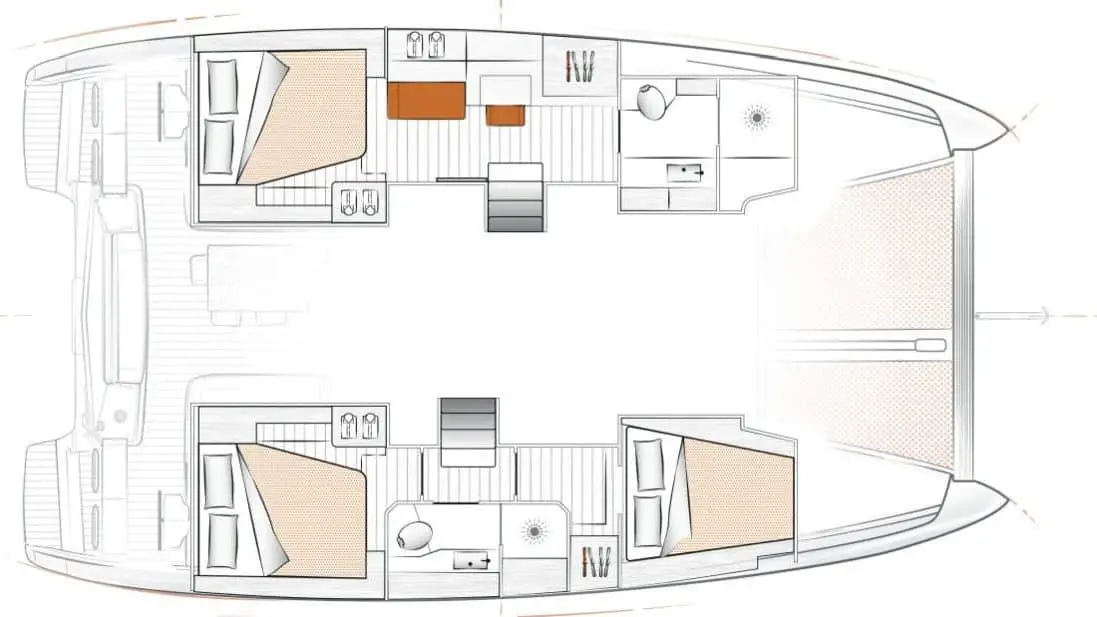
Build Convertible Main Living Spaces
The open cockpit is now a thing of the past. Instead, pioneering designers for catamaran manufacturers like Nautitech, Gunboat, and Catana now replace traditional-style salons, cockpits, and cabins with spacious indoor and outdoor living spaces. The concept involves merging separate saloon and cockpit areas with duplicate lounge spaces and the use of hard-wearing composite materials.
You can also design the cabin to suit your preferences. You may decide to add a cabin or remove one, add a bathroom, have the forward berth in the hull or on the wing deck.
- The design enhancements boost usable space while opening up the living areas.
- It reduces time and costs for interior maintenance and cleaning.
- Large windows bring in more light, increasing visibility.
- Luxurious, spacious, and airy owners’ cabins provide more comfortable living space.
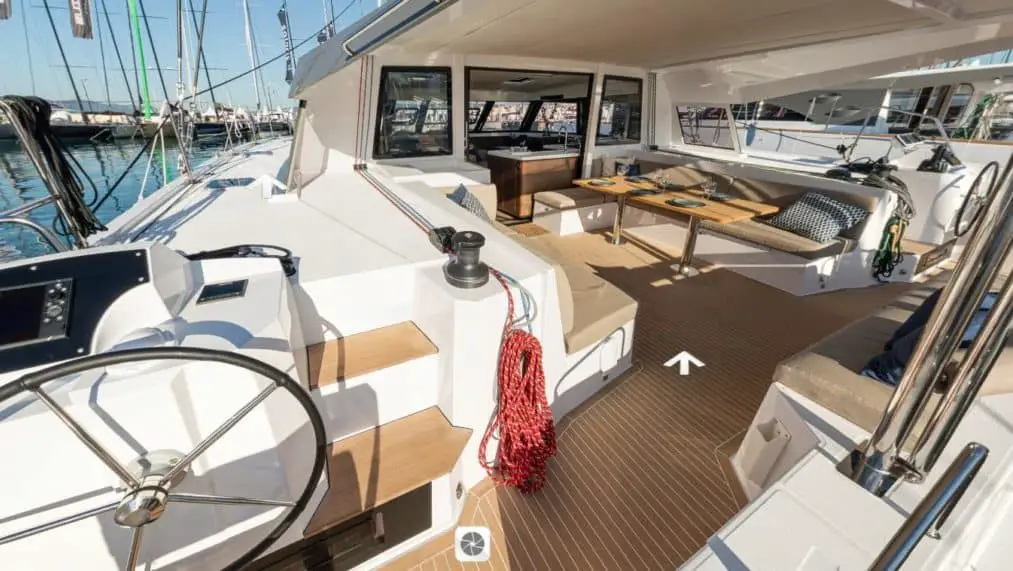
Bulkhead Helm Stations vs. Twin Stern Steering
Many catamaran owners have traditionally preferred bulkhead steering. This helm position remains popular, but twin stern steering positions come with more advantages since they provide greater sails visibility. The twin stern positions are also best suited for racing or day sailing since they often lack adequate protection for extended cruising.
Exposed helms are not ideal for a long ocean passage. Go for a safe, secure, and well-protected helm station that provides good visibility and comfortable space for long watches. Again, it’s best to have all control lines at the helm to establish a static control station. Also, have all push-button-controlled winches, instruments, windlass, and autopilot prominently located inside the cockpit.
- Twin stern steering positions give you a better view of the sails
- You get a better feel for overall sailing conditions.
- Twin stern steering positions lack the necessary protection for extended cruising.
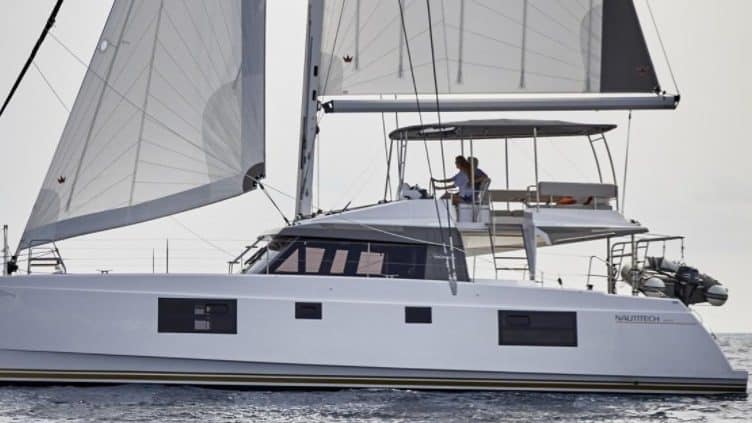
Go for the Flybridge Design
The flybridge design is appealing because it offers excellent visibility, more comfort, and additional entertainment and lounging space for everyone on board. Unfortunately for smaller boats – those below 50 feet (15.24m), there is minimal protection from the elements. As such, you might want to consider adding enclosures to offer protection. The flybridge, thus the helm, remains cut off from the vessel, which makes communicating with the crew a challenge.
- It provides great visibility.
- It offers comfortable spacing.
- It might be unsafe to move from the cockpit to the flybridge in bad weather.
- It isn’t easy to communicate with the crew.
Daggerboards vs. Fixed Keels
Average cruising catamarans typically utilize fixed keels while high-performance cats have daggerboards . Fixed keels allow you to beach your catamaran easily, and your hull remains intact if a collision occurs. While you lose some angle when sailing upwind, you gain more interior space in the hulls that you can put to good use.
Daggerboards are essential in a performance cruising catamaran since they guarantee that the boat delivers good upwind sailing, including during difficult situations. During long passages, they allow you to point better upwind though the drawback is that they consume much interior space within the cruising catamaran’s hulls.
Since flying on foils ( hydrofoils ) isn’t that practical on cruising catamarans, designers of larger-sized boats have also come up with modified daggerboards. These daggerboards produce lift and prevent leeway, too, thereby improving performance significantly, as seen with the Catana 59’s curved daggerboards. These foil-like daggerboards lift the boat ever so slightly upon reaching higher speeds, making it feel less heavy and much faster.
At the end of the day, calculating the performance of a boat sailing in a wide range of varying seas and winds might not be easy – despite a daggerboard or fixed keel configuration. This is because upwind speed depends not only on the sails’ quality but also windage and the height of the bridgedeck beyond the water.
- The design innovations -curved daggerboards and hydrofoils- improve catamaran performance significantly.
- Daggerboards enable you to access otherwise inaccessible anchorages.
- Daggerboards take up hull space in the hulls of your vessel.
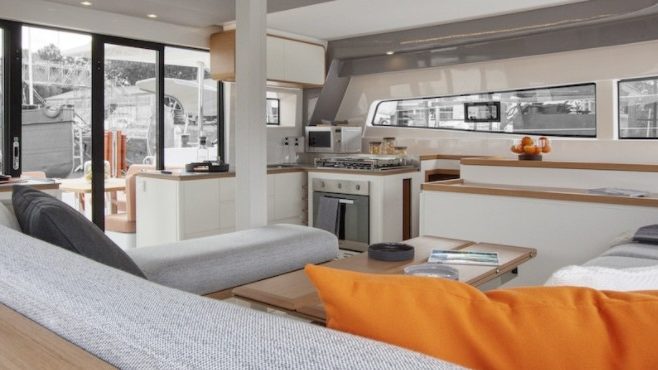
Galley Up vs. Galley Down
Galley layout are becoming more and more important as more people, including families, start sailing regularly. While at sea, your galley needs to be a safe place, well-ventilated, and functional. Everything should be well-thought-out for the sailor’s comfort, including handholds to make it safer to move around the boat.
While the galley location can either be up the bridgedeck or down in the hull, galley up appears to be the most popular trend. This makes the galley the focal point of both the living space and entertainment areas.
If you have a family, this placement is ideal since you make your meals from the galley and get to spend most of your time here. Many cruising families and couples prefer this arrangement and find separating the galley down the hull unappealing. Besides, carrying hot food up and down the staircase is unsafe.
Still, galley down is ideal for charter boats since it offers a private cooking area and uses up hull space efficiently.
- Having the galley on the bridgedeck is ideal for families and cruising couples.
- Placing the galley on a similar level with the serving area and cockpit is safer and less tiring.
- There’s better ventilation on the bridgedeck, making for comfortable cooking.
- There’s less kitchen privacy galley up.
- On smaller catamarans, this layout can impact the size of the saloon seating area significantly.
Production Catamaran vs. Custom
The choice of either a production catamaran or a custom design might seem pretty straightforward. Production catamarans from major brands come backed by proven designs, dependable construction, solid warranties, and many years of experience. The catamarans are easy to service, source for parts, and most – particularly the owner’s versions – hold on to their value, making them much easier to resell.
On their part, custom boats are fantastic in that you can tailor them to your exact needs. However, they might be more challenging to maintain or service. That’s because of parts unavailability and lack of construction knowledge.
Choose Quality Construction Materials
The best quality materials to use on your catamaran are both light and robust. While carbon fiber is great, plywood, plywood/epoxy, and strip-cedar are excellent materials too. What’s more, they are also affordable, so you don’t have to get too hung up on cutting-edge building materials. What matters is build quality; thus, a well-built plywood catamaran boat can last as long as a boat made from more high-tech materials.
Combining various materials also helps combat some of the issues that plague plywood boats in terms of resale value. At times, the design tends to make the boats appear pretty dated.
- Plywood and strip-cedar materials are affordable and provide excellent build quality.
- Plywood boats may have a lower resale value than those built with modern materials.
Consider Ease of Handling
An important factor in handling a cruising catamaran is deck layout. Most cruising catamarans sailed short-handed , so if your boat has one helm, all lines should run back here to allow for a static control station for the entire boat.
The other essential element is visibility from the helm. The 360 degrees of visibility while maneuvering, docking, or underway is crucial to your boat’s safety, as well as life and property. As such, you should be able to view both bows, or at least the pulpits and sterns, while standing at the helm. If not, you may have challenges handling the boat due to blind spots.
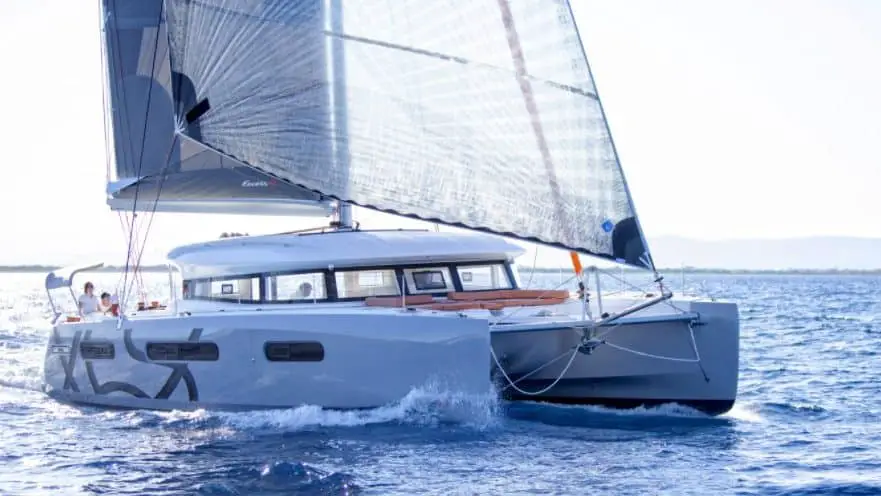
Consider the Load Carrying Capacity
A well-designed catamaran is enjoyable to sail in all weather conditions. It’s also much easier to handle than a monohull because of its widely spaced twin engines. But when you immerse extra hull depth, the vessel gets sluggish and moves slower, maneuvering in tight spots or when docking becomes more challenging. Furthermore, the hull submersion reduces bridge deck clearance, leading to hull slamming.
To allow for adequate load carrying capacity, you need a design that provides a generous displacement. This helps to ensure that you maintain reasonable bridge deck clearance even when fully loaded. It also allows you to avoid digging big holes in the water as you drag your transoms.
Displacement refers to the amount of buoyancy designed into the hulls, which essentially means that your boat will cruise better if its weight is less than your designed displacement.
Note that an overloaded catamaran not only loses out on performance but eventually, on safety too. To counter this, choose a lightweight catamaran with hulls bearing cored construction and interiors made of lightweight materials.
Remember, when you go cruising, you will need to carry fuel, extra water, supplies, equipment, and amenities, translating into thousands of extra pounds. Therefore, try and avoid the following design errors to ensure that your catamaran has an adequate load-carrying capacity:
- Avoid putting in place too much accommodation space.
- Avoid building a heavy boat ‐ use low-tech construction materials.
- Avoid installing inboards in a small boat.
- Lightly constructed catamarans perform faster and carry more weight.
- Cored construction makes for a strong and stiff catamaran, thus enabling good performance.
Final Thoughts
A well-designed cruising catamaran is a joy to behold. Today’s modern technological advancements mean that you can buy or build a light but strong cruising catamaran. And as you can see from this article, there are many excellent cruising catamaran layouts that you can choose from.
However, whichever layout you decide on needs to fit your sailing needs and purposes to ensure you remain comfortable and safe while at sea. Above all, ensure that you go for a vessel that you can handle with ease in all weather conditions.
Owner of CatamaranFreedom.com. A minimalist that has lived in a caravan in Sweden, 35ft Monohull in the Bahamas, and right now in his self-built Van. He just started the next adventure, to circumnavigate the world on a Catamaran!
Leave a Reply Cancel reply
Your email address will not be published. Required fields are marked *
Save my name and email in this browser for the next time I comment.
Recent Posts
Must-Have Boat Gear for Catamaran Sailors!
Sailing is probably the most gear-intensive activity I've ever done; there are so many decisions to be made about what gear to buy now, for tomorrow, and what to definitely never buy. The gear on...
6 Best Trailerable Trimarans For Bluewater and Coastal Sailing
Having a boat costs a lot of money, even when you are not using it, marina fees, etc. And once it is in the water most sailors never go very far from their "home marina" and sailing will be somewhat...
PROA HULL DESIGN
The advantages of proa hull design.
Setting out with the goal of building the most efficient boats we could, our founder Larry Graf and his designers sought to create earth-friendly cruisers that would inspire a new generation of boaters. And because Larry and his team played a hands-on role in developing some of the world’s best catamarans, they had an idea of what a boat could be in terms of comfort, stability, and fuel economy.
When one looks at catamarans vs. monohulls, the starting point is clear. The many advantages catamarans exhibit when compared with monohulls are an excellent starting point. Catamarans offer a stable ride with predictable hull movement. The seakeeping is excellent, even in rough conditions. Another advantage the design provides: incredible onboard space. The space of a catamaran is often comparable to that of a monohull that is 25 percent longer. Catamarans also have been proven to provide efficient operation.
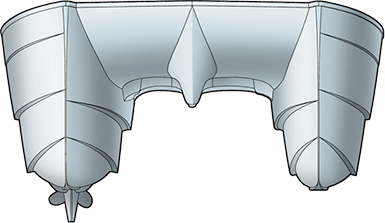
A Different Kind of Catamaran
The concept was formed, and extensive testing was done to both prove and refine the design until the hull form we have today was established and then patented.
The first boats were single-engine diesels, with all propulsion confined to the larger starboard hull. This hull has the appendages including a keel, prop, and rudder. The hull forms are hydrodynamically designed so that power on one side creates straight tracking when the rudder is centered. If it were not for this, and rudder was needed to make the boat track straight, the constant rudder movement would create additional drag. The proa hull form works efficiently with both inboard and outboard power. Performance and stability remain unmatched whether powered by a single diesel or two gas outboards.
The shape of the tunnels from fore to aft is also precisely crafted. The forward section is designed to cut through wave tops, when in extreme conditions, creating a slight amount of lift as the vessel enters the wave with no slapping. The water funnels back into the tunnel flowing evenly and exiting at the stern. This tunnel design keeps water flowing and reduces wave impact much better than the tunnels of other catamarans.
The wider starboard hull provides more space for the accommodations, and also makes it easier to access and manage the engine and machinery. The proa hull on the portside is 35 percent narrower, but its actual drag is reduced by approximately 50 percent due to fluid dynamics. A hull that is a little thinner maintains the buoyancy required to keep the boat running true but requires a lot less energy to move through the water. This makes a big difference in efficiency.
Our patented proa design for inboards uses just one engine, one shaft, one prop, one rudder, and one keel—half the typical engine appendage drag of a twin-engine design. The hulls are shaped to compensate for the engine torque. Since both fluid-dynamic and engine-torque forces are proportional to speed, the boat runs straight at every speed. Even better, the single-engine design saves dramatically on machinery weight, which in turn, saves on the required structural-component sizes and fuel needs, and their corresponding weight. This reduces the boat’s weight by around 44 percent. Less weight also equals much less drag. Thanks to solid engineering principles and innovation, our boats strike the perfect balance for the environment: comfortable and efficient.

A second round of innovation was conducted on the outboard-powered boats. Originally the second engine was to allow for a trolling motor, but testing and further refinement led to the two-engine configuration. By thinking even further outside the box, we created an asymmetrical installation that has not been seen previously: one 200-horsepower Yamaha on the larger hull, matched to a 70-horsepower outboard on the smaller hull. With the option to run on both engines or on the single larger outboard, or even just on the smaller outboard, we are able to see the advantages in efficiency.
Patent No. US 8,109,221 B2
Stay Up to Date with Aspen Sign up to receive our enewsletter.
11656 Knudson Rd. Burlington, WA 98233
Privacy Policy
Tell us your Aspen Story .
© Copyright 2012 - 2024 | Aspen Power Catamarans
(360) 668-4347 EMAIL US
- 2024 BOAT BUYERS GUIDE
- Email Newsletters
- Boat of the Year
- 2024 Freshwater Boat and Gear Buyers Guide
- 2024 Boat Buyers Guide
- 2024 Water Sports Boat Buyers Guide
- 2024 Pontoon Boat Buyers Guide
- Cruising Boats
- Pontoon Boats
- Fishing Boats
- Personal Watercraft
- Water Sports
- Boat Walkthroughs
- What To Look For
- Watersports Favorites Spring 2022
- Boating Lab
- Boating Safety
- Ultimate Boating Giveaway

Six Amazing Boat Hull Designs
- By Dean Travis Clarke
- Updated: October 25, 2016
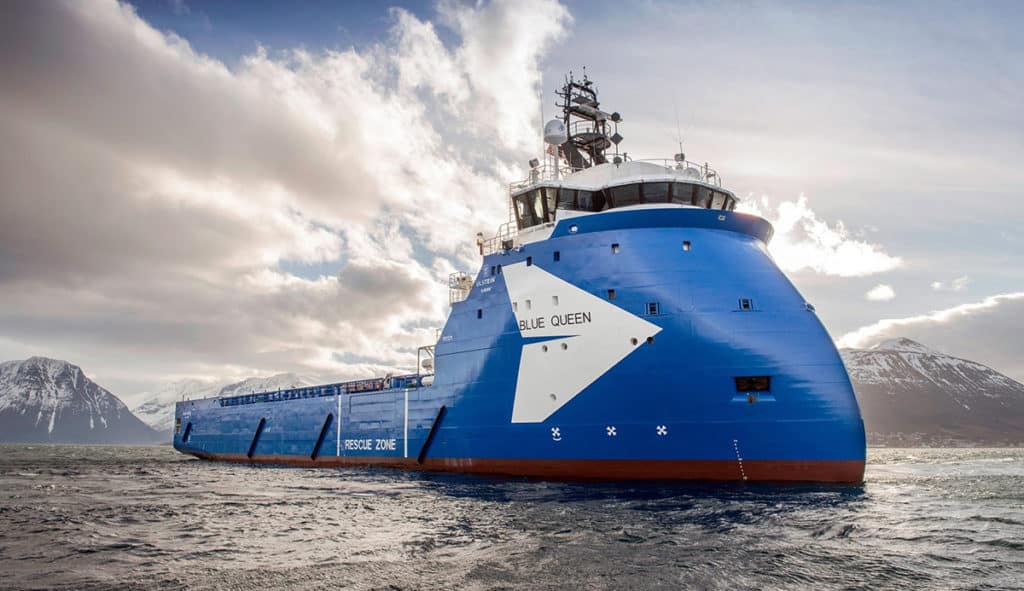
The American boating consumer bears a remarkable psychological profile when it comes to wants and needs.
A cursory glance at the lines of most boats proves that profiles haven’t changed dramatically over the past 60 or so years. Certainly, construction methods such as resin infusion and injection molding have altered business as usual, and ingredients have also changed to include all manner of space-age composites, epoxies, paints, computer mapping for engines that produces vastly greater horsepower from smaller blocks, and so on. Even propulsion has changed with the advent of pod drives and big outboards. But here’s the weird part: Any time a designer or builder introduces a model that looks significantly different, whether it is Euro-styled or functionally clunky, it fails. It doesn’t matter how well the boat performs, the typical boater rejects it because it doesn’t look like what he knows. We, as an enthusiast niche involving boats, are horribly set in our aesthetic ways.
Look at how well multihulls handle heavy seas. When it comes to seakeeping ability, efficiency and performance, the catamaran has a lot going for it, as anyone who happened to catch some of the most recent America’s Cup racing can attest. And yet, to date, production multihulls have enjoyed only moderate acceptance by boaters.
Here are six of the latest hull-design innovations and technologies being used elsewhere in the maritime world that we will likely never accept for our recreational boats — even though they all work well.
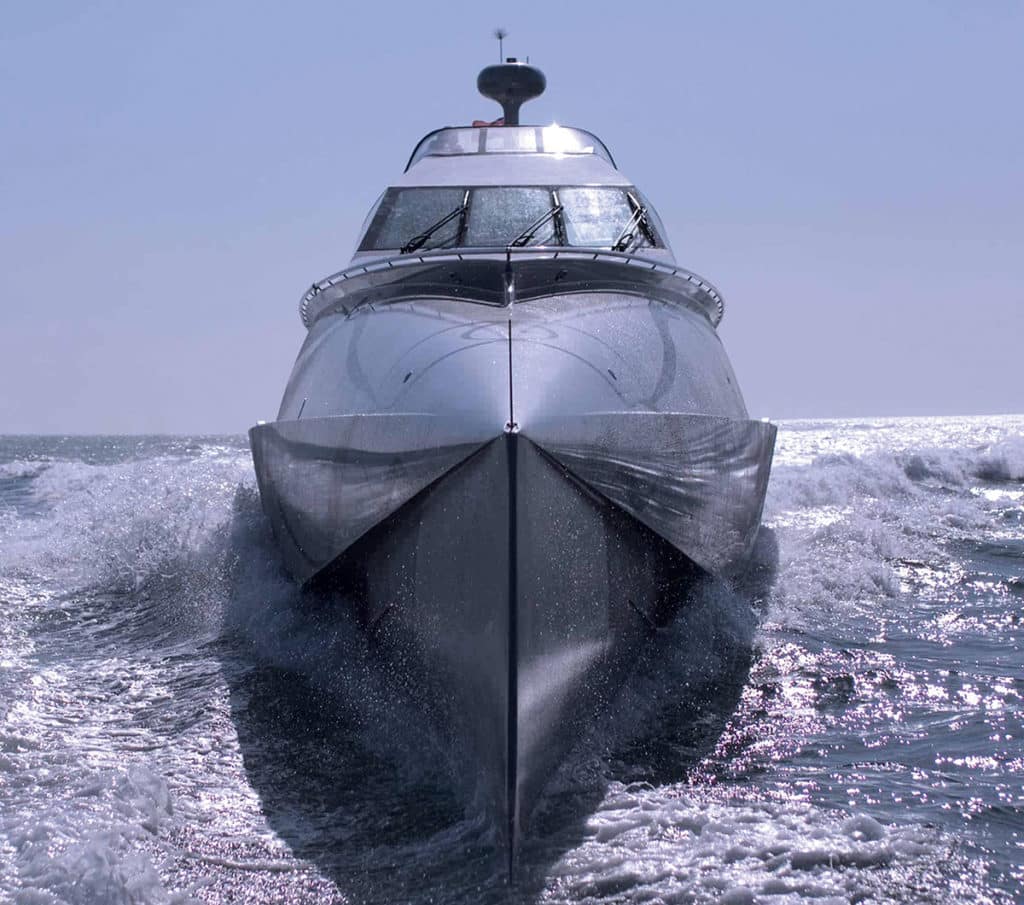
Wave-Piercing Hulls Most accounts cite wave-piercing technology as coming on the scene around the start of the 20th century. However, it has been employed as far back as the times of the Phoenicians and ancient Romans. The design concept consists of a bow with little buoyancy, a hull that slopes inward from the waterline and, ergo, a large reduction in wave-making resistance. While it works well in heavy seas, the drawbacks include reduced interior volume forward and a very wet ride because the waves come up and over the bow as a matter of course. Wave piercers fell out of favor for a period of time due to these same drawbacks but have recently enjoyed a resurgence of popularity because of their dramatic fuel-efficiency gains.
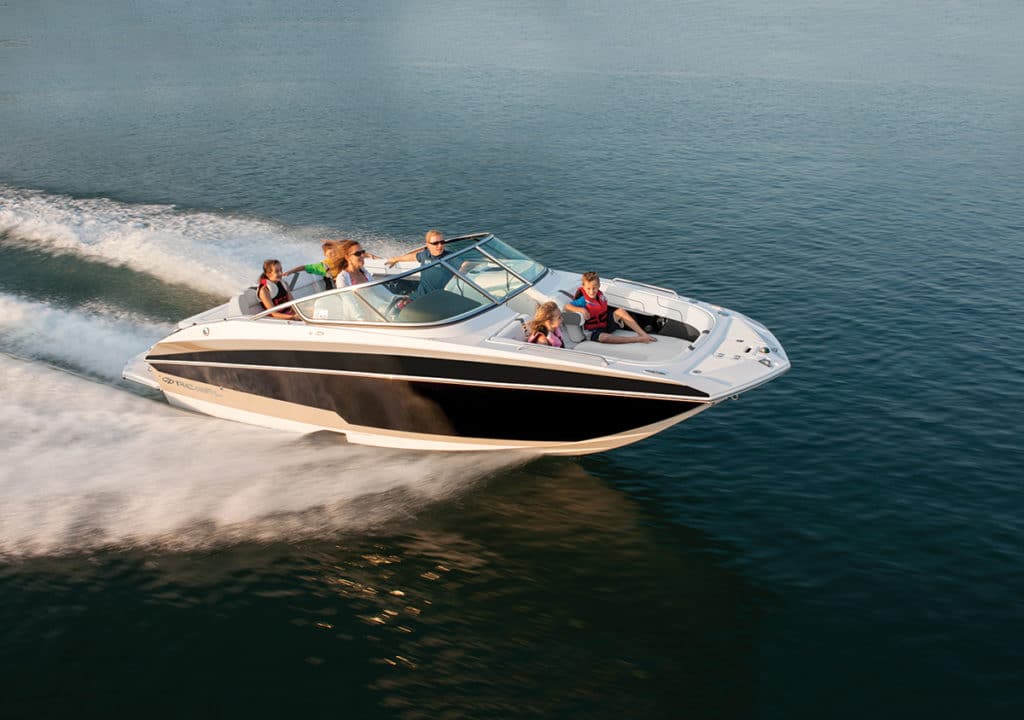
Stepped Hulls OK, this hull form has achieved a certain level of acceptance in our recreational boats, mostly in performance boats or offshore center consoles. But why isn’t it more popular? The stepped bottom has been around as a V-bottom refinement since at least 1912. Steps are grooves in the hull stretching outward from the keel to the chines. Most hulls sport one or two steps per side. And a vessel should really be capable of cruising in excess of about 30 knots for a stepped hull to be worthwhile. Steps work by allowing air to be “injected” against the running surface, breaking contact between part of the hull and the water, which in effect turns the running surface into numerous short, wide planes, rather than one long, narrow one.
How much the hull surface contacts the water directly determines the amount of drag a hull suffers. Steps (also called vents) decrease the amount of hull contacting the water (called the wetted surface), thereby decreasing drag, increasing speed for the same horsepower, and increasing fuel efficiency. It all sounds good. But steps also come with potential drawbacks. Though modern deep-V designs have enough deadrise to counteract the problem in most cases, stepped hulls have been known to suffer from transom slide in sharp turns at speed. They also require attention to loading and trim because the steps need the proper angle of attack to function correctly; they don’t offer an advantage in flat, calm water; and they require a special trailer.
Most owners of stepped-hull vessels are experienced and want to travel at high speeds in moderate to heavy seas, and/or achieve good economy and range. Yet to date, performance and center console builders aside, only Regal Boats, with its FasTrac hulls, and Formula have committed to using steps in production cruisers and sport boats.
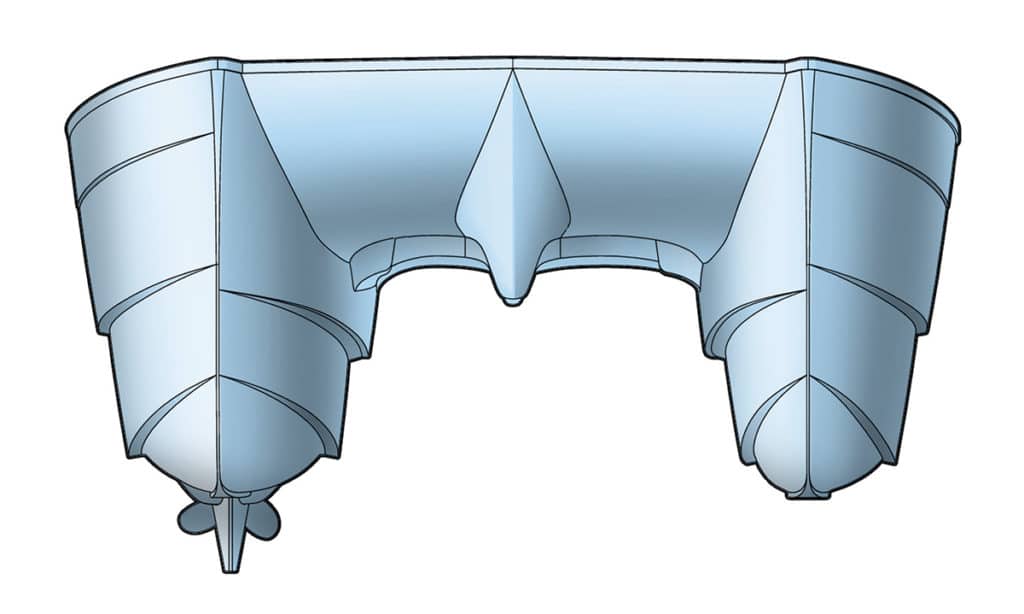
Asymmetrical Twin Hulls This unique design concept comes from the drawing board of Larry Graf, the pioneer who put power catamarans on the map here in the U.S. when he founded Glacier Bay Boats in 1987. His new company, Aspen Powerboats, employs a cat design where one hull is narrower (35 percent) than the other. His patent calls it a Power Proa, and it relies on a single engine in only the wider of the two hulls. The hull shapes, alignment and placement compensate for the offset propulsion thrust, allowing the vessel to run straight and true. With only one set of running gear in the water, inherent appendage drag is reduced by 20 percent. Combined with the efficiency of the hull designs, overall fuel efficiency of the Aspen rises to an impressive 70 percent over monohulls of comparable size. Aspen won an award for the best 30- to 39-foot catamaran in the world in 2014.
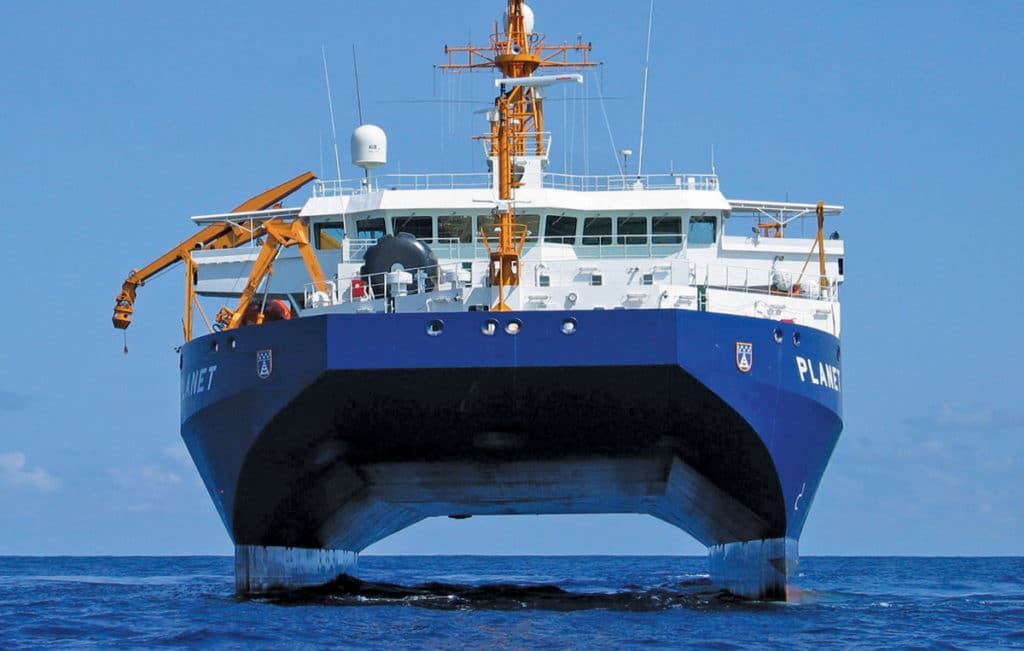
SWATH A quick glance might lead you to believe that a SWATH (small waterplane area twin hull) vessel is a catamaran. And it is but only to the extent that it has two hulls in the water with a bridge across the top. But that’s where the hulls’ similarities end.
Consider a submarine. Once under the surface, it runs stable, with no roll or pitching from wave action. All that wave energy remains on the sea surface. That basically explains how a SWATH design functions.
If you’ve ever dived under a wave at the beach to avoid being smacked by it, you know that the water beneath the wave is calmer. SWATH minimizes a vessel’s volume where the water meets the air (which is where all the wave energy is at its peak). The bulk of the vessel’s displacement and buoyancy runs beneath the waves, affording amazing stability, even in big seas and at high speeds. Please think of high speeds as a relative term here, as this is not a planing hull. What SWATH does provide, however, are a wide, stable deck and unsurpassed ride quality, especially in rough seas.
Drawbacks to SWATH designs include the fact that each hull must be custom designed. Draft runs deeper than standard hulls (especially planing hulls). The underwater “torpedoes” providing buoyancy must run parallel to the water’s surface, which requires a fairly complex trim-control system. And the underside of the deck must be far enough above the sea surface to avoid waves slamming up into it. Finally, SWATH vessels cost more to design and build than conventional hulls.
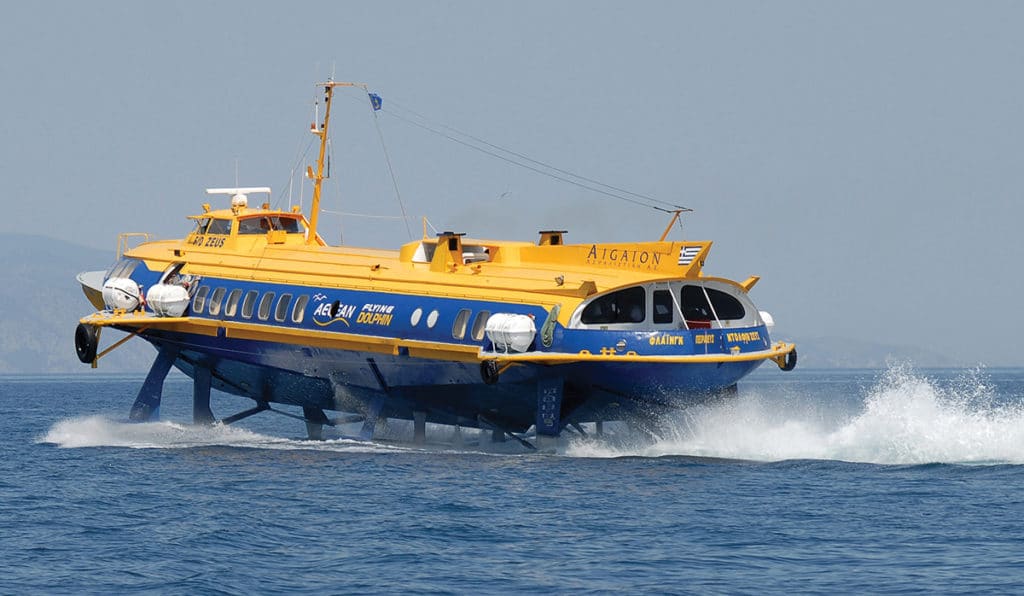
Hydrofoils Once the strict province of commercial ferries and a few high-speed military vessels, the most recent America’s Cup has spurred hydrofoil acceptance to new heights. Will it catch on with powerboats?
The hydrofoil design acts exactly like an airplane wing, providing more lift than the drag coefficient the vessel produces, thereby lifting the entire hull out of the water. Only the hydrofoils remain in the water, unaffected by surface wave action. In fact, hydrofoils cut inherent resistance to zero while the hull is out of the water. In the case of power-driven boats, you still suffer drag from the propulsion system (prop, shaft or the like).
The most significant disadvantage to this system on recreational boats is definitely the deployment of the foils. Unless you want the added draft of these struts sticking down below your hull all the time, you must be able to extend and withdraw them — a complex engineering feat. There is at least one recreational powerboat employing hydrofoils: Twin Vee builds a catamaran with foils that don’t actually lift the hulls completely out of the water. It does improve fuel economy and ride stability nonetheless. Still, boats ride more smoothly in a sea and go much faster with hydrofoils. With the dramatic acceptance of this technology in sailing, is it only a matter of time before recreational powerboats incorporate foils into their designs?
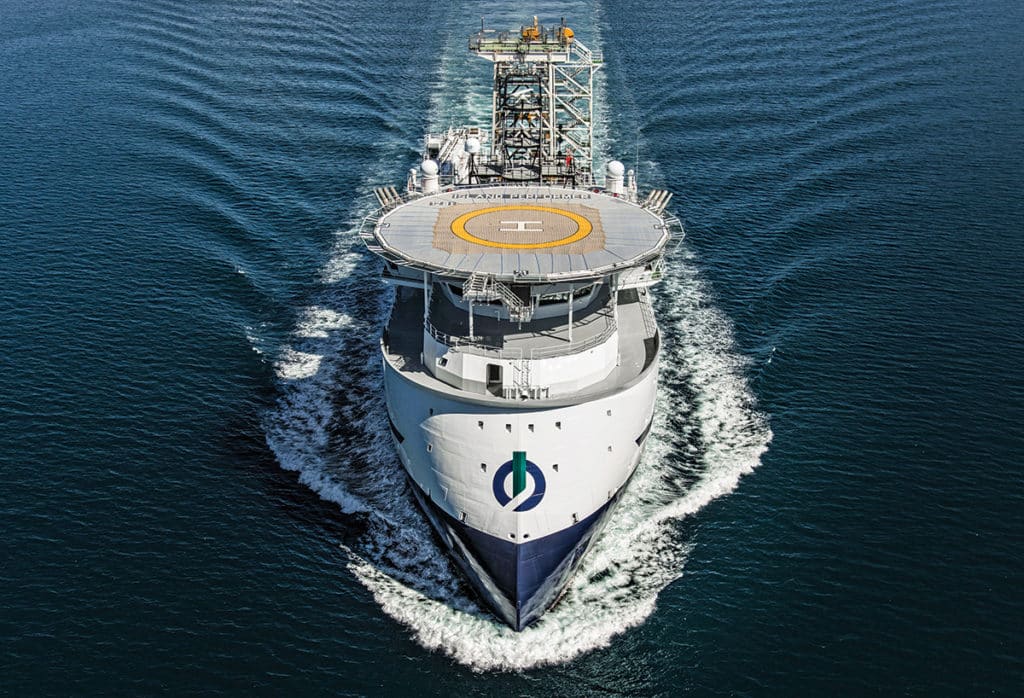
Ulstein X-Bow The Norwegian Ulstein Group has been designing offshore vessels since 1917. Presently, it has the notoriety of creating the most advanced bow design in history. The Ulstein X-Bow looks like it might be upside down, but it’s proven itself in more than 100 offshore support vessels to date. The X-Bow allows higher speeds and smoother rides in even the worst seas. Gone are the slamming and vibration that occur when the bow of a ship drops off a wave. It functions better on all points of sea, and its lower hydrodynamic drag substantially decreases fuel consumption. The X-Bow has proven so successful that Ulstein is in the process of creating an X-Stern design now.
You won’t ever see this on small recreational boats, but you can nod knowingly when someone points one out on a mega-yacht in the near future.
- More: Boats

Boat Test: 2024 Monterey Elite 30

Boat Test: 2024 Fjord 39 XP

Boat Test: 2024 Jeanneau NC 895 Sport Series 2

Hydrogen Power for Boats

2024 Alumacraft Timeline: Two Groups of Boaters x One Day Out on the Water
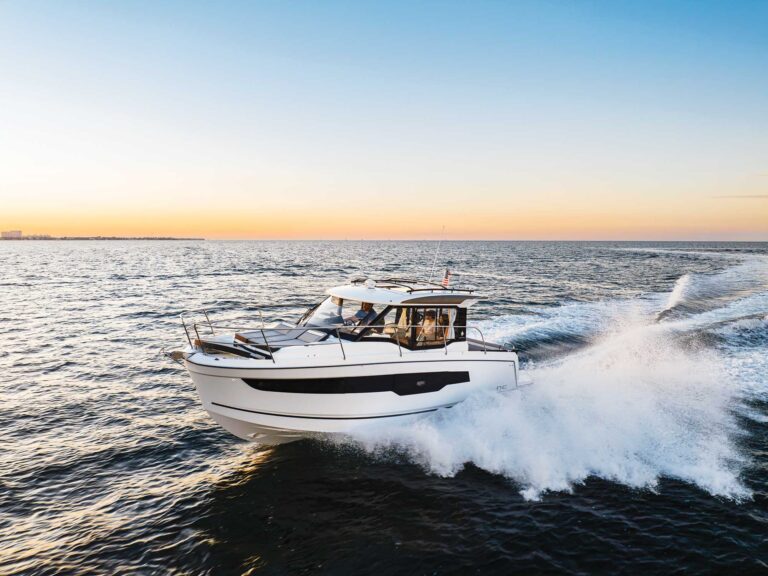
Grady-White Pulls off Its Largest Raft-up Ever in Vieques, Puerto Rico

- Digital Edition
- Customer Service
- Privacy Policy
- Terms of Use
- Cruising World
- Sailing World
- Salt Water Sportsman
- Sport Fishing
- Wakeboarding
Many products featured on this site were editorially chosen. Boating may receive financial compensation for products purchased through this site.
Copyright © 2024 Boating Firecrown . All rights reserved. Reproduction in whole or in part without permission is prohibited.
Log in or Sign up
You are using an out of date browser. It may not display this or other websites correctly. You should upgrade or use an alternative browser .
Catamaran Hull Design
Discussion in ' Multihulls ' started by redreuben , Sep 5, 2017 .
- hull shape double ended
redreuben redreuben
I have a question about hull shapes at the waterline. It seems to be a given with modern hull shapes with fatter ends that the bow and stern should clear the waterline to minimise drag. Older designs like Wharrams, Hitchhikers and Horstmans don't, is this why they are double ended ? My lot seems to be a boat no longer than 8m, therefore to carry a payload and have some reasonable cabin height I'm going to have to have a deeper hull form, will this need to be double ended to minimise drag and how do you control pitching with such a shape ? Informed comment appreciated. The boat will be used long term to coast hop to Asia hopefully.

Mr Efficiency Senior Member
What do you mean by the bow "clearing the waterline" ?
Bottom of the bow siting at or above the waterline rather than having any draft
I'm more interested with the transom.
redreuben said: ↑ Bottom of the bow siting at or above the waterline rather than having any draft Click to expand...
Ad Hoc Naval Architect
redreuben said: ↑ I have a question about hull shapes at the waterline. It seems to be a given with modern hull shapes with fatter ends that the bow and stern should clear the waterline to minimise drag.... Click to expand...
Richard Woods Woods Designs
Remember a hull is a 3D shape so you cannot take any one curve in isolation. A deep V hull has a very different rocker to a hard chine hull, yet both maybe equally efficient in flat water and at speed. In light winds and in rough water it may well be different of course. Which is the next point, you have ot design for the expected sea state, not just for best speed/efficiency. And most boats (race boats excepted) are not just used when underway. Cruising boats are lived on at anchor, for example, when good transom steps are very useful. Ferries need to dock easily, powerboats need a bigger transom to physically fit the engine, even at rest thus ignoring any stern squat etc it is all a complicated subject and you cannot take any one factor in isolation. You have to consider the boat as a whole, and as Adhoc will say, you need to design to the specific SOR. Which may lead to different hull shapes than what you might expect Richard Woods of Woods Designs www.sailingcatamarans.com
- Advertisement:
I found some good info in the hydrodynamics thread.
How to design a catamaran hull? For USV.
Book Inquiry - catamaran hull shape/profiles/ratios & hull design
RFQ - 6m catamaran hull shape
Extra Marstrom 32 and f40 catamaran hulls
Catamaran hull alignment
Catamaran hull cross-section
generating catamaran model from a given offset of single hull
Experimental Catamaran Hull Rocker
Use foam core and plywood in a catamaran hull
Where to find a small "Catamaran Hull"
- No, create an account now.
- Yes, my password is:
- Forgot your password?

Did You Know That We Offer Contract to Closing Services? Click Here to Find Out More.
Need Marine Financing? Apply Here With Our Partner, First Approval Source
- Catamaran Interviews
- Catamaran Reviews
- Buying Advice
- Selling Advice
- Woods Design Advice
- Admiral 38
- Admiral 40
- Admiral 50
- Americat 3014
- Antares 44
- Aquila 44
- Aquila 48 Power Catamaran
- Aventura 37
- Balance 442
- Balance 482
- Balance 526
- Bali 4.0
- Bali 4.1
- Bali 4.2
- Bali 4.3
- Bali 4.4
- Bali 4.5
- Bali 4.6
- Bali 4.8
- Bali 40 Catspace
- Bali 5.4
- Bali Catsmart
- Beneteau Blue II
- Broadblue 346
- Broadblue 38 Prestige
- Broadblue 385
- Broadblue 435
- Broadblue 46
- Rapier 400
- Rapier 550
- Catalac 10M
- Catalac 11M
- Catalac 12M
- Catalac 8M
- Catalac 900
- Catalac 9M
- Catana 381
- Catana 39
- Catana 401
- Catana 40S
- Catana 411
- Catana 42
- Catana 42 S
- Catana 431
- Catana 44
- Catana 471
- Catana 50
- Catana 521
- Catana 531
- Catana 55
- Catana 581
- Catana 65
- Catathai 44
- Chris White
- Chris White 48 Voyager
- Chris White 55
- Condor 40
- Contour 34
- Corsair F28 R
- De Villiers
- Dean 365
- Dean 400
- Dean 440
- Dean 500
- Dix DH550
- Dolphin 380
- Dolphin 460
- Edel 35
- Endeavour 30
- Endeavour 35 Victory
- Endeavour 36
- Endeavour 44
- Endeavour 44 TrawlerCat
- Endeavour 50 Pilothouse Trawler
- Excess 11
- Excess 15
- F-41
- Fastback 43
- Fastcat 445
- Fisher 28
- Fisher 32
- Fortuna 36 Island Spirit
- Fortuna 401 Island Spirit
- Fountaine Pajot
- FP 32 Maldives
- FP 35 Tobago
- FP 36 Mahe
- FP 37 Antigua
- FP 38 Athena
- FP 39 Fidji
- FP 40 Isla
- FP 40 Lavezzi
- FP 40 Lucia
- FP 40 MY
- FP 40 Summerland MY
- FP 41 Lipari
- FP 42 Astrea
- FP 42 Venezia
- FP 43 Belize
- FP 44 Helia
- FP 44 Orana
- FP 45 Elba
- FP 46 Bahia
- FP 46 Casamance
- FP 48 Salina
- FP 50 Saba
- FP 56 Marquises
- FP 57 Sanya
- FP 58 Ipanema
- FP 60 Eleuthera
- FP Saona 47
- Fusion 40
- Gemini 105
- Gemini 3000
- Gemini 3200
- Gemini 3400
- Gemini Freestyle 37
- Gemini Freestyle 399 Power
- Gemini Legacy 35
- Grainger 420 Mystery Cove
- Gunboat 55
- Hirondelle 7M
- HopYacht 30
- Island Packet
- Island Packet Cat 35
- Kennex 420
- Knysna 440
- Knysna 480
- Knysna 500
- Knysna 550
- Lagoon 35
- Lagoon 37 TPI
- Lagoon 380
- Lagoon 39
- Lagoon 40
- Lagoon 400
- Lagoon 410
- Lagoon 42
- Lagoon 42 TPI
- Lagoon 420
- Lagoon 421
- Lagoon 43 PC
- Lagoon 44 Power Cat
- Lagoon 440
- Lagoon 450
- Lagoon 46
- Lagoon 470
- Lagoon 50
- Lagoon 500
- Lagoon 52F
- Lagoon 55
- Lagoon 560
- Lagoon 570
- Lagoon 620
- Lagoon Seventy 8
- Lagoon Sixty 7
- Leeuwin 42
- Leopard 38
- Leopard 39
- Leopard 39 PowerCat
- Leopard 40
- Leopard 42
- Leopard 43
- Leopard 44
- Leopard 45
- Leopard 45 Classic
- Leopard 46
- Leopard 46 Lion PowerCat
- Leopard 47
- Leopard 47 PowerCat
- Leopard 48
- Leopard 50
- Leopard 51 PowerCat
- Leopard 53 PowerCat
- Leopard 58
- Lidgard 73 Executive
- Looping 50
- Maine Cat 30
- Maine Cat 38
- Maine Cat 41
- Manta 40
- Manta 42
- Matrix 450 Vision
- Matrix 760 Silhouette
- Maverick 400
- Maverick 420
- Maverick 440
- Moxie 61
- Nautitech 40
- Nautitech 40 Open
- Nautitech 44 Open
- Nautitech 442
- Nautitech 46 Open
- Nautitech 47
- Nautitech 47 Power
- Nautitech 475
- Nautitech 65
- Neel 45
- Neel 47
- Outremer 40
- Outremer 45
- Outremer 50 Standard
- Outremer 55
- Outremer 5X
- PDQ 32
- PDQ 36
- PDQ 42 Antares
- Privilege 37
- Privilege 39
- Privilege 42
- Privilege 43
- Privilege 435
- Privilege 45
- Privilege 465
- Privilege 48 Transcat
- Privilege 482
- Privilege 495
- Privilege 510
- Privilege 65
- Privilege Serie 5
- Prout 31 Quest
- Prout 33 Quest
- Prout 34 Event
- Prout 35 Snowgoose
- Prout 37 Snowgoose
- Prout 37 Snowgoose Elite
- Prout 38
- Prout 38 Manta
- Prout 39 Escale
- Prout 45
- Prout 46
- Royal Cape 45
- Royal Cape 500 Majestic
- Royal Cape 530 Majestic
- Sailcraft 30 Iroquois
- Sailcraft 32 Comanche
- Sailcraft 35 Cherokee
- Sailcraft 41 Apache
- Sailcraft 44 Apache
- Scape 39
- Wildcat 350
- Seacart 30
- Seawind 1000
- Seawind 1160
- Seawind 1200
- Seawind 1260
- Seawind 1600
- Simpson 48
- Solaris 36 Sunrise
- Solaris 36 Sunstar
- Solaris 42
- St Francis 44
- St Francis 48
- St Francis 50
- Stealth 11.8
- Sunreef 60
- Sunreef 62
- Sunreef 70
- Sunreef 74C
- Sunreef 82 DD
- Sunreef 88 DD
- Switch 51
- Switch 55
- TRT 1200
- Heavenly Twins 26
- Ocean Twins 38
- Vaan R5
- Vision 444
- Voyage 380 Maxim
- Voyage 400 Norseman
- Voyage 430 Norseman
- Voyage 440
- Voyage 450 Cabriolet
- Voyage 47 Mayotte
- Voyage 480
- Voyage 500
- Voyage 580
- Voyage 590
- Kronos 45
- Wharram 38 Tiki
- AMI 320 Renaissance
- Woods 22 Wizard
- Woods 35 Banshee
- Woods 35 Flica
- Woods 36 Scylla
- Woods 36 Vardo
- Woods 38 Transit
- Woods 40 Meander
- Xquisite X5
- Xquisite X5+
Catamaran Construction – Hulls, Laminates, and Composites
- Post author By BJ Porter
- Post date October 15, 2020
- 4 Comments on Catamaran Construction – Hulls, Laminates, and Composites

It’s a given that catamarans are more sensitive to weight and loading than monohulls. Catamaran builders strive to build the lightest boats they can without sacrificing strength and stiffness, and have adapted new building techniques and materials to meet this target. Cutting weight allows more passengers and gear without sacrificing performance.
And the marketing materials reflect it–they load every review and website with polysyllabic technical jargon describing the design and production choices each builder made to deliver the best boat they can.

But when you’re reading a brochure and you come across phrases like “ hand laid bidirectional GRP ” or “ vacuumed bagged e-glass with vinylester resin over a Divinycell core ” do you know what that really means?
All modern production catamarans are made with “FRP” construction (for Fiber Reinforced Polymer). Composites aren’t new–it’s just using materials together to strengthen the whole assembly. Straw was added to bricks centuries ago, and steel reinforced concrete is a staple of construction over the last century. For boats, it’s the use of stranded fibers and cured resins which make FRP different.
The term “FRP” doesn’t get into the technical detail of which fibers and which plastics, and how they’re put together to build your hull. There’s a wide variety of fiber types which can be stranded, woven, chopped or sprayed in a varied of patterns then combined with several types of resins to make hulls with different characteristics.
Some FRP techniques produce lighter, stronger shapes, while others are quicker to build and less expensive to produce. The choice of technique is a function of many factors, from the number of hulls and parts to be built, the type of parts, the budget for the project, and many design specific requirements for weight and strength.
1. FRP Basics
The principle behind all FRP construction is the same – you lay our fibers in the shape you need, then saturate them with resin, removing all the air and voids you can. Resin is left to cure, then the piece is ready to finish and use.

The reality is more complex, since building a boat isn’t like making a flat board or a simple door. You’ve got a complex shape with a designed set of curves to build. “Tooling” is the set of shapes to make the boat parts; molds to cover with fiberglass to get the right shapes.
That’s what makes FRP so effective – you can make almost anything out of it. But to do so requires a lot of choices about what you need for the project at hand.
There isn’t a “best” all around material or technique choice for all jobs, and sometimes a lower cost technique or easier to work with material may be the better solution to the problem.
A. Fiber types
Fiber choices in the last few decades have expanded past the glass fibers used in the first mass produced boats in the 1960s. FRP construction wasn’t new even then, they built the first composite boats using modern fiberglass in the 1940s.
The major fibers used in marine construction fall into three categories – glass, aramids, and carbon. The primary differences are in the strength to weight ratios of the fibers, durability, elasticity, and cost. Some construction may use blends of fiber types to combine performance characteristics.
Glass – the most common material still, because of its low cost and versatility. The most common variety used in GRP (Glass Reinforced Polymer) is “E-glass” which refers to its strand size and mineral content. Other grades have different and sometimes better mechanical properties, but may be more expensive and less appropriate for boat building use. Fiber sizes run 10 to 25 microns for E-glass, though other grades may be smaller.

Brands like Leopard, Lagoon, and most higher production volume builders use E-glass.
Aramids – this includes brand names like Kevlar, Technora and Twaron. They have higher tensile strength than E-glass, and resistant abrasion and punctures. Kevlar is a common choice for bullet proof body armor, and can built a tough, lightweight hull. The materials can be difficult to work with, as it is very tough to cut the cloth. It is often blended with carbon fiber or other materials – Catana is known for using Twaron blends in hull construction.

Carbon – the ultimate in lightweight, strong construction material. Carbon fiber is the most expensive fiber, and is available in a variety of weights, grades and strengths. Fibers are smaller than glass – down to 5 Micron.
The lightest, most expensive hulls are made from carbon, but a catamaran builder may use carbon in places other than the hull to add strength and stiffness. Carbon boards, rudders, and reinforcing structures can enhance performance without driving the price of the boat beyond reach. Carbon is the fiber of choice for many custom builds, racing cats, and Gunboat.
B. Mats, Strands, Roving, Direction, and Weights
Fibers are woven into matting and cloth for construction. Depending on the application, different weights of cloth and cloth patterns and weaves may be more appropriate for the job.
Cloth weight refers to the weight per square yard (or meter) of the cloth. A square yard of nine ounce cloth weighs nine ounces. The heavier the cloth, the stronger it is in a laminate.
Fibers carry loads along their length, so cloth weaves have directionality to their strength. Most builders use several layers of cloth with different orientations to give good universal strength to hulls. Specific FRP applications with strict load-path requirements may have more unidirectional fiber layering – for example, a chainplate manufactured from carbon fiber may use unidirectional fiber.
Cloth – fiberglass cloth is commonly used on outer layers of composites. Cloth may have unidirectional or bidirectional strength. Bidirectional cloths have maximum load strengths in two perpendicular directions. Variations on weaves like a modified twill allow a more flexible cloth for better shaping around complex molds.
Mat – is omnidirectional strands of fiber compressed into a cloth. This is often held together with a resin soluble glue, which makes mat great at conforming to mold shapes without folding and bunching as it collapses when wetted. Because the strands do not align, fiber strength is the same in all directions.

Woven Roving – a heavier cloth made from larger bundles of strands. Woven roving allows for quicker buildup of material and strand weight.
Most FRP layups include multiple layers of different cloth and mat. Finished layers may be finer cloth over courser cloth, over woven roving and mat.
Three primary resins are in common use in marine construction – polyester , vinylester , and epoxy . All resins have materials safety concerns and require care in their use and handling.
Polyester is the least expensive and requires breathing protection because of the VOC emission (Volatile Organic Compounds…nasty, smelly fumes). It doesn’t have good bonding/gluing capability, and should only be used with glass fibers for structural building. Some polyester resins are referred to as “isophthalic” resins.
Vinylester is chemically similar to a hybrid of polyester and epoxy, and performs best with fiberglass. It shouldn’t be used in high strength applications with carbon or aramid fibers. It has some adhesive qualities which polyester lacks, it shrinks less during curing, and has better impact resistance.
The added strength of vinylester coupled with increased water resistance makes it an attractive option for many catamaran builders. It costs less than epoxy, but still has better performance than polyester.
Epoxy is the most expensive, but is three times the strength of the others. It offers the best adhesion and the only resin for building structural elements with carbon and aramid. It resists water intrusion better than the other resins, resists blisters, emits no VOCs, and shrinks less. The major drawback is it is more brittle if it takes an impact.
While epoxy is “the best” in terms of strength and ease of building, there are many applications where other resins are appropriate. Budget is a big driver – a boat made from E-Glass doesn’t need epoxy resin, and considerable cost savings to meet a construction price target may drive the choice.
They can build quality boats from all material combinations, but price and performance will drive materials choices to keep some boats more affordable.
2. Cored Construction
What’s the best way to make fiberglass strong? To a point, you can make it thicker. As it gets thicker, it gets heavier. A hollow shape can take more compressive load than a solid one of the same weight, and the same principle applies to fiberglass construction.
Consider an I-Beam used in building construction. It has the same strength (or more) as a solid rectangular beam of similar mass. The compressive load on the beam is supported by the outside edges of the material, the metal in the middle doesn’t contribute much to the strength. So we can remove metal to get the “I” shape while still keeping those sides rigid, making a lighter girder with less material.
The same principle applies to cored construction with fiberglass. Making a sandwich of two layers of fiberglass with a light core between them allows for the greater strength with weight savings.
There are drawbacks – the biggest risk is damage which breaks the skin, which can let water into the core. Earlier cored construction used materials prone to saturation and rot if they got wet. Some builders opt to do cored construction above the waterline and solid below to minimize some of these risks.
But the advantages in weight savings and increased stiffness offset the drawbacks, and there may be a few other side effects like sound and temperature insulation. Like resins and fibers, core materials offer distinct advantages, disadvantages and price points.
Most builders have adopted a hybrid approach, building solid hulls below the waterline, and cored hulls and decks above. This gives a balance of weight and safety.
A. Balsa Core
Balsa is light and inexpensive. The first cored construction used balsa, but it has the disadvantage of being wood. As a natural material, if it gets wet it can rot and break down. Builders use “end grain” balsa – shorter cross cut sections – to prevent wicking of water if there is an intrusion.

B. Foam Core
Closed cell foam cores give good strength to weight savings while minimizing water intrusion. If you get water in the core, it won’t spread very far. Divinycell is a popular PVC foam core, though there are several choices with different densities and compressive strengths.

Some foam cores are not suitable for heat treatment, but infused or vacuum bagged boats like the Outremer and PDQ do well with it.
C. Honeycomb
Honeycomb cores are often the most expensive, but also give some of the best strength to weight ratios. Honeycombed cells made from resin cured aramid papers are some of the best, but also among the most costly. They offer good stiffness, but can be hard to shape. Aluminum and other resin-infused papers are other core materials builders can choose from.
3. Construction and Resin
When building a hull, there are optimal ratios of fiber to resin saturation for target strength and weight. Too little resin and you may not have enough strength (or worse, voids and gaps), and too much, and you’re just adding weight without adding strength. Resins are also a significant material cost in building the boat, so over application not only increases weight but adds cost.

There are many ways to assemble the cores, fibers and resins to build a finished laminate hull – we’re addressing the most common in boat building. Each approach has strengths and limitations, and an impact on the bottom-line cost to build the boat. Any voids or air pockets in the laminate can be disastrous; these techniques have been developed to increase saturation and reduce the risk of voids.
A. Hand Layup / Open Molding
As the name implies, this is the application of resin by hand to cloth as it’s laid into a mold. Wetting is done with a brush, and the laminate is rolled out to remove any air pockets and voids. This is the simplest way to lay up fiberglass, but also the least precise and consistent and will use the most resin.
Skilled craftsmen have built some of the finest vessels in the world this way. Though it’s more popular with monohulls, which are less sensitive to weight, many catamarans built with hand layups on open molds are still out cruising and performing well.
B. Spraying
Using chopped-strand fiber mixed with resin, a “chopper gun” can spray the mixture into a mold to lay down the composite. A consistent thickness can be difficult, but this is a low cost construction technique which makes a very resin-rich laminate. Using sprayed fibers gives lower strength in all directions compared to meticulously laid down mat and bi-directional cloth. But it is a quick technique popular with mass produced, smaller boats.
It is an excellent technique for parts with complex geometry where weight is not an issue, but you will not see it often in catamaran construction. It’s heavy with resin without any resultant increase in strength.
C. Vacuum Bagging (Wet layup)
When an open molded component has been laid up and wetted with resin, vacuum bagging takes the process a step further. After the wetting is complete, air tight plastic bagging is secured around the wetted area, and the air is pumped out of the bag. The vacuum pulls excess resin out and collapses air pockets.

The goal is to get thorough wetting and produce as strong a laminate as possible without excess resin. Knysa and Leopard are two builders that use vacuum bagging on their hulls to reduce weight.
D. Resin Infusion
For resin infusion the cloth, matting and core is laid in place dry, then sealed in an air-tight bag. A vacuum pump attaches to one side of the bag, and on the other a feed for resin. The vacuum sucks the air out of the dry cloth stack, then pulls the resin through the stack, infusing and wetting it.
Resin infusion, when done right, gives the lightest, strongest laminates with no voids and the minimum resin weight for maximum strength. SCRIMP is a variant of the resin infusion process used by some builders, including TPI which build many early Lagoon cats.
E. Pre-preg
Using pre-preg (for “Pre Impregnated”) cloth for your laminating gets rid of the resin bucket. They manufacture cloth with a partially catalyzed resin pressed into it, then it’s chilled or frozen to stop the curing process. There is no need for seperately mixed resins, and there’s no worry your resin might “go off” and harden before you’re done wetting the cloth. Instead, the cloth is assembled, vacuumed, then heated to kick off the curing process.
There are both advantages and disadvantages to using pre-preg for your laminate work. The big disadvantage is the cost; it is most expensive material to use. You also need to chill and store the cloth until you need it, though some can be at room temperature for a couple of weeks without kicking off. And you need an oven which requires some clever tricks if you’re building a forty or fifty foot boat.
But the strength to weight ratio will always be perfect. High tech honeycomb cores are best suited to pre-preg lamination, and without racing against resin cure times, you can ensure perfect cloth placement and precise layout in the build process.
The primary use for pre-preg in boating is high performance race boats. With catamarans, pre-preg may be used high load parts, like Gunboat does for foils and rudders.
4. Industry Examples
Across the catamaran building industry you’ll find almost all the above techniques and materials used, though some are less common. You aren’t likely to find chopped strand sprayed layups in ocean going cats, and hand layups can lead to heavier hulls than weight sensitive catamaran designers prefer. Most manufacturers have moved to vacuum bagging or resin infusion, with a few of the highest end boats using pre-preg for key components.
Built by Robertson & Caine in South Africa, the hull material is vacuum bagged, end-grain balsa-cored E-glass with polyester.
Hand laid, bagged vinylester over an Airex foam core in the hulls.
Earlier Prout catamarans like the Snowgoose 34 featured hand laid solid FRP hulls and decks. Over time they switched to foam or balsa cores for decks and above the waterline.
Older PDQ boats were made from vacuum bagged vinylester – solid below the waterline and cored with CoreCell foam above the waterline and in decks. Newer PDQ models switched to epoxy resin.
All glass is vacuum bagged. Below the waterline is solid E-glass and vinylester. The rest is unidirectional, bidirectional, and triaxial cloths over a Nida-Core polypropylene honeycomb core with isophthalic and vinylester resins.
The Gemini cats are built with a solid hand layup of woven roving and fiberglass mat and polyester resin. Decks are cored with end grain balsa. The Gemini 3200 introduced vinylester resin into the layup to prevent blistering.
Older Lagoons were SCRIMP infused vinylester with and end grain balsa core above the waterline and in the decks.
Newer Lagoon catamarans use polyester and vinylester resins, also infused with balsa cores above the waterline and solid below.
With a carbon fiber inner skin, Catana also uses Twaron aramid fibers in the sandwiched hull over a foam core.
Fontaine Pajot
Primary hull construction is resin-infused vinylester with a balsa cored hull and deck.
Beneath the waterline, Outremer uses a single layer, solid vinylester laminate for safety. The hulls and deck are vinylester with a Divinycell foam core. They stiffen certain components with carbon for rigidity and durability.
Gunboat hulls are epoxy infused carbon fiber with a Nomex honeycomb core. They build dagger boards and other high load components with pre-preg carbon.
- Tags Buying Advice

By BJ Porter
Owner of Hallberg Rassy 53; world explorer.
4 replies on “Catamaran Construction – Hulls, Laminates, and Composites”
Excelent. Thank you for this I learned allot. Johan
Very straight forward information. Thankyou for doing this.
Damn…What an Amazingly Informative Article. *Cheers*
Outremer publish on their website that they use polyester. Not vinyl ester as you have stated.
Leave a Reply Cancel reply
Your email address will not be published. Required fields are marked *
Save my name, email, and website in this browser for the next time I comment.

The global authority in superyachting
- NEWSLETTERS
- Yachts Home
- The Superyacht Directory
- Yacht Reports
- Brokerage News
- The largest yachts in the world
- The Register
- Yacht Advice
- Yacht Design
- 12m to 24m yachts
- Monaco Yacht Show
- Builder Directory
- Designer Directory
- Interior Design Directory
- Naval Architect Directory
- Yachts for sale home
- Motor yachts
- Sailing yachts
- Explorer yachts
- Classic yachts
- Sale Broker Directory
- Charter Home
- Yachts for Charter
- Charter Destinations
- Charter Broker Directory
- Destinations Home
- Mediterranean
- South Pacific
- Rest of the World
- Boat Life Home
- Owners' Experiences
- Conservation and Philanthropy
- Interiors Suppliers
- Owners' Club
- Captains' Club
- BOAT Showcase
- Boat Presents
- Events Home
- World Superyacht Awards
- Superyacht Design Festival
- Design and Innovation Awards
- Young Designer of the Year Award
- Artistry and Craft Awards
- Explorer Yachts Summit
- Ocean Talks
- The Ocean Awards
- BOAT Connect
- Between the bays
- Golf Invitational
- BOATPro Home
- Superyacht Insight
- Global Order Book
- Premium Content
- Product Features
- Testimonials
- Pricing Plan
- Tenders & Equipment

Rossinavi delivers first 43m hybrid-electric catamaran Seawolf X
Related articles, superyacht directory.
Rossinavi has delivered its "most innovative project" to date, the 42.8-metre hybrid-electric catamaran named Seawolf X . She has departed the shipyard's facilities in Viareggio, Italy and is now anchored near the Greek island of Tinos according to BOATPro .
Exterior design is by Fulvio De Simoni Yacht Design , marking the first project presented by the pair since the 49.1-metre Aurora in 2017. It also marks Rossinavi's first multihull project.
A key characteristic of the model is her three "performance scenarios". On one-day trips, Seawolf X can cruise in full-electric mode for 100 per cent of the time; on multi-day trips, she can cruise for 90 per cent; and on transatlantic trips, she can still cruise in electric mode for 80 per cent of the time. When the catamaran is moored, a "hibernation mode" activates for reduced consumption – with the energy generated able to be given back to the quay or to a private property. She can recharge at the shore in five hours and supplies enough energy to charge up an entire villa.
Rossinavi has also developed an onboard artificial intelligence system, called Rossinavi AI, to analyse the operation of the vessel, predict the needs of guests and communicate with the crew on "lower-impact behaviours" and "conscious cruising". The AI can also monitor the battery pack to keep it in a range of 20 to 80 per cent.
Her exterior is low-profiled and reminiscent of a sports car, with Fulvio De Simoni Yacht Design seeking "to liberate their minds from preconceptions" around catamaran design. The team also integrated solar panels into Seawolf X and addressed hull efficiency by developing "lightweight solutions", including an anchor installation that meets weight standards while enhancing aesthetics.
New York-based design firm Meyer Davis have created an interior that "complements the cutting-edge yacht to bring relaxed luxury and sustainable design to its forefront," the shipyard said. The decor takes inspiration from nature, in particular the sun, the sea and sand.
Leisure highlights include a convivial cockpit centred around a pool, an expansive sundeck with sunbathing and living spaces, and a bow area that features a hidden pool and convertible home theatre. Accommodation is for up to 10 guests in four cabins located in the hulls.
"After years of study and construction, it is now a source of satisfaction and pride for us to witness the launch of project Sea Cat, now Seawolf X , the first hybrid-electric multihull vessel," said Federico Rossi, COO of Rossinavi at the time. "This yacht showcases remarkable technological innovations in both power management and propulsion technologies, marking the beginning of a new chapter in next-generation vessels."
Seawolf X also carries the BlUE label, the shipyard' "sustainable" design philosophy established in 2022. Inspired by phytoplankton, the BlUE fleet absorbs sunlight during the day and utilises photovoltaic technology to convert it into energy. This energy is stored in advanced batteries and released at night, creating a bioluminescent effect "akin to glowing plankton".
Seawolf X is available for charter with Cecil Wright from €380,000 per week.
Sign up to BOAT Briefing email
Latest news, brokerage headlines and yacht exclusives, every weekday
By signing up for BOAT newsletters, you agree to our Terms of Use and our Privacy Policy .
More about this yacht
Similar yachts for sale, more stories, most popular, from our partners, sponsored listings.

- Ultimate Drives
- Ultimate Gift Guide
- Editor's Picks
- Robb Recommends
- DESTINATIONS
- HOME DESIGN
- REAL ESTATE
This Speedy 70-Foot Power Catamaran Is Designed To Cut Through Rough Waters
Howard walker.
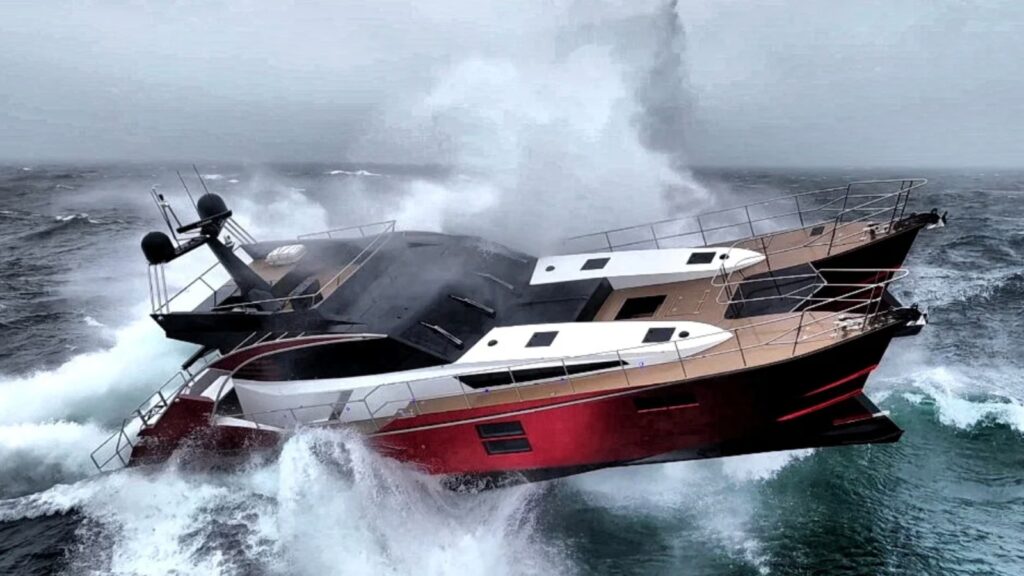
Back in April, Storm Kathleen slammed into the west coast of Ireland as a fearsome Force 10 gale, packing 113 km/hr winds and 15-foot waves. While locals sandbagged their homes and prepared for the worst, Frank Kowalski decided it was a swell day for a boat ride.
As owner of Safehaven Marine in County Cork, he’d just launched his brand-new, 70-foot T-2000 Voyager all-weather power catamaran. What Kathleen offered was a chance to put the new super-cat through its paces.
“We knew from scale-model tests that she should be able to tackle waves of more than 65 feet high,” Kowalski tells Robb Report . “But you never know until you’re out there. In the height of the storm, she just shrugged off the waves and weather and performed flawlessly.”
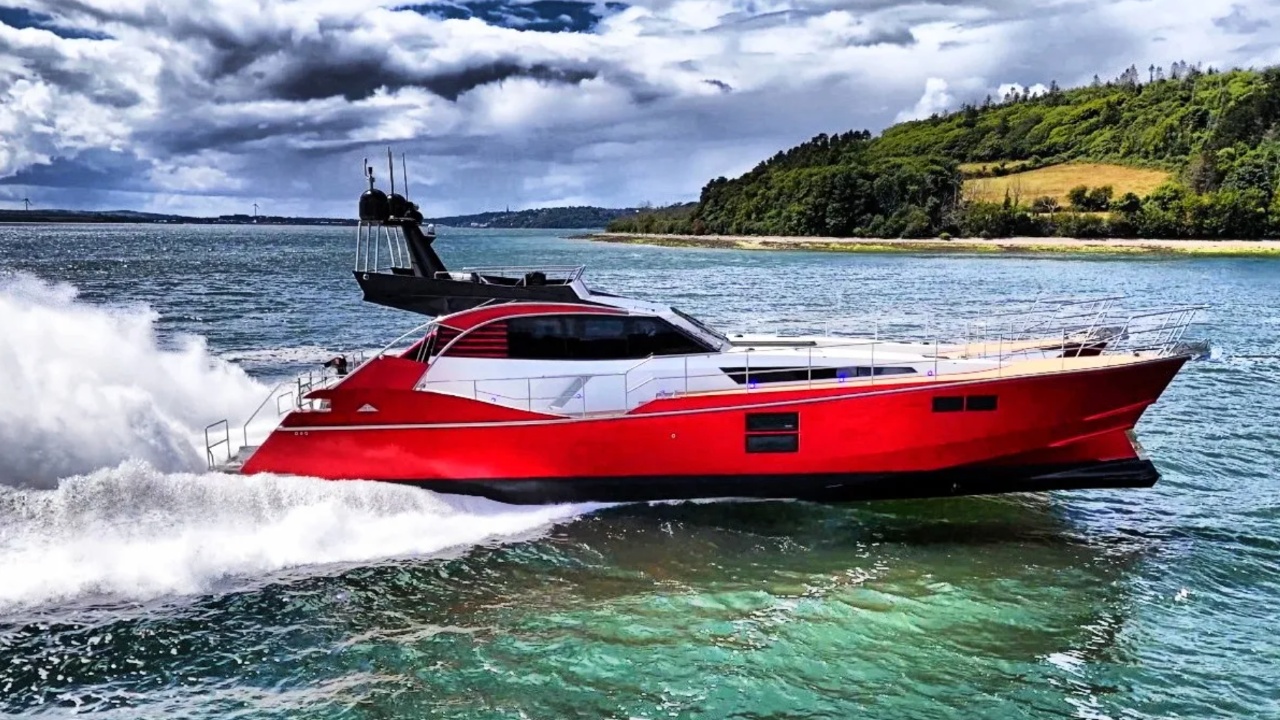
Evolved from Safehaven’s 75-foot XVS20 monohull launched in 2018, Kowalski used his expertise in building commercial, work-boat power catamarans to design the twin-hulled T-2000 Voyager to offer speed with stability.
“The stability in beam seas is what’s key here,” he says. “While we were out recently in a Force 8 with 40-plus knot winds and 12-foot seas, we were able to stop and leave the boat to drift while we retrieved a drone. It just took the waves on the beam with ease. In a monohull, it would have been rolling so badly you couldn’t have stood on the deck.”
Then there’s the sheer velocity that comes with twin, scalpel-thin hulls slicing through waves. With the T-2000’s pair of 1,550 hp MAN V12 diesels driving France Helices SD5 surface drives, the Safehaven can hit a top speed of 91.73 km/hr.
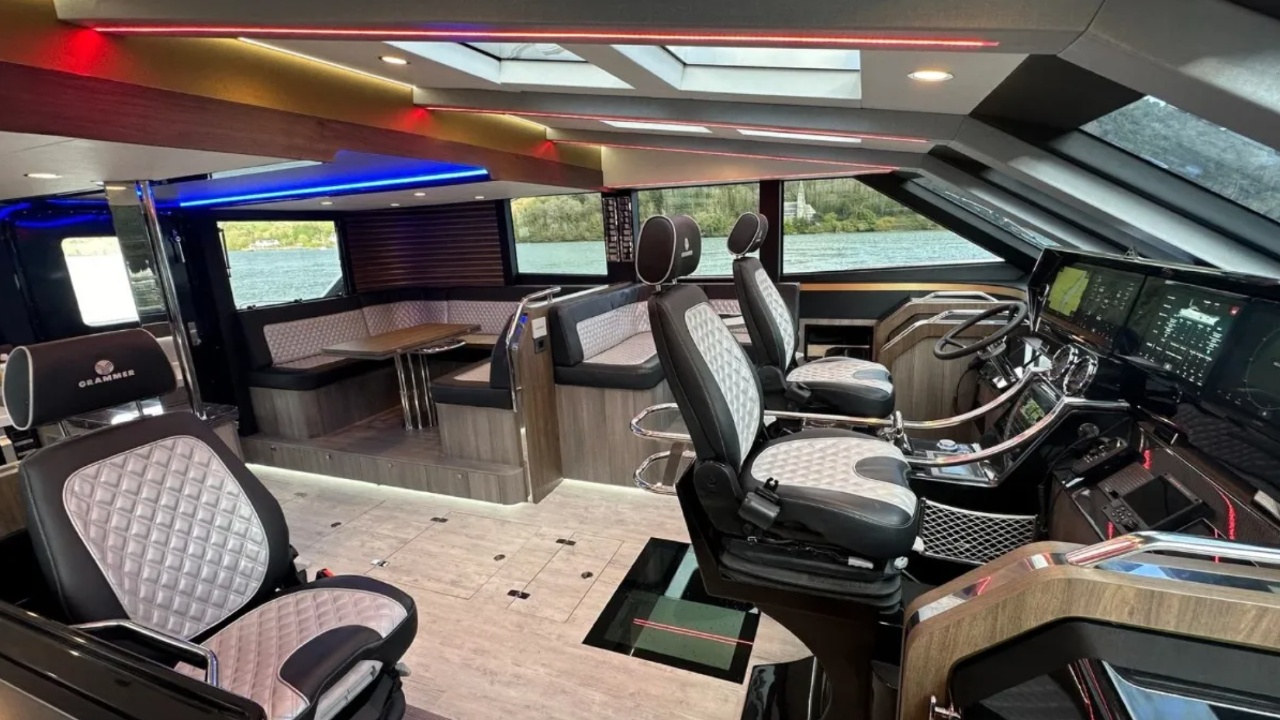
“It’s just the most amazing sight, standing on the stern, watching these huge roostertails behind,” Kowalski adds. “We’ve also incorporated retracting swim platforms so you can see the props spinning on the surface, plus valved exhausts that switch between silenced and straight-through. The noise from those V12s is sensational.”
While Safehaven has been building its Wildcat range of 40-, 53-, and 60-foot power cats for everything from oil-rig support, crew transfer, and even as a military cruiser for Britain’s Royal Navy, they were always pure, no-frills work boats. With this new T-2000, Kowalski is looking to appeal to private buyers searching for something a little different.
His hull No. 1 demonstrator boat has all-diamond-quilted marine leather, well-finished cabinetry, colored LED lighting, and below-deck accommodations for six in three cabins. Hull No. 2—already sold and due for completion in the next 18 months—will up the luxury factor.
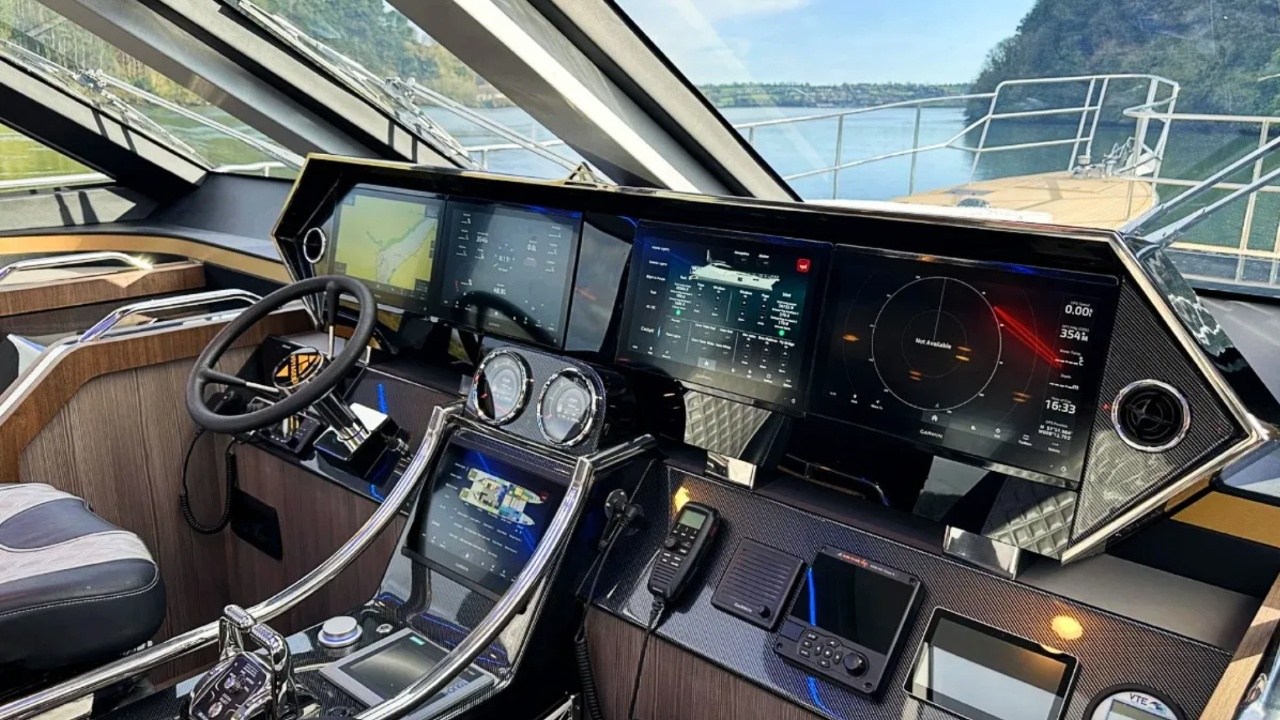
“It’s going to a client in the Middle East who plans to use it for just himself and his wife,” says Kowalski. The client has specified a full-width owner’s suite with a central, king-size bed and oversized his-and-hers bathrooms and closets in each hull. “He also wants to go fast—very fast,” Kowalski continues. “So we’ll install twin 2,000 hp MAN V12s, again with surface drives, and a central hydrofoil to reduce drag. The plan is for it to hit a top speed in excess of 69 mph.”
The new T-2000 is also designed to go the distance. With the 2,900-gallon tanks, it has a range of more than 1,000 nautical miles at 34.5 mph, and 1,700 nautical miles at 18 mph. Throttle back to 12 mph and range increases to 3,000-plus nautical miles.
Much of this is down to the yacht’s symmetrical, semi-wave-piercing hulls, made of a carbon-fiber-composite construction, with inverted lower bow sections and a double-chine arrangement that projects spray clear of the boat. The hydrofoil in mid position also means that, at speed in calmish seas, the T-2000 rides with half its hull length out of the water.
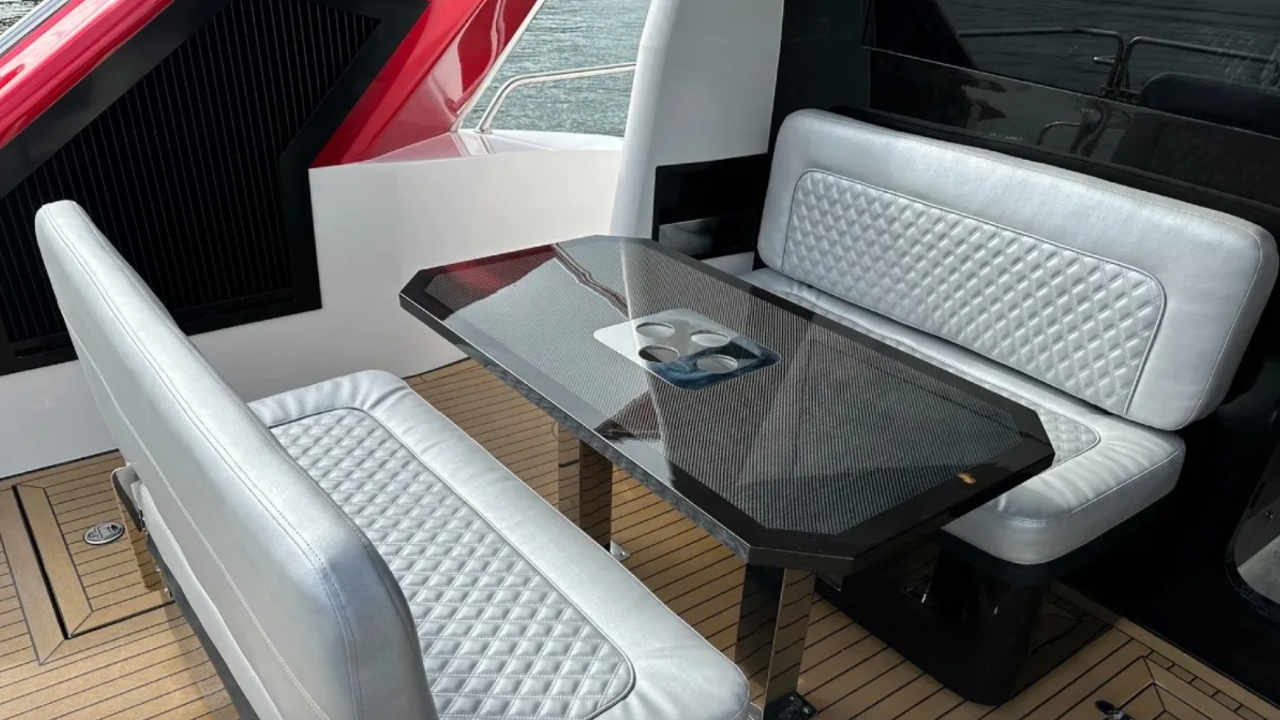
To eliminate waves slamming into the bridge deck windshield, Kowalski moved the pilothouse farther back. It also makes for a sleeker profile, giving the T-2000 the look of a single-hull sportsyacht.
As for creature comforts, the main, open-plan salon features an L-shaped Corian-topped galley, with a U-shaped dinette opposite. To enjoy the action, there are bucket-style, shock-absorbing seats for the captain and copilot, a wraparound sofa on the port side, and a single bucket seat to starboard.
The entire helm area gets flooded with light courtesy of the four-panel, angled windshield and quartet of fixed skylights above. To see the boat’s hydrofoil in action, the bridge has a glass panel in the floor that’s also designed for viewing marine life below at night. Most of the windows have half-inch-thick toughened panels to shrug off cascading water.
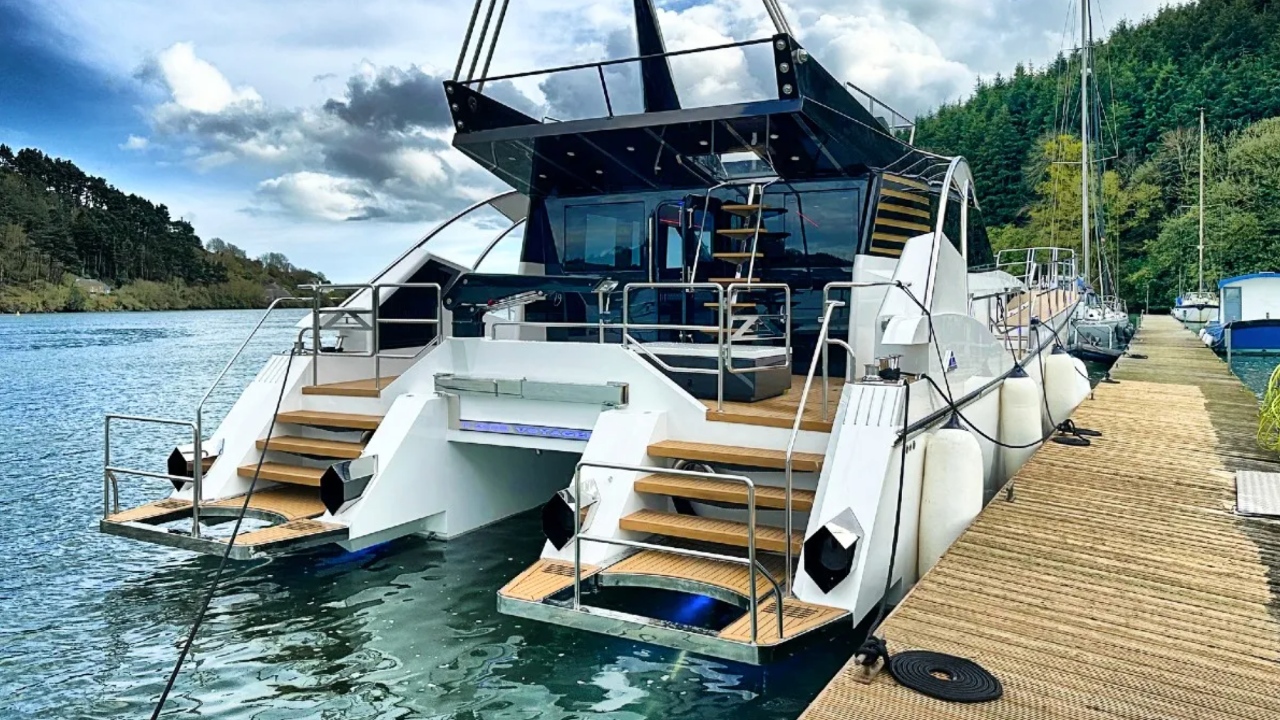
In finer weather than typically found on coastal Ireland, the T-2000 has a small flybridge with a helm station and sun-lounge area up top, plus a covered stern cockpit with sofas and table for alfresco dining.
This storm-tested, metallic-red demonstrator is available for around $3.35 million (RM14.55 million)
Safehaven Marine
Previously published on Robb Report USA
Most Popular

People | Wheels
Power Individuals: Anas Zawawi Khalid Of Rolls-Royce Motor Cars Kuala Lumpur
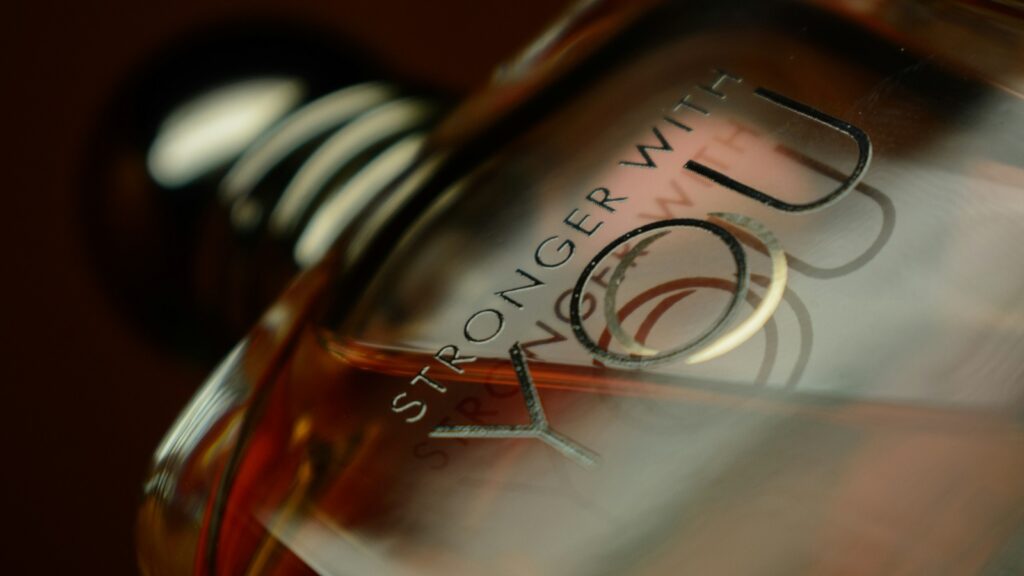
From Diptyque To Tom Ford, You Should Own These 15 Freshest Summer Colognes For Men
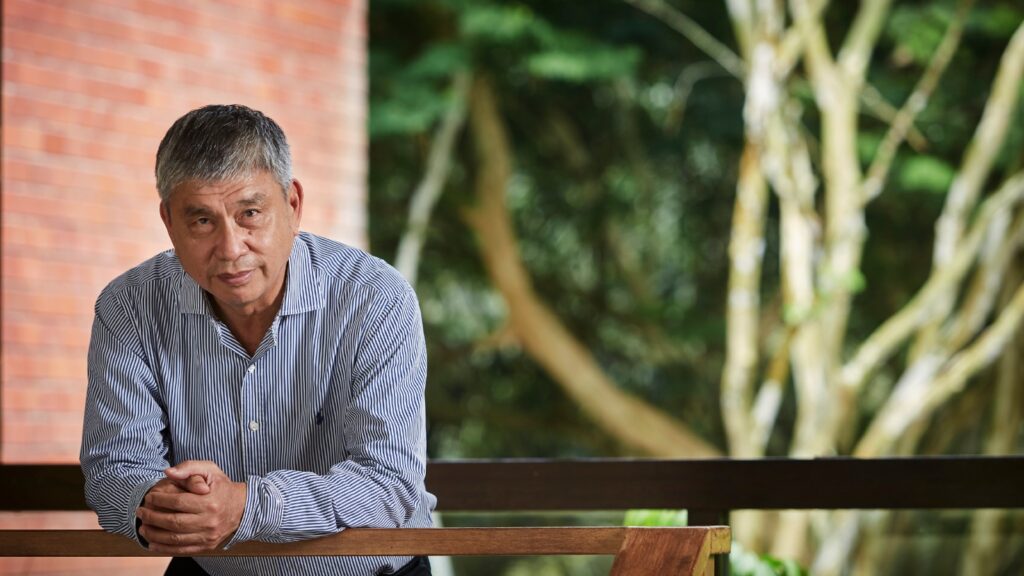
Mangala Estate Boutique Resort’s Founder Dato’ Franky Chua on His Love of Nature & Creating His Own Ecosystem

12 Unique Mooncake Gift Boxes And Mid-Autumn Festival Experiences This 2024

Fashion | Timepiece
Urwerk Has A Handsome Tribute To 'Star Trek' And Spock
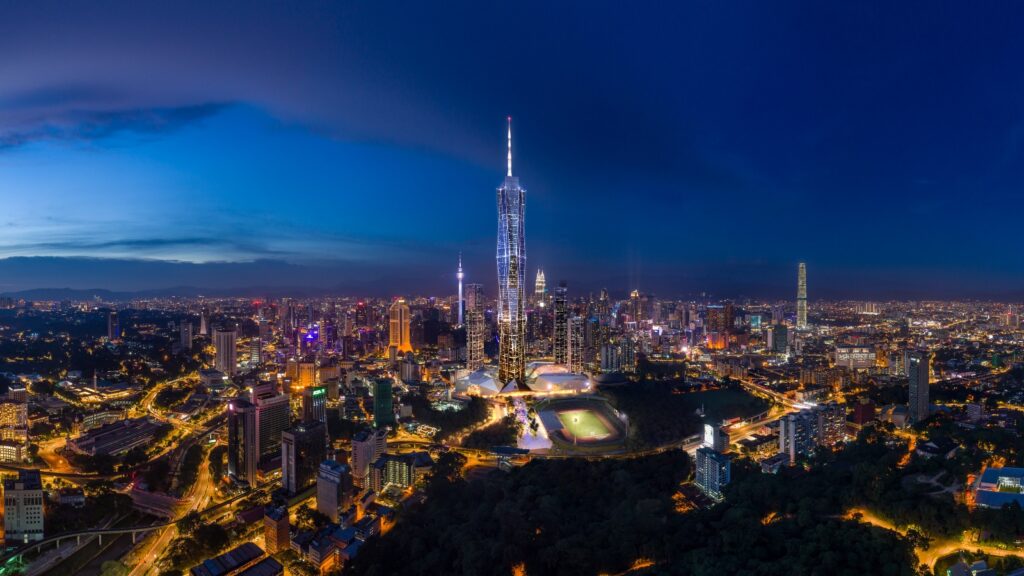
Park Hyatt KL Is Set To Open On The Highest Floors Of Merdeka 118
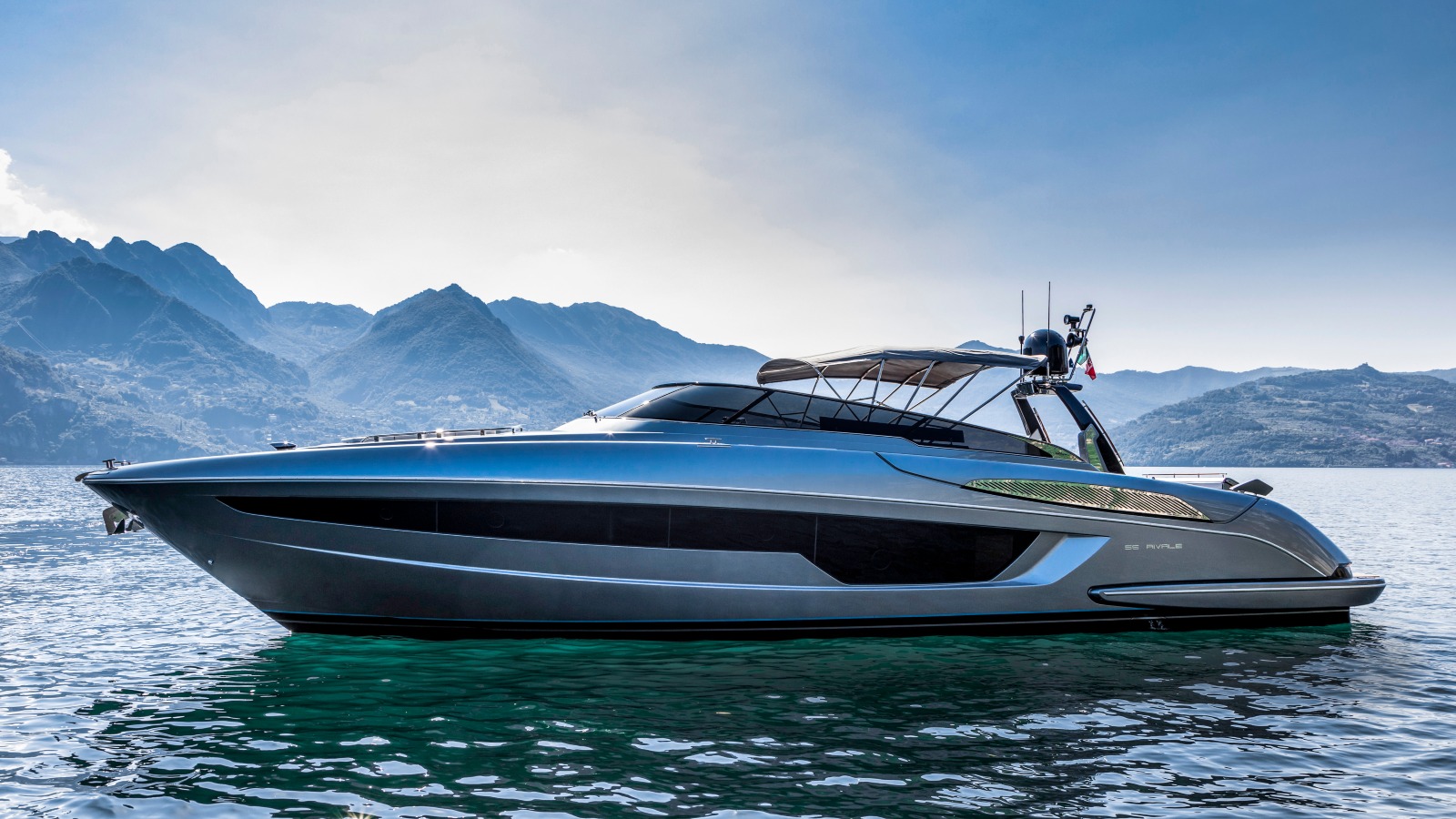
Sign up for our Newsletters
Stay up to date with our latest series

- Privacy Policy
- Terms & Conditions
- Distribution
Published by Robb Report Malaysia under license from Robb Report Media, LLC, a subsidiary of Penske Media Corporation.
- Destinations
- Home Design
- Real Estate
- Editor’s Picks
Yekaterinburg
| and the from | |
| Show map of Russia Show map of Sverdlovsk Oblast | |
| Coordinates: 60°36′46″E / 56.83556°N 60.61278°E / 56.83556; 60.61278 | |
| Country | |
| Founded | 18 November 1723 |
| City status since | 1781 |
| Government | |
| • Body | |
| • Head | Alexey Orlov |
| Area | |
| • Total | 1,111 km (429 sq mi) |
| Elevation | 237 m (778 ft) |
| Population ( Census) | |
| • Total | 1,349,772 |
| • Estimate | 1,536,183 |
| • Rank | in 2010 |
| • Density | 1,200/km (3,100/sq mi) |
| • Subordinated to | of Yekaterinburg |
| • of | , City of Yekaterinburg |
| • Urban okrug | Yekaterinburg Urban Okrug |
| • of | Yekaterinburg Urban Okrug |
| ( ) | |
| +7 343 | |
| ID | 65701000001 |
| City Day | 3rd Saturday of August |
| Website | |
Yekaterinburg [lower-alpha 1] is a city and the administrative centre of Sverdlovsk Oblast and the Ural Federal District , Russia. The city is located on the Iset River between the Volga-Ural region and Siberia , with a population of roughly 1.5 million residents, [14] up to 2.2 million residents in the urban agglomeration. Yekaterinburg is the fourth-largest city in Russia, the largest city in the Ural Federal District, and one of Russia's main cultural and industrial centres. Yekaterinburg has been dubbed the "Third capital of Russia", as it is ranked third by the size of its economy, culture, transportation and tourism. [15] [16] [17] [18]
Imperial era
Contemporary era, demographics, administrative districts, administration, living costs and the labor market, finance and business, retail and services, transportation, public transit, media and telecommunications, life and culture, architecture, international relations, bric summit, twin towns – sister cities, notable people, bibliography, external links.
Yekaterinburg was founded on 18 November 1723 and named after the Orthodox name of Catherine I (born Marta Helena Skowrońska), the Polish wife of Russian Emperor Peter the Great . The city served as the mining capital of the Russian Empire as well as a strategic connection between Europe and Asia. In 1781, Catherine the Great gave Yekaterinburg the status of a district town of Perm Province , and built the historical Siberian Route through the city. [3] Yekaterinburg became a key city to Siberia, which had rich resources. In the late 19th century, Yekaterinburg became one of the centres of revolutionary movements in the Urals. In 1924, after the Russian SFSR founded the Soviet Union , the city was renamed Sverdlovsk after the Bolshevik leader Yakov Sverdlov . During the Soviet era, Sverdlovsk was turned into an industrial and administrative powerhouse. On 23 September 1991 the city returned to its historical name.
Yekaterinburg is one of Russia's most important economic centres and was one of the host cities of the 2018 FIFA World Cup . The city is currently experiencing an economic and population boom, which resulted in some of the tallest skyscrapers of Russia being located in the city. Yekaterinburg is home to the headquarters of the Central Military District of the Russian Armed Forces , as well as the presidium of the Ural Branch of the Russian Academy of Sciences .
Yekaterinburg is famous for its constructivist architecture [19] [20] [21] and is also considered the "Russian capital of street art ". [22] [23] [24]

The area was settled in prehistory. The earliest settlements date to 8000–7000 BC, in the Mesolithic period . The Isetskoe Pravoberezhnoye I archaeological site contains a Neolithic settlement dated to 6000–5000 BC. It includes stone processing workshops with artefacts such as grinding plates, anvils, clumps of rock, tools, and finished products. Over 50 different types of rock and minerals were used in tool making, indicating extensive knowledge of the region's natural resources. The Gamayun peninsula (left bank of the Verkh-Isetsky Pond) has archaeological findings from the Chalcolithic Period : workshops for producing stone tools (upper area) and two dwellings of the Ayat culture (lower area). There are also traces of the Koptyak culture from 2000 BC: dishes decorated with bird images and evidence of metallurgical production. The Tent I site contains the only Koptyak culture burials discovered in the Ural Mountains . In the Bronze Age , the people of Gamayun culture lived in the area. They left fragments of ceramics, weapons, and ornaments. [25] [26] [27]
Archaeological artifacts in the vicinity of Yekaterinburg were first discovered during railway construction, at the end of the 19th century. Excavation and research began in the 20th century. Artifacts are held at the Sverdlovsk Regional Museum of Local Lore , at the Hermitage , at the Museum of Anthropology and Ethnography of the Academy of Sciences, and at other museums. [26]

The first Russian settlements within the boundaries of modern Yekaterinburg appeared in the second half of the 17th century — in 1672, an Old Believers village arose in the area of Shartash lake [28] (this fact is disputed by historians, since no evidence of the founding of the village at that time was found in the sources), [29] and in 1680 – 1682, the villages of Nizhny and Verkhny Uktus appeared on the banks of Uktus River (now the territory of the Chkalovsky district of the city). [30] In 1702, by the initiative of the head of Sibirskiy prikaz Andrew Vinius , the Uktus state ironwork plant was founded near Nizhny Uktus — the first ironworks within the boundaries of modern Yekaterinburg. [31] In 1704, the Shuvakish ironworks was built (now the territory of the Zheleznodorozhny district of the city). [28] With the beginning of active construction of factories in the Urals in the 18th century, relations with their southern neighbors, the Bashkirs , became strained. As a result of the Bashkir raid in 1709, the village of Verkhny Uktus was devastated, all buildings, including the wooden church and chapel, were burned, the residents fled to the protection of the Uktus plant fortifications. [30] On the night of 5 April 1718, a fire destroyed all the factory buildings of the Uktus plant, except for the dam, and the plant was restored only by 1720 under the supervision of Timofey Burtsev. [32] However, the plant did not receive further development due to the lack of water in Uktus river.
In 1720, by decree of Peter I , a delegation led by mining specialist Johann Blüher and statesman Vasily Tatishchev was sent to the Urals . [33] They were entrusted with managing the mining industry, identifying the causes of the collapse and reduction of production at state-owned factories. [33] On 29 December 1720, [33] Tatishchev and Blüher arrive at the Uktus plant, which became their main residence in the Urals. As a result of familiarizing himself with the state of nearby state-owned factories, Tatishchev came to the conclusion that on the basis of these factories, even if they were reconstructed and expanded, it would not be possible to quickly increase the production of iron, and it would be more profitable to build a new large plant. After inspecting the immediate area, together with the commissary of the Uktus plant, Timofey Burtsev, a place rich in ore and forest was chosen on the banks of the more full-flowing Iset River , 7 versts from Uktus. [33] On 6 February 1721, Tatishchev sent a message to the Collegium of Mining , in which he asked permission to begin construction of the plant, with detailed explanations and justification for this project. [33] On 1 March 1721, without waiting for a response from the Collegium, Tatishchev began construction of the new plant, [28] but he failed to convince Collegium, and by the Collegium decree of 10 December 1721, he was removed from the leadership of mining affairs in the Urals. [28] In 1722, by decree of Peter the Great, a mining engineer, Major General Georg Wilhelm de Gennin , was sent to the Urals in place of Tatishchev. Having studied all the circumstances, de Gennin fully supported Tatishchev’s project, and on 12 March 1723, construction of the plant on Iset resumed. [28]
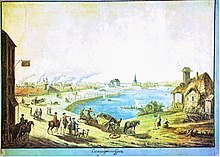
Russian historian Vasily Tatishchev and Russian engineer Georg Wilhelm de Gennin founded Yekaterinburg with the construction of a massive iron-making plant under the decree of Russian emperor Peter the Great in 1723. [34] They named the city after the emperor's wife, Yekaterina, who later became empress regnant Catherine I . [2] Officially, the city's founding date is 18 November 1723, when the shops carried out a test run of the bloomery for trip hammers. [2] The plant was commissioned 6 days later, on 24 November. [35] 1723 also saw the establishment of Yekaterinburg fortress , which would encompass many of the settlement's earliest buildings. Dmitry Mamin-Sibiryak very vividly described the beginning of the construction of a mining plant and a fortress: "Imagine completely deserted banks of the Iset river, covered with forest. In the spring of 1723, soldiers from Tobolsk, peasants of the assigned settlements, hired craftsmen appeared, and everything around came to life, as if by the dictates of a fairy tale. They dropped the forest, prepared a place for the dam, laid blast furnaces, raised the rampart, set up barracks and houses for the authorities... ". [36]
In 1722–1726 the Verkhne-Uktussky mining plant was built, [37] which was officially called the plant of the princess Elizabeth (the future village of Elizabeth, or Elizavetinskoe) and became a part of modern Yekaterinburg in 1934. [38] In 1726, Wilhelm de Gennin founded an auxiliary Verkh-Isetsky plant with a working settlement 2 versts from Yekaterinburg upstream ('verkh' in Russian) the Iset River. [39] The plant's dam formed the Verkh-Isetsky pond. Colloquially called by the Russian acronym VIZ, it was a satellite town until in 1926, with a population of over 20,000 people by this time, it was incorporated into Yekaterinburg as the core of the Verkh-Isetsky district. [39]

Yekaterinburg was one of the industrial cities of Russia prompted at the beginning of the 18th century by decrees of Tsar Peter the Great which demanded the development of the metalworking industry. With extensive use of iron, the city was built to a regular square plan with ironworks and residential buildings at the centre. These were surrounded by fortified walls so that Yekaterinburg was at the same time both a manufacturing centre and a fortress at the frontier between Europe and Asia. It, therefore, found itself at the heart of Russia's strategy for further development of the entire Ural region. The so-called Siberian Route became operational in 1763 and placed the city on an increasingly important transit route, which led to its development as a focus of trade and commerce between east and west, and gave rise to the description of the city as the "window to Asia". With the growth in trade and the city's administrative importance, the ironworks became less critical, and the more important buildings were increasingly built using expensive stone. Small manufacturing and trading businesses proliferated. In 1781 Russia's empress, Catherine the Great, granted Yekaterinburg town status and nominated it as the administrative centre for the wider region within Perm Governorate . [3] In 1807, the role of the capital of the mining and smelting region was confirmed by assigning it the status of the only "mountain city" in Russia. Until 1863, Yekaterinburg remained subordinate to the head of the mining plants of the Ural ridge , the minister of finance and personally to the emperor, and enjoyed considerable freedom from the governor's power. Since the 1830s, mountainous Yekaterinburg has become the center of mechanical engineering. [36]

In 1820–1845, 45% of the world's gold was mined in Yekaterinburg. This is the first ever "Gold Rush". [40] Until 1876, 80% of the coins in circulation in the Russian Empire were produced at the Yekaterinburg mint. [41]
Following the October Revolution , the family of deposed Tsar Nicholas II was sent to internal exile in Yekaterinburg where they were imprisoned in the Ipatiev House in the city. In July 1918, the Czechoslovak Legions were closing on Yekaterinburg. In the early hours of the morning of 17 July, the deposed Tsar, his wife Alexandra , and their children Grand Duchesses Olga , Tatiana , Maria , Anastasia , and Tsarevich Alexei were murdered by the Bolsheviks at the Ipatiev House. Other members of the Romanov family were killed at Alapayevsk later the same day. The Legions arrived less than a week later and captured the city. [42] [43] The city remained under the control of the White movement in which a provisional government was established. The Red Army took back the city and restored Soviet authority on 14 July 1919. [44] [45]

In the years following the Russian Revolution and the Russian Civil War , political authority of the Urals was transferred from Perm to Yekaterinburg. On 19 October 1920, Yekaterinburg established its first university, the Ural State University , as well as polytechnic, pedagogical, and medical institutions under the decree of Soviet leader Vladimir Lenin . Enterprises in the city ravaged by the war were nationalised, including: the Metalist (formerly Yates) Plant, the Verkh-Isetsky (formerly Yakovleva) Plant, and the Lenin flax-spinning factory (formerly Makarov). In 1924, the city of Yekaterinburg was renamed Sverdlovsk after the Bolshevik leader Yakov Sverdlov . [46] [28] [44]
By the 1934, following a series of administrative reforms carried by the early Soviet government, the earliest Russian settlements which predated Yekaterinburg and laid the basis of its founding, were incorporated into the city proper. [38] [47]
During the reign of Stalin, Sverdlovsk was one of several places developed by the Soviet government as a centre of heavy industry. Old factories were reconstructed and new large factories were built, especially those specialised in machine-building and metalworking. These plants included Magnitogorsk and the Chelyabinsk Tractor Plant in Chelyabinsk oblast , and Uralmash in Sverdlovsk. During this time, the population of Sverdlovsk tripled in size, and it became one of the fastest-growing cities of the Soviet Union. At that time, very large powers were given to the regional authorities. By the end of the 1930s, there were 140 industrial enterprises, 25 research institutes, and 12 higher education institutions in Sverdlovsk. [48] [49]
During World War II, the city became the headquarters of the Ural Military District on the basis of which more than 500 different military units and formations were formed, including the 22nd Army and the Ural Volunteer Tank Corps. Uralmash became the main production site for armoured vehicles. Many state technical institutions and whole factories were relocated to Sverdlovsk away from cities affected by war (mostly Moscow), with many of them staying in Sverdlovsk after the victory. The Hermitage Museum collections were also partly evacuated from Leningrad to Sverdlovsk in July 1941 and remained there until October 1945. [50] In the postwar years, new industrial and agricultural enterprises were put into operation and massive housing construction began. [51] [44] The lookalike five-story apartment blocks that remain today in Kirovsky, Chkalovsky, and other residential areas of Sverdlovsk sprang up in the 1960s, under the direction of Nikita Khrushchev 's government. [52] In 1977, Ipatiev House was demolished by order of Boris Yeltsin in accordance to a resolution from the Politburo in order to prevent it from being used as a rallying location for monarchists . Yeltsin later became the first President of Russia and represented the people at the funeral of the former Tsar in 1998. [53] There was an anthrax outbreak in Sverdlovsk in April and May 1979, which was attributed to a release from the Sverdlovsk-19 military facility . [54]
During the 1991 coup d'état attempt , Sverdlovsk, the home city of President Boris Yeltsin, was selected by him as a temporary reserve capital for the Russian Federation, in case Moscow became too dangerous for the Russian government. A reserve cabinet headed by Oleg Lobov was sent to the city, where Yeltsin enjoyed strong popular support at that time. [55] Shortly after the failure of the coup and subsequent dissolution of the Soviet Union, the city regained its historical name of Yekaterinburg on 23 September 1991. However, Sverdlovsk Oblast, of which Yekaterinburg is the administrative centre, kept its name. [56] [57]
In the 2000s, an intensive growth of trade, business, and tourism began in Yekaterinburg. In 2003, Russian President Vladimir Putin and German Chancellor Gerhard Schröder negotiated in Yekaterinburg. On 15–17 June 2009, the SCO and BRIC summits were held in Yekaterinburg, which greatly improved the economic, cultural, and tourist situation in the city. On 13–16 July 2010, a meeting between Russian President Dmitry Medvedev and German Chancellor Angela Merkel took place in the city. [58]
In 2018, Yekaterinburg hosted four matches of the 2018 FIFA World Cup and hosted the inaugural University International Sports Festival in 2023. [59]

Geographically, Yekaterinburg is in North Asia, close to the Ural Mountains (which divide Europe from Asia), 1,667 km (1,036 mi) east of the nation's capital Moscow.
The city has a total area of 1,111 km 2 (429 sq mi) .
Yekaterinburg is on the eastern side of the Urals. The city is surrounded by wooded hills, partially cultivated for agricultural purposes. Yekaterinburg is located on a natural watershed, so there would be many bodies of water close and in the city. The city is bisected by the Iset River , which flows from the Urals into the Tobol River . There are two lakes in the city, Lake Shuvakish and Lake Shartash. The city borders Verkh-Isetskiy Pond, through which the Iset River flows. Lake Isetskoye and Lake Baltym are both near the city, with Lake Isetskoye located near Sredneuralsk , and Lake Baltym located near the towns of Sanatornyy and Baltym.
Yekaterinburg uses the Yekaterinburg Time, which is five hours ahead of UTC (UTC+5), and two hours ahead of Moscow Time . [60]
The city possesses a humid continental climate ( Dfb ) under the Köppen climate classification . [61] It is characterised by sharp variability in weather conditions, with well-marked seasons. The Ural Mountains, despite their insignificant height, block air from the west, from the European part of Russia. As a result, the Central Urals are open to the invasion of cold arctic air and continental air from the West Siberian Plain. Equally, warm air masses from the Caspian Sea and the deserts of Central Asia can freely penetrate from the south. Therefore, the weather in Yekaterinburg is characterised by sharp temperature fluctuations and weather anomalies: in winter, from frost at −40 °C to thaw and rain; in summer, from frosts to temperatures above 35 °C (95 °F) . [61]
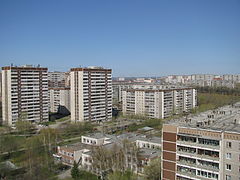
The distribution of precipitation is determined by the circulation of air masses, relief, and air temperatures. The main part of the precipitation is brought by cyclones with a western air mass transfer, that is, from the European part of Russia, while their average annual amount is 601 mm. The maximum falls on a warm season, during which about 60–70% of the annual amount falls. For the winter period is characterized by snow cover with an average capacity of 40–50 cm. The coefficient of moistening(the ratio of yearly precipitation and potential evaporation ) – 1. [61]
- The average temperature in January is −12.6 °C (9.3 °F) . The record minimum temperature is −44.6 °C (−48.3 °F) (6 January 1915);
- The average July temperature is 18.9 °C (66.0 °F) . The record maximum temperature is 40.0 °C (104.0 °F) (11 July 2023);
- The average annual temperature is 2.1 °C (35.8 °F) ;
- The average annual wind speed is 2.9 m/s (10 km/h; 6.5 mph) ;
- The average annual humidity is 75%;
- The average annual precipitation is 534 mm (21.0 in) ;
| Climate data for Yekaterinburg (1991–2020, extremes 1831–present) | |||||||||||||
|---|---|---|---|---|---|---|---|---|---|---|---|---|---|
| Month | Jan | Feb | Mar | Apr | May | Jun | Jul | Aug | Sep | Oct | Nov | Dec | Year |
| Record high °C (°F) | 5.6 (42.1) | 9.4 (48.9) | 18.1 (64.6) | 28.8 (83.8) | 34.7 (94.5) | 36.4 (97.5) | 40.0 (104.0) | 37.2 (99.0) | 31.9 (89.4) | 24.7 (76.5) | 13.5 (56.3) | 5.9 (42.6) | 40.0 (104.0) |
| Mean daily maximum °C (°F) | −9.3 (15.3) | −6.6 (20.1) | 0.9 (33.6) | 10.1 (50.2) | 18.3 (64.9) | 22.6 (72.7) | 24.3 (75.7) | 21.4 (70.5) | 15.0 (59.0) | 6.9 (44.4) | −2.6 (27.3) | −7.8 (18.0) | 7.8 (46.0) |
| Daily mean °C (°F) | −12.6 (9.3) | −10.8 (12.6) | −3.6 (25.5) | 4.7 (40.5) | 12.2 (54.0) | 16.9 (62.4) | 18.9 (66.0) | 16.2 (61.2) | 10.4 (50.7) | 3.6 (38.5) | −5.4 (22.3) | −10.7 (12.7) | 3.3 (37.9) |
| Mean daily minimum °C (°F) | −15.5 (4.1) | −14.1 (6.6) | −7.3 (18.9) | 0.3 (32.5) | 6.9 (44.4) | 12.0 (53.6) | 14.4 (57.9) | 12.2 (54.0) | 6.8 (44.2) | 1.0 (33.8) | −7.8 (18.0) | −13.3 (8.1) | −0.4 (31.3) |
| Record low °C (°F) | −44.6 (−48.3) | −42.4 (−44.3) | −39.2 (−38.6) | −21.8 (−7.2) | −13.5 (7.7) | −5.3 (22.5) | 1.5 (34.7) | −2.2 (28.0) | −9.0 (15.8) | −22.0 (−7.6) | −39.2 (−38.6) | −44.0 (−47.2) | −44.6 (−48.3) |
| Average mm (inches) | 25 (1.0) | 19 (0.7) | 25 (1.0) | 31 (1.2) | 47 (1.9) | 73 (2.9) | 93 (3.7) | 75 (3.0) | 45 (1.8) | 41 (1.6) | 33 (1.3) | 28 (1.1) | 534 (21.0) |
| Average extreme snow depth cm (inches) | 33 (13) | 42 (17) | 38 (15) | 5 (2.0) | 0 (0) | 0 (0) | 0 (0) | 0 (0) | 0 (0) | 1 (0.4) | 8 (3.1) | 21 (8.3) | 42 (17) |
| Average rainy days | 1 | 1 | 5 | 13 | 20 | 20 | 19 | 22 | 22 | 17 | 6 | 1 | 147 |
| Average snowy days | 26 | 23 | 18 | 10 | 4 | 0.4 | 0 | 0 | 2 | 13 | 23 | 25 | 144 |
| Average (%) | 79 | 75 | 68 | 60 | 58 | 63 | 68 | 73 | 75 | 75 | 78 | 79 | 71 |
| Mean monthly | 47 | 94 | 164 | 206 | 256 | 272 | 269 | 217 | 143 | 78 | 51 | 37 | 1,834 |
| Source 1: Pogoda.ru | |||||||||||||
| Source 2: NOAA (sun 1961–1990) | |||||||||||||
| Year | ||
|---|---|---|
| 1897 | 37,399 | — |
| 1926 | 134,831 | +260.5% |
| 1939 | 425,533 | +215.6% |
| 1959 | 778,602 | +83.0% |
| 1970 | 1,025,045 | +31.7% |
| 1979 | 1,211,172 | +18.2% |
| 1989 | 1,364,621 | +12.7% |
| 2002 | 1,293,537 | −5.2% |
| 2010 | 1,349,772 | +4.3% |
| 2021 | 1,544,376 | +14.4% |
According to the results of the 2021 Census , the population of Yekaterinburg was 1,544,376 ; [64] up from 1,349,772 recorded in the 2010 Census . [7]
As of 2021, the ethnic composition of Yekaterinburg was: [65]
| Ethnicity | Population | Percentage |
|---|---|---|
| 1,172,704 | 91.0% | |
| 27,431 | 2.1% | |
| 13,102 | 1.0% | |
| 8,769 | 0.7% | |
| 6,121 | 0.5% | |
| 4,987 | 0.4% | |
| 4,755 | 0.4% | |
| 4,307 | 0.3% | |
| 4,014 | 0.3% | |
| Others | 42,033 | 3.3% |

Christianity is the predominant religion in the city, of which most are adherents to the Russian Orthodox Church. The Yekaterinburg and Verkhotursky diocese is located in the Holy Trinity Cathedral in the city. Other religions practised in Yekaterinburg include Islam , Old Believers , Catholicism , Protestantism , and Judaism .
Yekaterinburg has a significant Muslim community, but it suffers from a lack of worship space: there are only two small mosques . Another mosque was built in the nearby city of Verkhnyaya Pyshma . On 24 November 2007, the first stone was laid in the construction of a large Cathedral Mosque with four minarets , and space for 2,500 parishioners in the immediate vicinity of the cathedral and a synagogue , thus forming the "area of the three religions". [66] The mosque was planned to be built for the SCO summit, but due to funding problems, construction did not move from zero and is now frozen.
Construction of a Methodist church started in 1992, and with the help of American donations, finished in 2001. [67] A synagogue was opened in 2005, on the same place a 19th-century synagogue was demolished in 1962.
Most of the city's religious buildings were destroyed during the Soviet era, in addition to the synagogue, the three largest Orthodox churches in Yekaterinburg were demolished – the Epiphany Cathedral, the Ekaterininsky Cathedral, and the Great Zlatoust Church . Other Christian churches such as the Lutheran Church of Yekaterinburg and the Roman Catholic Church of St. Anne (a new Catholic St. Anne's Church was built in 2000) were demolished as well. Other churches were used as warehouses and industrial sites. The only religious building in Yekaterinburg in the Soviet era was the Cathedral of St. John the Baptist. Recently, some churches are being rebuilt. Since 2006, according to the surviving drawings, the Great Zlatoust Church was restored in 2012. On 17 April 2010, the city was visited by Patriarch Kirill . [68]
Yekaterinburg is the administrative centre of Sverdlovsk Oblast . [1] Within the framework of the administrative divisions , it is, together with twenty-nine rural localities , incorporated as the City of Yekaterinburg, [9] an administrative unit with the status equal to that of the districts . [1] As a municipal division, the City of Yekaterinburg is incorporated as Yekaterinburg Urban Okrug. [10]
| Administrative districts of Yekaterinburg | |||||||||||
|---|---|---|---|---|---|---|---|---|---|---|---|
| Label | Name | Area (2019) | Population (2019) | Founded | Head | Website | Dialing code(s) | Subdivisions | |||
| 1 | Akademicheskiy | 81,000 | 2020 | Smirnyagin Nikolai Sergeevich | +7 3432, +7 3433 | 3 | |||||
| 2 | Verkh-Isetsky | 240 square kilometres (93 sq mi) | 221,207 | 1919 | Morozov Andrey Mikhailovich | 1 December 2021 at the | +7 3432, +7 3433 | 5 | |||
| 3 | Zheleznodorozhnyy | 126.3 square kilometres (48.8 sq mi) | 221,207 | 1938 | Pershin Vitaly Pavlovich | 1 March 2022 at the | +7 343 | 8 | |||
| 4 | Kirovsky | 72 square kilometres (28 sq mi) | 228,864 | 1943 | Bolikov Vladimir Yurievich | 15 March 2022 at the | +7 343 | 7 | |||
| 5 | Leninsky | 25 square kilometres (9.7 sq mi) | 156,723 | 1934 | Beruashvili Elena Zauryevna | 15 March 2022 at the | +7 343 | 3 | |||
| 6 | Oktyabrsky | 157 square kilometres (61 sq mi) | 148,981 | 1934 | Kostenko Igor Vitalievich | 10 November 2021 at the | +7 3432 | 11 | |||
| 7 | Ordzhonikidzevsky | 102 square kilometres (39 sq mi) | 286,482 | 1934 | Kravchenko Roman Gennadievich | 16 March 2022 at the | +7 3433 | 6 | |||
| 8 | Chkalovsky | 402 square kilometres (155 sq mi) | 275,571 | 1943 | Shipitsyn Evgeny Viktorovich | 9 May 2019 at the | +7 3432 | 10 | |||
Each district is not a municipal formation, and the historical centre of the city is divided into five inner-city districts (except Chkalovsky and Ordzhonikidzevsky).
A district named Akademicheskiy was formed from the parts of Leninsky and Verkh-Isetsky districts on 3 January 2020. [70] On 1 October 2021, more settlements were transferred from Verkh-Isetsky to Akademicheskiy district. [71]
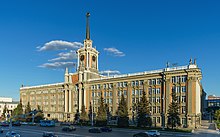
The Charter of Yekaterinburg establishes a four-link system for the organisation of local authorities, which includes: the Head of Yekaterinburg, who serves as the chairman of the Yekaterinburg City Duma, the Yekaterinburg City Duma, the Administration of the City of Yekaterinburg, and the Chamber of Accounts. [74]
According to the charter of Yekaterinburg, the highest official of the municipal formation is the mayor of Yekaterinburg. The mayor is elected by universal suffrage, but since 3 April 2018, the procedure for direct elections of the mayor of the City of Yekaterinburg was abolished. The mayor of the city is endowed with representative powers and powers to organize activities and guide the activities of the City Duma. In addition, the mayor of the city exercises other powers such as concluding a contract with the head of the city administration and ensuring compliance with the Russian Constitution, Russian legislation, the city charter, and other normative acts. [75] [76]
In the event of a temporary absence of the mayor of Yekaterinburg, his authority under his written order is exercised by the deputy mayor of Yekaterinburg. [77]
The representative body of the municipal formation is the Yekaterinburg City Duma, which represents the city's entire population. The membership of the Duma is 36 deputies (18 deputies were elected in single-mandate constituencies and 18 in a single electoral district). Residents of the city elect deputies on the basis of universal suffrage for a period of 5 years. [74]
The executive and administrative body of the municipal formation is the Administration of the City of Yekaterinburg, led by the head of the Administration, currently held by Aleksandr Yacob. The administration is endowed with its own powers to resolve issues of local importance, but it is under the control and accountable to the Yekaterinburg City Duma. The building of the Administration of Yekaterinburg is located on 1905 Square . [76]
The Chamber of Accounts is a permanently operating body of external municipal financial control. The Chamber is formed by the apparatus of the City Duma and is accountable to it. The Chamber consists of the chairman, deputy chairman, auditors and staff. The structure and number of staff of the chamber, including the number of auditors, is determined by the decision of the City Duma. The term of office of the Chamber staff is 5 years. The Chamber of Accounts is a legal entity. [77]

In accordance with the regional charter, Yekaterinburg is the administrative centre of the Sverdlovsk Oblast. [1] The executive power is exercised by the governor of Sverdlovsk Oblast, the legislative power by the legislative assembly of Sverdlovsk Oblast, and the judicial power by the Sverdlovsk Regional Court, located in the building of the Palace of Justice. [78] The building serving the regional government is the White House and the building serving the legislative assembly is located next to it on October Square. The ministries of the Sverdlovsk Region are located in the building of the regional government, as well as in other separate buildings of the city. [79]
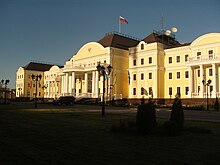
Yekaterinburg serves as the centre of the Ural Federal District. As a result, it serves as the residence of the presidential envoy , the highest official of the district and part of the administration of the President of Russia. The residence is located the building of the regional government on October Square near the Iset River embankment.

In addition, Yekaterinburg serves as the centre of the Central Military District and more than 30 territorial branches of the federal executive bodies, whose jurisdiction extends not only to Sverdlovsk Oblast, but also to other regions in the Ural Mountains, Siberia, and the Volga Region.
According to the results of the September 2013 elections, the mayor of the city was Yevgeny Roizman , nominated by the Civil Platform party. Out of the 36 seats in the City Duma, 21 belong to United Russia , 7 to A Just Russia , 3 to the Civil Platform, 2 to the Communist Party and 1 seat to the LDPR . The turnout in the mayoral elections was 33.57%. [80]
| 78,289 | 38.4% | ||||
| 31,288 | 15.4% | ||||
| 25,869 | 12.7% | ||||
| 22,293 | 10.9% | ||||
| 11,340 | 5.6% | ||||
| Party | Candidate | Votes | % | ±% | |
|---|---|---|---|---|---|
It was the last popular vote in Yekaterinburg. Since 2018, there have been no elections, but a vote in the Municipal Duma. On 25 September 2018 the majority of the representatives in the Duma voted in favour of the Vice-Governor of Sverdlovsk oblast, Alexander Vysokinskiy.
Yekaterinburg is one of the largest economic centres in Russia. It is included in the City-600 list (it unites the 600 largest cities in the world that produce 60% of global GDP), compiled by the McKinsey Global Institute, a research organisation. In 2010, the consulting company estimated the gross product of Yekaterinburg to be about $19 billion (according to the calculations of the company, it should grow to $40 billion by 2025). [82] [83]
By volume of the economy, Yekaterinburg ranks third in the country, after Moscow and St. Petersburg. According to a research of the Institute for Urban Economics, in the ranking of the largest cities and regional capital cities according to economic standards for 2015, Yekaterinburg ranked third. The city's gross urban product (GVP) was 898 billion rubles. Per capita GDP was 621.0 thousand rubles (18th place). [84] In 2015, the gross urban product of the Yekaterinburg metropolitan area amounted to 50.7 billion international dollars (the fourth place in the country) or 25.4 thousand international dollars in terms of per inhabitant of the metropolitan area. [85]
In the Soviet era, Yekaterinburg (as Sverdlovsk) was a purely industrial city, with a share of industry in the economy of 90% (of which 90% were in defense production). With Chelyabinsk and Perm, the three cities formed what to be the Urals industrial hub. [86]
The former head of Yekaterinburg, Arkady Chernetsky, has set the goal of diversifying the city's economy, which has resulted in the development of sectors such as warehousing, transportation, logistics, telecommunications, financial sector, wholesale and retail trade, etc. in Yekaterinburg. [86] Economist-geographer Natalia Zubarevich points out that at the present stage, Yekaterinburg has practically lost its industrial specialisation. [87]
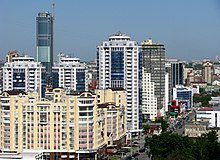
The standard of living in Yekaterinburg exceeds the average standard across Russia. According to the Department of Sociology of the Financial University under the Government of the Russian Federation, it is among the top ten cities with the highest standard of living. Compared to other Russian cities with a population of around or over one million, in 2015, Yekaterinburg held a leading position in terms of average monthly wages and retail turnover, in terms of the total volume of investments in fourth place of fixed assets, and second place in housing placement. [88] [89]

The average monthly wage in Yekaterinburg following the results of 2019 was 54,976 rubles. This is the first place among the millionth municipalities of the Russian Federation. [90] There are on average 440,300 people employed by large and middle-sized organisations and companies. The unemployment rate at the end of 2015 was 0.83% of the total economically active population. Locals labelled the main problems of the city such the current state of the healthcare system, housing system, and transportation system. [89] [91]
The budget of Yekaterinburg in 2015 was executed on income in the amount of 32,063.6 million rubles, for expenses in the amount of 32,745.8 million rubles. Among the budget expenditures: 17 billion rubles were spent on education, over 1 billion rubles on culture, and about 900 million rubles on health. The main part of the revenue of the city treasury was its own tax and non-tax revenues (more than 18 billion rubles). The revenues from the regional and federal budgets were at the lowest level in 10 years. Specialists noted a decrease in tax revenues and an increase in tax debt (exceeded 2 billion rubles). [89] [92]
The main budget expenditures are the development of the economy (which accounts for 19% of expenditures) and the social security of the townspeople (11% of expenditures go). Cities such as Perm, Kazan and Ufa, spend for these purposes in a smaller percentage of costs (from 2 to 6%). Also, a fairly strict budgetary discipline is noted—the budget deficit is kept at the level of 2% of its volume. [93]

Yekaterinburg is one of the largest financial and business centres in Russia, with offices of multinational corporations, representative offices of foreign companies, and a large number of federal and regional financial and credit organisations. The financial market of Yekaterinburg is characterised by stability and independence, based both on the broad presence of large foreign and Moscow credit organisations and on the availability of large and stable local financial holdings. [94]
The financial sector of Yekaterinburg has more than 100 banks, including 11 foreign banks. The list of the largest Russian banks for assets for 2016 included 10 banks registered in Yekaterinburg, including but not all: Ural Bank for Reconstruction and Development, SKB-Bank, Uraltransbank, and UM Bank. [95] [96]
IT "SKB Kontur" from Yekaterinburg – the largest software manufacturer in Russia – first place according to the RAEX rating [97]
Also in Yekaterinburg is the Ural headquarters of the Central Bank of Russia. Since 7 August 2017, by order of the Bank of Russia, the branches of the Siberian, Far Eastern and part of the Prevolzhsky Federal Districts have been transferred to the control of the Ural Megaregal Directorate. Thus, this is one of the three main departments of the Mega-regulator in the territory of Russia. [98]
A major role in the formation of Yekaterinburg as a business centre has its infrastructural potential, which is growing at a high rate: transport accessibility for Russian and foreign economic entities, the availability of hotels, advanced communication services, business related services (consulting, exhibition activities, etc.). [94] Yekaterinburg has its own central business district, Yekaterinburg City. [99]
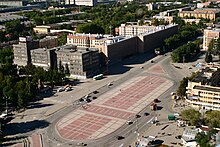
Yekaterinburg has been a major industrial centre since its foundation. In the 18th century, the main branches were smelting and processing of metal. Since the beginning of the 19th century, machine building appeared, and in the second half of the 19th century, light and food (especially milling) industry was widely spread. A new stage in the development of production occurred during the period of industrialisation – at this time in the city, factories were built, which determined the industry specialisation of heavy engineering. During World War II, Yekaterinburg (as Sverdlovsk) hosted about sixty enterprises evacuated from Central Russia and Ukraine. As a result, there was a sharp increase in the production capacity of existing plants and the emergence of new branches of the Urals industry.
At present, more than 220 large and medium-sized enterprises are registered in Yekaterinburg, 197 of them in manufacturing industries. [94] In 2015, they shipped 323,288 million rubles worth of own-produced goods. Production by industry was divided accordingly: metallurgical production and metalworking 20.9%, food production 13.3%, production of electrical equipment, electronic and optical equipment 9.2%, production of vehicles 8.4%, production of machinery and equipment 6.4%, chemical production 5.5%, production of other nonmetallic mineral products 3.7%, production of rubber and plastic products 2.8%, pulp and paper production, publishing and printing 0.5%, and other 29.3%. [100]
Several headquarters of large Russian industrial companies are located in the city: IDGC of Urals, Enel Russia, Steel-Industrial Company, Russian Copper Company, Kalina, NLMK-Sort, VIZ-Stal, Sinara Group, Uralelectrotyazhmash, Automation Association named after academician NA Semikhatov, Ural Heavy Machinery Plant (Uralmash), Fat Plant, Fores, confectionery association Sladko, Machine Building Plant named after M.I. Kalinin, Ural Turbine Plant, Uralkhimmash and others. [101]

Yekaterinburg ranks first in retail trade of the Russian Federation per capita, ahead of Moscow. [102] The consumer market contributes significantly to Yekaterinburg's economy. Revenue of retail stores in 2015 amounted to 725.9 billion rubles, and the number of retailers totaled 4,290. [103] As of 1 January 2016, 36 shopping centers operate in the city, taking up a total area of which was 1,502,700 m 2 (16,175,000 sq ft) . The availability of shopping centres per 1,000 inhabitants increased to 597.2 m 2 (6,428 sq ft) . [104]
Retail areas amounted to 2,019,000 m 2 (21,730,000 sq ft) , with the availability of retail space reached 1,366.3 m 2 (14,707 sq ft) per 1,000 inhabitants. According to these statistics, Yekaterinburg holds leading positions among other major cities of Russia. In the consumer market of Yekaterinburg, 1041 network operators are represented. The number of wholesale enterprises totalled 1,435. Among the Federal construction stores represented in the city, you can select: Leroy Merlin, [105] Castorama, [106] Domostroy, [107] Maxidom, [108] OBI, [109] Sdvor. [110] Yekaterinburg has an agricultural market named Shartashsky. [104] [111]
The revenue of catering in 2015 totalled 38.6 billion rubles. The network of catering enterprises in Yekaterinburg is presented as follows: 153 restaurants, 210 bars, 445 cafes, 100 coffee houses, 582 dining rooms, 189 eateries, 173 fast-food establishments, 10 tea shops, 319 other types of institutions (buffets, cafeterias, catering companies). 82.6% of catering enterprises provide additional services to consumers. [112]
The revenue of the services industry in 2015 totalled 74.9 billion rubles. The fastest pace in the city is developing hairdressing services, sewing and knitting atelier services, pawnshop services, fitness centre services. The network of public service enterprises in Yekaterinburg includes 5,185 facilities. In 2015, the provision of service areas for service enterprises totaled 382.1 m 2 (4,113 sq ft) per 1,000 citizens. The highest concentration of household services is observed in the Verkh-Isetsky, Oktyabrsky and Leninsky districts. [113]
Greenwich Shopping Center, as of 2021, is the largest shopping center in Europe. [114]
The largest store in the world by area is Sima-Land. [115]
Yekaterinburg is a major centre for the Russian tourist industry. In 2015, the city was one of the top five most visited Russian cities (others being Moscow, St. Petersburg, Novosibirsk , and Vladivostok ) according to the Global Destinations Cities Index, which represents the payment system Mastercard . [116] In recent years, a lot of work has been done to create a positive image of Yekaterinburg as a centre for international tourism, including holding of summits for the Shanghai Cooperation Organisation (SCO) in 2008 and 2009 and the international exhibition Innoprom in 2009 and 2010. [117] In 2014, Yekaterinburg ranked third among Russian cities in popularity among foreign tourists after Moscow and St. Petersburg. [118]
In 2015, the total flow of inbound tourism grew by 10% compared to the previous year and amounted to 2.1 million people. [119] In recent years, there has been a tendency to reduce the role of business tourism in the overall flow: if in 2013 about 80% of trips were business, in 2015 their number was already 67%. Most tourists go to "bow to the memory of the last and his family." In addition, new tourist ideas are developing such as the Bazhov theme, the geological and mineralogical theme, industrial tourism, and the event calendar. [120]
Yekaterinburg is the third largest transport hub of Russia, behind Moscow and St. Petersburg. The city has 6 federal highways, 7 main railway lines, and an international airport. The location of Yekaterinburg in the central part of the region allows for 7 to 10 hours to get from it to any large city of the Urals. [121] The formation of Yekaterinburg as an important transportation hub is largely due to the city's favourable geographical location on a low stretch of the Ural Mountains, through which it was convenient to lay the main roads connecting the European and Eastern parts of Russia. [122]

Yekaterinburg is one of the ten Russian megacities with the largest car fleet (0.437 megacars were registered in the city in 2014), which has been intensively increasing in recent years (by 6–14% annually). [123] [124] The level of car ownership in 2015 has reached 410 cars per 1,000 people. [125] Its pace in the past few years has seriously exceeded the pace of development and the capacity of the road infrastructure. For the first time, transport problems started to appear in Yekaterinburg in the 1980s and though it did not seem threatening at first, the situation gets worse every year. Studies have shown that as early as 2005, the capacity limit for the road network was reached, which has now led to permanent congestion. [126] To increase the capacity of the street-road network, stage-by-stage reconstruction of streets is being carried out, as well as multi-level interchanges being built. In order to reduce the transit traffic, the Sverdlovsk Oblast administration announced two road projects in 2014: the Yekaterinburg Ring Road (EKAD) and an overpass road on Sovetskaya Street. The Yekaterinburg Ring Road would surround the largest municipalities of Yekaterinburg. Its purpose would be to help the city's economy and reduce traffic on the Middle Ring Road of the city, making it easier for civilians to commute around the city than going through the city's traffic congestion. Eventually, the Ring Road would connect to other federal roads in order for easier access between other Russian cities. Construction of the road started in the same year. The projects were assigned to the Ministry of Transport and Communications since the projects were crucial to the city's economy. Officials hope the road projects will build environments more conducive to improving local quality of life and outside investments. Completing these major inter-regional roads will increase productive traffic by 50% to 100%, improving the local economy with its ease of access to industries. [127]
Since 2014, the project for the introduction of paid parking in the central part of Yekaterinburg is being implemented. The project is implemented in parallel with the increase in the number of intercepting parking lots and the construction of parking lots. At the end of 2015, in the central part of the city there were 2,307 paid parking places. [125]
The total length of the road network in Yekaterinburg is 1,311.5 km (814.9 mi) , of which 929.8 km (577.8 mi) is cobbled carriageways, 880 km (550 mi) is with upgraded coverage, 632 km (393 mi) is backbone networks, of which 155 km (96 mi) are on the citywide backbone network movement. 20 interchanges have been constructed at different levels within the city limits, including 11 on the EKAD and 9 on the middle ring. 74 transport facilities (27 bridges across the Iset River, Patrushikha, Mostovka, Istok Rivers, 13 dams on the Iset, Patrushikha, Istok, Olkhovka, Warm, Shilovka Rivers, 23 road overpasses , and 18 out-of-the-way pedestrian crossings) were built as well. [128]
Yekaterinburg is served by the following highways: [129]

Yekaterinburg uses almost all types of public transport. The largest transportation services—the Municipal Association of Bus Enterprises, the Tram-Trolleybus Office, and the Yekaterinburg Metro —transported 207.4 million people in 2015. [130] The total volume of passenger transportation by all land transport modes decreases annually. If the annual passenger traffic of municipal transport was 647.1 million people in 2002, and according to this index the city occupied the third place in the country with a wide margin, then in 2008 this figure would be 412 million people (the fourth place in Russia). [131] [132]

Since 1991, the city operates the sixth metro in Russia and the thirteenth in the CIS . At the moment there is one line with 9 stations. In 2015 49.9 million passengers were transported; according to this metric the Yekaterinburg Metro is the fourth in Russia, behind the Moscow Metro, Saint Petersburg Metro, and Novosibirsk Metro . [133] Although the metro is the second most popular type of public transport, in recent years significant problems have appeared in its work: loss-making, obsolete rolling stock, and a shortage of funds for modernisation. [134] The tram network was established in 1929 and currently [ when? ] plays a leading role in the urban transport system. The volume of passengers carried for 2013 is 127.8 million, [135] but this declines every year (245 million people in 2013 [136] ). In 2016 there were 30 routes operating 459 cars. The total length of the tracks is 185.5 km. As of 2016 [ update ] , the construction of a tram line "Ekaterinburg-Verkhnyaya Pyshma" was planned. [137]

There are 93 bus routes operating in Yekaterinburg, including 30 municipal ones (EMUP "MOAP"). [138] In 2007, 114.5 million passengers were transported by municipal intercity buses (124.6 million in 2006). [139] The decrease in volume is due to the increasing role of the fixed-route taxis in the urban transport system of Yekaterinburg, as well as the high cost of travel. However, the city bus transport network provides significant employment for the people of Ekaterinburg, including the formidable babushkas who collect passenger fares. In the park of EMPU, there are 537 buses. [140] In 2013, there are 19 routes, which employ 250 trolleybuses. The total length of trolleybus lines is 168.4 km. The number of passengers transported by trolleybus in 2007 amounted to 78.4 million (84.3 million in 2006). [139]
In addition, the city operates an electric train route linking the north-western and the southern parts of Yekaterinburg, from Sem' Klyuchey to Elizavet.
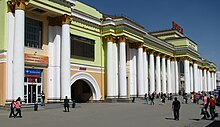
Yekaterinburg is a major railway junction. In the Yekaterinburg node, 7 main lines converge (to Perm , Tyumen , Kazan , Nizhny Tagil , Chelyabinsk , Kurgan , and Tavda ). The Sverdlovsk Railway Administration is located in the city, which serves trains on the territory of the Sverdlovsk and Tyumen Regions, the Perm Territory, the Khanty-Mansiysk and Yamalo-Nenets Autonomous Districts, as well as parts of the Omsk Region, and there is a single road traffic control centre. The Perm–Yekaterinburg–Tyumen section is now part of the main route of the Trans-Siberian Railway .
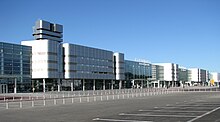
Yekaterinburg is served by two primary airports: Koltsovo International Airport (SVX) and the smaller Yekaterinburg Aramil Airport . Koltsovo Airport is one of the largest airports in the country, serving 5.404 million passengers (including 3.485 million serviced by domestic airlines, 1.919 million at international flights) in 2017, making it the sixth busiest airport in Russia . [141]

Yekaterinburg has an extensive network of municipal, regional and federal health facilities. There are 54 hospitals, designed at a capacity of 18,200 beds, [142] 272 ambulatory polyclinics, and 156 dental clinics and offices. [143] Some health facilities are based on medical research institutes such as the Research Institute of Phthisiopulmonology, [144] the Research Institute of Dermatology and Immunopathology, [145] and the Ural State Medical University, as well as others.
In clean areas of the city, there is the Yekaterinburg Medical Centre, which includes the Sverdlovsk Regional Clinical Hospital No. 1 (also includes a polyclinic and a boarding house), Central City Hospital No. 40 (polyclinic, therapeutic building, surgical building, infectious body, neuro-surgical building, maternity hospital), Regional Cardiology Centre, Centre for Prevention and Control of AIDS, and MNTK Eye Microsurgery. [146]
Other large medical centres are the Uralmash Health Centre (Hospital No. 14), the Hospital of veterans of the Great Patriotic War, the district hospital of the Ministry of Internal Affairs, the district military hospital, the Oncology Centre, the Sverdlovsk Oblast Psychiatric Hospital, the Disaster Medicine Centre, the Sanguis Blood Transfusion Centre, children's versatile hospital No. 9, and the regional rehabilitation centre on Chusovsky lake. There are about 300 pharmacies in the city. [143] The number of doctors in public medical institutions is 11,339 people (83.9 per 10,000 people) and the number of nurses is 16,795 (124 per 10,000 people).
Private medical institutions also operate in the city. [147]

Yekaterinburg's education system includes institutions of all grades and conditions: preschool, general, special (correctional), and vocational (secondary and higher education), as well as others. Today, the city is one of the largest educational centres of Russia, with Yekaterinburg considered to be the leading educational and scientific centre of the Urals . [148]

There are 164 educational institutions in Yekaterinburg: 160 of them operate in the morning and the other 4 in the evening. In 2015, 133,800 people were enrolled in general education institutions, which holds a capacity of 173,161 people. [149] Yekaterinburg's education system also includes state pre-school educational institutions, non-state pre-school institutions, out-of-town health camps, and municipal city health facilities with a one-day stay. [150] Five educational institutions of the city: SUNC UrFU, Gymnasium No. 2, Gymnasium No. 9, Gymnasium No. 35, and Lyceum No. 135, were included in the rating of the five hundred best schools in the country by the Moscow Center for Continuous Mathematical Education and the Ministry of Education and Science of the Russian Federation . [151]
On 16 July 1914, the Ural Mining Institute of Emperor Nicholas II (now the Ural State Mining University ) was established as Yekaterinburg's first educational institution. [152] In 1930, the Sverdlovsk Power Engineering College (now the Ural Technical Institute of Communications and Informatics) was opened to train specialists in the field of communications. The Alexei Maximovich Gorky Ural State University (now the Ural Federal University ) became the first university in Yekaterinburg by decree of the Council of People's Commissars of the RSFSR , signed by Vladimir Lenin on 19 October 1920. The Sverdlovsk Engineering and Pedagogical Institute (today the Russian State Vocational and Pedagogical University) became the first university of the USSR for the training of engineering and pedagogical personnel when it was opened in 1979.

In terms of the level of qualification of the graduates, Yekaterinburg's universities are among the leading in Russia, in particular in terms of the number of graduates representing the current managing elite of the country, Yekaterinburg universities are second only to the educational institutions of Moscow and Saint Petersburg. [153] [154] Currently, there are 20 state universities in the city, which currently holds a total of 140,000 students. [155] In addition, there are 14 non-state institutions of higher education in the city, such as the Yekaterinburg Academy of Contemporary Art and the Yekaterinburg Theological Seminary. The prestigious architecture school, the Ural State Academy of Architecture and Arts , is also located within the city limits. Other institutions of higher education Ural State Pedagogical University, Ural State University of Forestry, Ural State University of Railway Transport, Ural State University of Economics, Military Institute of Artillery, Ural State Conservatory , Ural State Agricultural Academy, Ural State Law Academy , Ural State Medical University, Ural State Academy of Performing Arts, Ural Academy of Public Service, and Institute of International Relations .
In May 2011, the Ural State University and Ural State Technical University merged to form the Boris N. Yeltsin Ural Federal University , making it the largest university in the Urals and the largest university in Russia. As of 1 January 2016, the university had 35,300 students and 2,950 teachers. The university's budget in 2015 totalled 9,1 billion rubles and the volume of research and development work totalled 1,6 billion rubles. [156] As of 2021, UrFU is the largest university in Russia in terms of the number of students, being on the 351st place in the QS World University Rankings. [157] [158] The number of publications of the university in the Web of Science database is about a thousand per year. [159]
There are many branches of non-resident universities in the city, including the Ural branch of the Siberian State University of Telecommunications and Informatics, the Ural branch of the Russian Academy of Private Law, the Yekaterinburg branch of the Plekhanov Russian Economic Academy, the Yekaterinburg branch of the University of the Russian Academy of Education, the Yekaterinburg branch of the Moscow State University, and Sholokhov Humanitarian University, as well as others.

In Yekaterinburg, a large number of print publications are published: about 200 newspapers, the most read being the Ural Worker , Vecherny Yekaterinburg , Oblastnaya Gazeta , and For Change! , and 70 magazines, with most read being Red Burda and I'm Buying . [160] [161]
A television studio was built in Yekaterinburg (as Sverdlovsk) in 1955 and on 6 November of the same year, the first telecast appeared. Coloured television later appeared in 1976. [162] Now the television is broadcast by 19 companies, including but not all: STRC Ural, Channel Four, 41 Home, Channel 10, OTV, Union (Orthodox), and UFO 24. Broadcasting is carried out from the TV tower on Lunacharsky street (television studio GTRK Ural), the TV tower on the Moskovskiy Hill, and from the TV tower (radio relay tower) on Blyukher Street. In 1981, construction of a new television tower was started, which was to become the second tallest in Russia after the Ostankino Tower and cover the territory of most of the Sverdlovsk region, but economic difficulties postponed construction. As a result, the television tower was the tallest uncompleted structure in the world. On 24 March 2018, the television tower was demolished by detonation for the city's beautification in preparation of the 2018 FIFA World Cup . [163] The Shartash radio mast, which broadcasts, is the tallest structure in the city, with a height of 263 meters. [164] In addition, several dozens of national and local news agencies are broadcast in Yekaterinburg, with the most watched being ITAR-TASS Ural, RUIA-Ural, and Interfax-Ural.
At the moment [ when? ] , there are 26 internet providers and 6 cellular operators in the city. [165] According to Yekaterinburg News , the city has signed a cooperative agreement with the Russian mobile operator Vimpelcom , working under the Beeline brand. The partnership will involve cooperation on investment projects and social programmes focused on increasing access to mobile services in the city. Beeline has launched an initiative to provide Wi-Fi services in 500 public trams and trolley buses in Yekaterinburg. [166]
| Generation | Mobile communication standard | Operators |
|---|---|---|
| , , , , Motive | ||
| MTS, MegaFon, Beeline, Tele2 Russia, Motive | ||
| MTS, MegaFon, Beeline, Tele2 Russia, Motive | ||
| , | MTS, MegaFon, Beeline, Tele2 Russia | |
| MTS, MegaFon, Beeline, Tele2 Russia | ||
| MTS, MegaFon, Beeline, Tele2 Russia | ||
| MTS, MegaFon, Beeline, Tele2 Russia, Motive, | ||
| MTS, MegaFon, Beeline, |

Yekaterinburg is a multipurpose cultural centre of the Urals Federal District. [148] There are about fifty libraries in the city. The largest library organisations are the Sverdlovsk Oblast Universal Scientific Library, the V.G. Belinsky Scientific Library, which is the largest public library in Sverdlovsk Oblast, and the Municipal Library Association, which is composed of 41 libraries throughout the city, including the AI Herzen Central City Library. [167]
There are about 50 different museums in the city. [168] Yekaterinburg has unique museum collections, such as the collections of Russian paintings in the Yekaterinburg Museum of Fine Arts and the Nevyansk icons in the Nevyansk Icon Museum , with more than 300 icons representing the eighteenth through the twentieth centuries on display. There is also a unique exhibit, the Kaslinsky cast iron pavilion, which received main awards at the 1900 World Exhibition in Paris. The Kasli Pavilion was registered by UNESCO as the only cast-iron architectural structure in the world, which is in the museum collection. [169] Museums of the city also have collections of jewellery and stone ornaments. The United Museum of Writers of the Urals presents exhibitions in memory of writers such as Dmitry Mamin-Sibiryak and Pavel Bazhov . It also is the home of the Shigirskaya Kladovaya ( Шигирская кладовая ), or Shigir Collection, which includes the oldest known wooden sculpture in the world. The sculpture was found near Nevyansk and originally estimated to have been made approximately 9,500 years ago, but now is estimated to have been made 11,500 years ago. [170] Yekaterinburg museums annually participate in the international event Long Night of Museums .
Yekaterinburg has the third most theatres in Russia. [171] The influence of theatrical life of the city was made by the Moscow Art Academic Theater and the Central Theater of the Soviet Army when they evacuated to Yekaterinburg (as Sverdlovsk) during World War II, and they had their own theater in the city. [172] Notable theatres that operate in the city are Academic Theater of Musical Comedy, Drama Theater, Kolyada-Theater , the youth theatre, and the puppet theatre, as well as others. The Yekaterinburg Opera and Ballet Theater received four awards at the Golden Mask 2020 Festival in Moscow, including the main Golden Mask for the Best Opera Performance [173]
In 2014, the city showcased its education, literary, art, and theatre culture through the Russian Year of Culture Programme. [174]
The city has a well-developed film industry. Opened back in 1909, Laurage was the first cinema in Yekaterinburg. In 1943, the Sverdlovsk Film Studio was opened and produced its first feature film Silva a year later. After the Second World War, the studio produced up to ten feature films a year. There are more than 20 cinemas in Yekaterinburg, the oldest of which is the Salyut, while the most capacious is the Cosmos spacecraft. [175] [176] There are also chains of movie theatres such as Premier-Zal, Kinomaks, and Kinoplex, which usually open in shopping and entertainment centres.
A number of popular Russian rock bands, such as Urfin Dzhyus, Chaif , Chicherina , Nautilus Pompilius , Nastya, Trek, Agata Kristi , Slaughter to Prevail and Smyslovye Gallyutsinatsii , were originally formed in Yekaterinburg ( Ural Rock is often considered as a particular variety of rock music. Yekaterinburg and St. Petersburg are actually considered to be the main centres of the genre in Russia). Also, opera singers like Boris Shtokolov , Yuri Gulyayev , Vera Bayeva graduated from the Urals State Conservatory. The Ural Philharmonic Orchestra (currently conducted by Dmitry Liss ), founded by Mark Paverman and located in Yekaterinburg, is also very popular in Russia and in Europe, as well as the Ural Academic Popular Chorus, a folk-singing and dance ensemble. [ citation needed ]
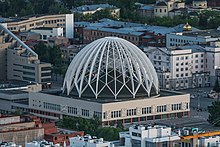
Yekaterinburg V. I. Filatov State Circus is located in the centre of the city, on the western bank of the Iset River. In 2012, the Yekaterinburg Circus was nominated "Best Circus of the Year" for the circus show Sharivari by the Rosgoscirk and the Ministry of Culture . [177]
The Presidential Center named after Boris Yeltsin was built in Yekaterinburg in 2015. It is considered to be a public, cultural and educational center. Center has its art gallery, library, museum equipped with the newest multimedia technologies that help to present the documents, video materials and archive photos. In 2017, the Yeltsin Center was recognized as the best museum in Europe by the Council of Europe, the first of the museums in Russia. [178]
The Urals Society of Natural Science Lovers pushed Yekaterinburg to have a zoo. Currently, the zoo has more than 1,000 animals that belong to more than 350 species. The zoo covers an area of 2.7 hectares.
On 18 June 2011, Yekaterinburg launched Red Line as a pedestrian tourist route for self-guided tours by residents and visitors to go to 34 landmarks in the historical section of the city. [179]

Many buildings of Yekaterinburg are ranged from a different number of architectural styles. The city had a regular layout, based on the fortresses of the Renaissance and by the principles of French town planning during the 17th century. By the 18th century, the Baroque movement was not that influential in Yekaterinburg, with the style being seen in churches which later declined [180]
In the first half of the 19th century, neoclassicism grew influential in the Yekaterinburg's architecture. The estates were built in the neoclassic style, including the main house, wings, services, and often an English-style park. This style's influence in Yekaterinburg is mostly due to the contributions of architect Michael Malakhov, who worked in the city from 1815 to 1842. He designed the assemblies of the Verkhne-Isetsky factory as well as the Novo-Tikhvinsky Monastery. [180]
At the beginning of the 20th century, eclecticism became a dominant influence in Yekaterinburg's architecture. Buildings such as the Opera House and Yekaterinburg railway station were built in this style. During the 1920s and the 1930s, constructivism took effect, influencing residential complexes, industrial buildings, stadiums, etc. Architects Moses Ginzburg, Jacob Kornfeld, the Vesnina brothers, Daniel Friedman, and Sigismund Dombrovsky contributed greatly to the constructivism in the city. More than 140 structures in Yekaterinburg are designed through the constructivist style. [181]

During the 1930s to 1950s, there was a turn back to neoclassicism, with much attention paid to public buildings and monuments. Notable examples include the buildings of the Ural Industrial Institute on Lenin Avenue, the City Party Committee and the City Council Executive Committee building (now the City Administrative building), the District Officers' House, and the House of Defense complex. Cultural buildings are built in the squares in orderly composition. In these years, architects Golubev, K. T. Babykin, Valenkov worked fruitfully in Yekaterinburg with this style. In the 1960s, changes in the approach to construction led to widespread distribution of apartment blocks common in the Khrushchev era . Buildings built by individuals were rare, among them being: KKT "Kosmos", the Palace of Youth, and DK UZTM. [182]
From the 1960s to the 1980s, as industrial development grew in Yekaterinburg, so did rationalism . The situation changed in the 1990s when Russia transferred into a market economy. At that time, older buildings were restored, giving the urban area a new environment such as: the Cosmos Concert Hall, the Puppet Theater, the children's ballet theatre The Nutcracker, the Palace of Justice, the Cathedral of the Blood, and the Church of the Transfiguration . At the same time, the construction of new buildings was accompanied by the demolition of historical buildings, leading to the development of the "facade" phenomenon, where the facades of historic buildings are preserved while adjacent modern buildings are built. [183]
The centre of Yekaterinburg became the centre of new construction, where banks, business centres, hotels, luxury residential complexes, and sports and shopping centres were built. High-tech architecture grew influential, with buildings such as the Center for Railway Transportation Management, the Summit business centre, the Aquamarine residential complex, and the retail strip at Vaynera Street being notable examples. Along with this, postmodernism revived interest in the older architectural styles of Yekaterinburg, growing more emphasis on historicalism and contextualism. In the late 1990s, architects grew interested in regionalism . [183]
At the beginning of the 21st century, Yekaterinburg architects turned back to the Soviet-based avant-garde, and influence future city buildings with the neoconstructivist style. The practice of attracting large foreign investors to projects has become popular. In 2007, the construction of the Central business district started, being headed by the French architect Jean Pistre. [183] In 2010, Yekaterinburg became one of the largest centers for the construction of High-rise buildings. In the city, 1,189 high-rise buildings were built, including 20 skyscrapers, the tallest of which is the Iset Tower , with a height of 209 meters. [184]
Yekaterinburg is also a leading sports centre in Russia. A large number of well-known athletes, both world and Olympics champions, are associated with the city. Since 1952, Yekaterinburg athletes have won 137 medals at the Olympic Games (46 gold, 60 silver and 31 bronze). In the 2008 Summer Olympics , 8 residents of Yekaterinburg returned with medals (1 gold, 3 silver and 4 bronze). [185]

In 1965, Yekaterinburg (as Sverdlovsk), along with a number of Russian cities, hosted the Bandy World Championship . In 2018, Yekaterinburg was one of the 11 Russian cities that hosted the 2018 FIFA World Cup. The matches were played on the upgraded Yekaterinburg Arena (called Central Stadium before the World Cup). [186]
Yekaterinburg has a total of 1728 sports facilities, including 16 stadiums with stands, 440 indoor gyms and 45 swimming pools. There are 38 sports children's and youth schools for reserves for the Olympic Games, in which more than 30,000 people are participating. [187]
Sport clubs
Yekaterinburg has many professional sports clubs in sports such as volleyball, basketball, futsal , bandy , and ice hockey for both women and men. Bandy club SKA-Sverdlovsk , women's volleyball club VC Uralochka-NTMK , women's basketball club UMMC Yekaterinburg , and futsal club MFK Sinara Yekaterinburg were among the best teams in Russia and Europe.
| Club | Sport | Founded | Current League | League Tier | Stadium |
|---|---|---|---|---|---|
| 1930 | 1st | ||||
| 2006 | 1st | ||||
| Avto Yekaterinburg | 2009 | Jr. 1st | |||
| Spartak-Merkury | 1992 | Women's Hockey Championship | 1st | Sports Palace Snezhinka | |
| 1937 | 1st | ||||
| 1935 | 2nd | ||||
| 2006 | 2nd | ||||
| 1938 | 1st | ||||
| Lokomotiv-Izumrud Yekaterinburg | 1945 | 2nd | |||
| 1966 | Women's Volleyball Superleague | 1st | Metallurg-Forum | ||
| 1992 | 1st |
2018 FIFA World Cup

Yekaterinburg hosted four matches of the 2018 FIFA World Cup [59] Yekaterinburg is one of the 11 Russian cities that hosted the 2018 FIFA World Cup. The matches were played on the upgraded Yekaterinburg Arena . [186]
For the World Cup 2018, from 7 October 2015 to 29 December 2017, the Central Stadium was upgraded to bring it into compliance with FIFA requirements for the World Cup and was renamed Yekaterinburg Arena. The architectural concept of the new stadium is built on a combination of historical walls and the built-in core of the modern arena. During the reconstruction of the sports facility, which is a monument of history and culture, the facades are carefully preserved, and the arena itself is equipped with the latest technical achievements of the sports industry. Temporary stands extending outside the stadium's original perimeter were erected to comply with the FIFA requirement of seating for 35,000 spectators. They can hold a total of 12,000 spectators, but the seating will be removed after the World Cup, decreasing the seating capacity back to 23,000. [188] [189]
The FIFA Fan Fest in Yekaterinburg is located in the Mayakovsky Central Park of Entertainment and Culture. Located just outside the city centre in a popular and well-known amusement park, it will have a capacity to hold 17,000 people. [190]
Koltsovo Airport was also reconstructed and had a second runway built. In addition, work was done to prepare another passenger terminal, modernize the technical infrastructure, and launch the business aviation hangar. The airport's capacity in preparation for the World Cup has increased to two thousand people per hour. The street and road network was also upgraded. [191]
The United States, [192] United Kingdom, [193] Germany, [194] France, [195] China [196] and several other countries have consulates in Yekaterinburg.
The BRIC countries met for their first official summit on 16 June 2009, in Yekaterinburg, [197] with Luiz Inácio Lula da Silva , Dmitry Medvedev , Manmohan Singh , and Hu Jintao , the respective leaders of Brazil, Russia, India and China, all attending.
The foreign ministers of the BRIC countries had also met in Yekaterinburg previously on 16 May 2008.
In June 2013, at the 153rd General Assembly of the Bureau of International Expositions held in Paris, representatives from Yekaterinburg presented the city's bid to host the 2020 World Expo . Yekaterinburg's concept for the upcoming exhibition relates to the impact of globalisation on the modern world.
Russian President Vladimir Putin confirmed during a televised statement in English to earmark the required funds to build an exhibition complex large enough to receive the estimated 30 million visitors from more than 150 countries. [198]
Yekaterinburg later bid for the Expo 2025 . Yekaterinburg's concept for the bid exhibition relates to the technologies to make people happy by changing the world with innovation and quality of life. The host was announced on 23 November 2018 and Yekaterinburg lost out to Osaka, Japan.
Yekaterinburg hosted the Global Summit on Manufacturing and Industrialization (GMIS — 2019) GMIS under the auspices of the United Nations. [199] The annual INNOPROM exhibition is among the five largest industrial exhibitions in the world. [200]
Yekaterinburg is twinned with: [201]
- Anton Bakov , Leader of the Monarchist Party
- Irina Antonenko , Miss Russia 2010
- Aleksei Balabanov , film director, screenwriter, producer
- Vera Bazarova , pairs figure skater
- Pavel Bazhov , folklorist and children's author
- Old Man Bukashkin , artist and poet
- Pavel Datsyuk , ice hockey player
- Nikolay Durakov , bandy legend
- Chiang Fang-liang , former first lady of Taiwan
- Aleksey Fedorchenko , film director, producer
- Denis Galimzyanov , sprinter cyclist
- Anna Gavrilenko , Group rhythmic gymnast Olympic Gold medalist
- Nikolay Karpol , national women volleyball team coach
- Nikolai Khabibulin , ice hockey player
- Alexei Yashin , ice hockey player
- Alexei Khvostenko , avant-garde poet, singer-songwriter, artist, and sculptor
- Nikolay Kolyada , actor, director, writer, playwright, and playwriting teacher
- Ilya Kormiltsev , poet, translator, publisher
- Olga Kotlyarova , Olympic runner
- Maxim Kovtun , figure skater
- Vladislav Krapivin , children's author
- Valeria Savinykh , WTA Professional player
- Nikolay Krasovsky , mathematician
- Yulia Lipnitskaya , figure skater
- Iskander Makhmudov , businessman
- Vladimir Malakhov , ice hockey player
- Gennady Mesyats , vice-president of the Russian Academy of Sciences
- Maxim Miroshkin , pairs figure skater
- Vladimir Mulyavin (1941 – 2003), Belarusian musician and the founder of the folk-rock band Pesniary [202]
- Alfia Nazmutdinova , rhythmic gymnast
- Ernst Neizvestny , sculptor
- Oleg Platonov , writer, historian, and economist
- Daria Pridannikova , rhythmic gymnast
- Eduard Rossel , ex-governor of Sverdlovsk Oblast
- Boris Ryzhy , poet
- Mikhail Shchennikov , race walker
- Vera Sessina , rhythmic gymnast
- Georgy Shishkin , painter
- Vassily Sigarev , playwright, screenwriter, film director
- Anastasiia Tatareva , Group rhythmic gymnast Olympic Gold medalist
- Sergei Tchepikov , Olympic biathlon competitor
- Vladimir Tretyakov , ex-rector of the Ural State University
- Lev Vainshtein , Olympic shooter
- Sergei Vonsovsky , physicist
- Alexander Dudoladov , writer
- Alexander Malinin , singer
- Petr Yan , Former UFC Bantamweight Champion
- A ballistic missile submarine of the Project 667BDRM Delfin class ( NATO reporting name: Delta IV ) is named Ekaterinburg (K-84/"807") in honour of the city.
- The asteroid 27736 Ekaterinburg was named in the city's honour on 1 June 2007.
Related Research Articles
Sverdlovsk Oblast is a federal subject of Russia located in the Ural Federal District. Its administrative center is the city of Yekaterinburg, formerly known as Sverdlovsk. Its population is 4,268,998.

Irbit is a town in Sverdlovsk Oblast, Russia, located 203 kilometers (126 mi) from Yekaterinburg by train or 250 kilometers (160 mi) by car, on the right bank of the Nitsa. Population: 37,009 (2021 Census) ; 38,357 (2010 Russian census) ; 43,318 (2002 Census) ; 51,708 (1989 Soviet census) .
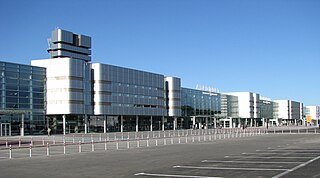
Koltsovo International Airport is the international airport serving Yekaterinburg, Russia, located 16 km (10 mi) southeast of the city. Being the largest airport in Sverdlovsk Oblast, Koltsovo also serves nearby towns such as Aramil, Sysert, and Polevskoy. In general, the airport is responsible for serving approximately 4,290,000 people yearly. The airport is a hub for Ural Airlines, RusLine and Aviacon Zitotrans. Due to its location in the center of Russia, Yekaterinburg's airport is included in the "Priority Airports" list of Russia's Federal Air Transport Agency (Rosaviatsia).

Serov is a mining and commercial town in Sverdlovsk Oblast, Russia, located on the eastern foothills of the Ural Mountains, on the left bank of the Kakva River, about 350 kilometers (220 mi) north of Yekaterinburg. Population: 99,373 (2010 Russian census) ; 99,804 (2002 Census) ; 104,158 (1989 Soviet census) .

Pervouralsk is a city in Sverdlovsk Oblast, Russia, located on the Chusovaya River 39 kilometers (24 mi) west of Yekaterinburg, the administrative center of the oblast. Population: 124,528 (2010 Russian census) ; 132,277 (2002 Census) ; 142,193 (1989 Soviet census) ; 122,000 (1974); 90,000 (1959); 44,000 (1939).

Sredneuralsk is a town under the administrative jurisdiction of the Town of Verkhnyaya Pyshma in Sverdlovsk Oblast, Russia, located on the shore of Iset Lake, at the head of the Iset River, 25 kilometers (16 mi) north of Yekaterinburg. Population: 20,449 (2010 Russian census) ; 19,555 ; 18,786 (1989 Soviet census) .

Anton Alekseyevich Bakov is a Russian businessman, monarchist politician, traveler, writer and human rights activist. He is the chairman of the Russian Monarchist Party, was a member of the 4th convocation of the State Duma of Russia from 2003 to 2007 and was a candidate at 2018 Russian presidential election. Due to being known for a long series of unusual political projects such as Ural franc, the writer Alexei Ivanov coined him a "political Leonardo".

Alexander Sergeevich Misharin is the former governor of Sverdlovsk Oblast, a region in Russia. He was appointed in 2009 after resignation of the previous governor, Eduard Rossel and resigned on May 14, 2012. Prior to his governorship, he made a career in the railway industry, rising to Russia's Deputy Railway Minister. He was appointed first vice-president of Russian Railways and head of Skorostniye Magistrali, the Russian high-speed rail developer and operator on November 28, 2012.

Isetsky District is an administrative district (raion), one of the twenty-two in Tyumen Oblast, Russia. As a municipal division, it is incorporated as Isetsky Municipal District . It is located in the west of the oblast. The area of the district is 2,751 square kilometers (1,062 sq mi). Its administrative center is the rural locality of Isetskoye. Population: 26,061 ; 26,565 (2002 Census) ; 25,862 (1989 Soviet census) . The population of Isetskoye accounts for 28.7% of the district's total population.

Gostiny Dvor – is a shopping (merchant) center in the historical center of Kamensk-Uralsky, Sverdlovsk oblast.

The Men's College building is a mansion in the historical center of Kamensk-Uralsky, Sverdlovsk oblast.

Zyryanov manor house is located in the historical center of Kamensk-Uralsky, Sverdlovsk oblast.

Church of the Intercession of the Most Holy Mother of God - is an Orthodox church in Kamensk-Uralsky, Sverdlovsk oblast.

Ural Aluminum Smelter Proletarian's Group of Houses is a complex of residential buildings in Kamensk-Uralsky, Sverdlovsk oblast.

The Rail Bridge over the Iset River - is an experimental bridge over the Iset River is a unique engineering structure made according to the advanced technology of the late 1930s in Kamensk-Uralsky, Sverdlovsk oblast.

Boris Yeltsin Street is a street in Yekaterinburg, Russia.
The coat of arms of Yekaterinburg is the official municipal coat of arms of Yekaterinburg, Russia. The current symbol was adopted on 23 May 2008 and consists of a French shield divided horizontally into two fields, with a white mine shaft and a white furnace within the top field, which is green, and a blue wavy bend within the bottom field, which is gold. A gold bear and gold sable are located to the left and right of the shield, respectively. A gold crown with a gold laurel wreath is located above the shield and a gold ribbon is located below the shield. A grey druse is located at the bottom center of the shield.

Yevgeny Vladmirovich Kuyvashev is a Russian politician serving as Governor of Sverdlovsk Oblast since 29 May 2012. He served as the acting governor from 14 May 2012 to 29 May 2012, and again from 17 April 2017 to 18 September 2017.

Alexander Leonidovich Burkov is a Russian politician who served as governor of Omsk Oblast from 2017 to 2023. He is a member of the Central Council of A Just Russia — For Truth party.
The 2022 Sverdlovsk Oblast gubernatorial election took place on 11 September 2022, on common election day. Governor Yevgeny Kuyvashev was re-elected for a third term.
- 1 2 3 4 5 6 Law #30-OZ
- 1 2 3 Haywood, A. J. (2010). Siberia: A Cultural History , Oxford University Press, p. 32
- ↑ Charter of Yekaterinburg, Article 24.1
- ↑ Official website of Yekaterinburg. Alexander Edmundovich Yakob, Head of Administration of the City of Yekaterinburg Archived 12 July 2015 at the Wayback Machine (in Russian)
- ↑ "Проект о внесении изменений в Генеральный план развития городского округа – муниципального образования «город Екатеринбург» на период до 2025 года" (in Russian). p. 168. [ permanent dead link ]
- 1 2 Federal State Statistics Service (21 May 2004). Численность населения России, субъектов Российской Федерации в составе федеральных округов, районов, городских поселений, сельских населённых пунктов – районных центров и сельских населённых пунктов с населением 3 тысячи и более человек [ Population of Russia, Its Federal Districts, Federal Subjects, Districts, Urban Localities, Rural Localities—Administrative Centers, and Rural Localities with Population of Over 3,000 ] (XLS) . Всероссийская перепись населения 2002 года [All-Russia Population Census of 2002] (in Russian).
- ↑ "Federal State Statistic Service" . Government of Russia. 1 January 2024 . Retrieved 6 June 2024 .
- 1 2 Государственный комитет Российской Федерации по статистике. Комитет Российской Федерации по стандартизации, метрологии и сертификации. №ОК 019-95 1 января 1997 г. « Общероссийский классификатор объектов административно-территориального деления. Код 65 401 », в ред. изменения №278/2015 от 1 января 2016 г.. (State Statistics Committee of the Russian Federation. Committee of the Russian Federation on Standardization, Metrology, and Certification. # OK 019-95 January 1, 1997 Russian Classification of Objects of Administrative Division (OKATO). Code 65 401 , as amended by the Amendment # 278/2015 of January 1, 2016. ).
- 1 2 3 Law #85-OZ
- ↑ "Об исчислении времени" . Официальный интернет-портал правовой информации (in Russian). 3 June 2011 . Retrieved 19 January 2019 .
- 1 2 "Срок регистрации домена закончился" . www.ekaterinburg.com . Archived from the original on 21 January 2013 . Retrieved 26 February 2022 .
- ↑ Upton, Clive ; Kretzschmar, William A. Jr. (2017). The Routledge Dictionary of Pronunciation for Current English (2nd ed.). Routledge. p. 1552. ISBN 978-1-138-12566-7 .
- ↑ "RUSSIA: Ural'skij Federal'nyj Okrug: Ural Federal District" . City Population.de . 4 August 2020 . Retrieved 2 October 2020 .
- ↑ "Рейтинг столичных городов России от Фонда "Институт экономики города" " . Urbaneconomics.ru .
- ↑ Kolossov, Vladimir; Eckert, Denis (1 January 2007). "Russian regional capitals as new international actors: the case of Yekaterinburg and Rostov" . Belgeo (1): 115–132. doi : 10.4000/belgeo.11686 .
- ↑ "Central Asian Chapter by Eurasian Respiratory and Allergy Consortium" . Era-cac.org . Archived from the original on 12 June 2018 . Retrieved 1 June 2018 .
- ↑ "Yekaterinburg - Entertainment - Russia.com" . Russia.com .
- ↑ "Конструктивизм. Жемчужина архитектуры Екатеринбурга" . www.e1.ru (in Russian). 16 January 2018 . Retrieved 21 December 2021 .
- ↑ "Как Екатеринбург за 10 лет стал столицей конструктивизма" . Strelka Mag (in Russian). Archived from the original on 5 March 2021 . Retrieved 21 December 2021 .
- ↑ Урал, Наш (19 May 2016). "Советская утопия: эпоха конструктивизма в Екатеринбурге" . Наш Урал (in Russian) . Retrieved 21 December 2021 .
- ↑ "Все кругом храпят, а Екатеринбург — пробужденный Когда уральский город объявил себя российской столицей стрит-арта, многие смеялись. А потом он стал ею" . Meduza (in Russian) . Retrieved 21 December 2021 .
- ↑ "Как Екатеринбург становится столицей стрит-арта" . Российская газета (in Russian). 16 April 2019 . Retrieved 21 December 2021 .
- ↑ "Екатеринбург – столица стрит-арта. Часть первая" . www.uralweb.ru (in Russian). Archived from the original on 3 March 2021 . Retrieved 21 December 2021 .
- ↑ "Памятникик археологии" . 1723.ru . Retrieved 20 May 2018 .
- 1 2 "1.2. Палкинские каменные палатки. Проект 1. | "Образование Урала" " . uraledu.ru (in Russian). Archived from the original on 5 April 2012 . Retrieved 20 May 2018 .
- ↑ ГАМАЮНСКАЯ КУЛЬТУРА – Уральская Историческая Энциклопедия . ural.ru (in Russian). Archived from the original on 22 July 2014 . Retrieved 20 May 2018 .
- 1 2 3 4 5 6 "Екатеринбург" . Геральдика Свердловской области . Официальный сайт областной думы законодательного собрания. Archived from the original on 8 March 2013 . Retrieved 6 December 2009 .
- ↑ Юрий, Коновалов (26 March 2004). "Первые русские поселения на реке Уктус" . www.okorneva.ru (in Russian) . Retrieved 7 June 2024 .
- 1 2 Кулешов, Николай (2001). "Горных заводов щит" . Домострой (4).
- ↑ Архипова, Нина (2001). "Тайны "превысочайшего Камня" ". Родина (11).
- ↑ Корепанов Н. С. Уктус — исток Екатеринбурга — Екатеринбург: Грачёв и партнёры, 2012. — 40 экз. — ISBN 978-5-91256-129-0
- 1 2 3 4 5 Юхт, Александр (1985). Государственная деятельность В. Н. Татищева в 20-е — начале 30-х годов XVIII века (in Russian). Moscow: Наука .
- ↑ "Библиотека истории: Ремесло историка в России – Бердинских В.А." history-library.com . Archived from the original on 1 April 2019 . Retrieved 20 May 2018 .
- ↑ Завод-крепость – История основания Екатеринбурга – Информационный портал Екатеринбурга . ekburg.ru (in Russian) . Retrieved 20 May 2018 .
- 1 2 "Основание Екатеринбурга" . Histrf.ru . Retrieved 20 February 2022 .
- ↑ Металлургические заводы Урала XVII—XX вв.: Энциклопедия / глав. ред. В. В. Алексеев. — Екатеринбург : Издательство «Академкнига», 2001.
- 1 2 ipravo.info. "О ликвидации Баженовского и Сысертского районов Уральской области и о расширении городской черты и пригородной зоны города Свердловска – Российский Правовой Портал" (in Russian). ipravo.info. Archived from the original on 19 June 2018 . Retrieved 19 June 2018 .
- 1 2 "History of the Verkh-Isetsky district" . Administration of Verkh-Isetsky district . Archived from the original on 16 December 2021 . Retrieved 7 June 2024 .
- ↑ "Золотой век Екатеринбурга" . Уралнаш. Интересно о Екатеринбурге . 9 October 2019. Archived from the original on 14 August 2021 . Retrieved 15 August 2021 .
- ↑ "50 интересных фактов об Екатеринбурге — Общенет" . obshe.net . Retrieved 15 August 2021 .
- ↑ Massie, Robert K. (22 February 2012). The Romanovs: The Final Chapter . Random House Publishing Group. ISBN 9780307873866 .
- ↑ "FSU News" . fsu.edu . Retrieved 15 May 2018 .
- 1 2 3 История Екатеринбурга – Информационный портал Екатеринбурга . ekburg.ru (in Russian) . Retrieved 20 May 2018 .
- ↑ "Временное Областное Правительство Урала – Энциклопедия Екатеринбурга – Энциклопедии & Словари" . enc-dic.com . Archived from the original on 20 May 2018 . Retrieved 20 May 2018 .
- ↑ Главная: НОВОСТИ . familii.ru (in Russian) . Retrieved 20 May 2018 .
- ↑ "Справочник по административно-территориальному делению Свердловской области" (PDF) . ГАСО (State Archive of the Sverdlovsk oblast). p. 37. Archived from the original (PDF) on 22 February 2017 . Retrieved 2 February 2013 .
- ↑ Rappaport, Helen (1999). Joseph Stalin: A Biographical Companion . ABC-CLIO. ISBN 978-1-57607-084-0 .
- ↑ Беркович Артём. "Пермь и Екатеринбург: история соперничества" . Муниципальный музей истории Екатеринбурга. Archived from the original on 25 May 2013 . Retrieved 16 December 2009 .
- ↑ In the name of Victory. Sverdlovsk-Yekaterinburg during the Great Patriotic War of 1941–1945 . 2005 – via Ekaterinburg: Institute of History and Archeology of the Ural Branch of the Russian Academy of Sciences.
- ↑ "Свердловск – 1983 год" . 1723.ru . Retrieved 20 May 2018 .
- ↑ "Интервью – АПИ-Урал" . apiural.ru . Retrieved 15 May 2018 .
- ↑ "President Yeltsin speaks about Tsar Murder" . BBC News . 17 July 1998 . Retrieved 4 April 2012 .
- ↑ Matthew S. Meselson, et al., "The Sverdlovsk Anthrax Outbreak of 1979", Science 266:5188 (18 November 1994): 1202–1208.
- ↑ Martin McCauley, "Who's who in Russia since 1900", Routledge , 1997: p.133.
- ↑ Ровно 18 лет назад Свердловск снова стал Екатеринбургом . Официальный портал Екатеринбурга (in Russian). Archived from the original on 16 April 2013 . Retrieved 15 May 2018 .
- ↑ "О возвращении городу Свердловску его исторического названия Екатеринбург, Указ Президиума Верховного Совета РСФСР от 23 сентября 1991 года №1674-1" . docs.cntd.ru . Retrieved 15 May 2018 .
- ↑ (www.dw.com), Deutsche Welle. "First BRIC summit concludes | DW | 16 June 2009" . DW.COM . Retrieved 20 May 2018 .
- 1 2 FIFA.com. "2018 FIFA World Cup Russia" . fifa.com . Archived from the original on 12 April 2014 . Retrieved 23 May 2018 .
- ↑ "Russia moves to year-round winter time" . BBC News . 22 July 2014 . Retrieved 20 May 2018 .
- 1 2 3 Грязнов Олег Николаевич; Гуляев Александр Николаевич; Рубан Наталья Валентиновна (2015). "Факторы инженерно-геологических условий города Екатеринбурга" . Izvestiia Uralʹskogo Gorno-Geologicheskoĭ Akademii (журнал) (3) (Известия Уральского государственного горного университета ed.). Екатеринбург: Федеральное государственное бюджетное образовательное учреждение высшего образования "Уральский государственный горный университет": 5–21. ISSN 2307-2091 .
- ↑ Погода и Климат – Климат Екатеринбург [ Weather and Climate – The Climate of Yekaterinburg ] (in Russian). Weather and Climate (Погода и климат) . Retrieved 8 November 2021 .
- ↑ "WMO Climate Normals for Sverdlovsk 1961–1990" . National Oceanic and Atmospheric Administration . Retrieved 29 October 2021 .
- ↑ Russian Federal State Statistics Service. Всероссийская перепись населения 2020 года. Том 1 [ 2020 All-Russian Population Census, vol. 1 ] (XLS) (in Russian). Federal State Statistics Service .
- ↑ "Национальный состав населения" (PDF) . Территориальный орган Федеральной службы государственной статистики по Свердловской области и Курганской области . Retrieved 7 June 2023 .
- ↑ "В Екатеринбурге заложили первый камень в основание соборной мечети – Уральская палата недвижимости" . upn.ru . Archived from the original on 10 October 2012 . Retrieved 5 October 2017 .
- ↑ "Четвертый канал" . channel4.ru . Archived from the original on 20 December 2010 . Retrieved 5 October 2017 .
- ↑ "Встреча Святейшего Патриарха Кирилла с общественностью Уральского федерального округа / Видеоматериалы / Патриархия.ru" . Патриархия.ru (in Russian) . Retrieved 18 October 2017 .
- ↑ "Устав Свердловской области (с изменениями на 7 декабря 2017 года), Устав Свердловской области от 23 декабря 2010 года №105-ОЗ, Закон Свердловской области от 23 декабря 2010 года №105-ОЗ" . docs.cntd.ru . Retrieved 2 May 2018 .
- 1 2 "Закон Свердловской области Губернатора Свердловской области № 141-ОЗ" . www.pravo.gov66.ru . Retrieved 12 March 2022 .
- 1 2 "Закон Свердловской области от 18.02.2021 № 9-ОЗ ∙ Официальное опубликование правовых актов ∙ Официальный интернет-портал правовой информации" . publication.pravo.gov.ru . Archived from the original on 12 March 2022 . Retrieved 12 March 2022 .
- 1 2 The population of the Russian Federation for municipalities as of 1 January 2019 Archived 16 October 2019 at the Wayback Machine (2 May 2019)
- ↑ "К 2023 году население Академического района вырастет до 120 тысяч человек" . Новый День (in Russian). 27 March 2019 . Retrieved 12 March 2022 .
- 1 2 "Chapter IV. Bodies and officials of local self-government of the municipality "city of Yekaterinburg" " . екатеринбург.рф . 25 July 2017. Archived from the original on 26 June 2016 . Retrieved 19 May 2018 .
- ↑ "Официальный интернет-портал правовой информации" . publication.pravo.gov.ru .
- 1 2 "Вы точно человек?" . КиберЛенинка . Retrieved 20 May 2018 .
- 1 2 "О внесении изменений в Устав муниципального образования "город Екатеринбург", Решение Екатеринбургской городской Думы Свердловской области от 12 октября 2010 года №62/29" . docs.cntd.ru .
- ↑ Article 42 of the Charter of Sverdlovsk Oblast
- ↑ "О ПРЕОБРАЗОВАНИИ И РЕОРГАНИЗАЦИИ АДМИНИСТРАЦИИ СВЕРДЛОВСКОЙ ОБЛАСТИ (с изменениями на: 06.02.1997), Постановление Правительства Свердловской области от 27 сентября 1995 года №13-П" . docs.cntd.ru .
- ↑ "Сведения о проводящихся выборах и референдумах" . sverdlovsk.vybory.izbirkom.ru . Archived from the original on 22 September 2013 . Retrieved 21 May 2018 .
- ↑ "Voting results for the Federal Electoral District – Election of Deputies of the State Duma of the Federal Assembly of the Russian Federation of the Seventh Convocation – September 18, 2016" . CEC. Archived from the original on 28 December 2016 . Retrieved 21 May 2018 .
- ↑ "Российские города отстают в развитии" . НИУ ВШЭ . 28 August 2014. Archived from the original on 5 February 2017 . Retrieved 7 July 2016 .
- ↑ "Urban world: Mapping the economic power of cities" . McKinsey Global Institute . March 2011. Archived from the original on 2 April 2024 . Retrieved 7 July 2016 .
- ↑ "Рейтинг столичных городов России от Фонда "Институт экономики города" | Институт экономики города" . urbaneconomics.ru . Retrieved 20 May 2018 .
- ↑ Economics of Russian cities and urban agglomeration , Institute for Urban Economics
- 1 2 Алексей Белоусов, Орнат Валентина. (13 October 2015). "Екатеринбург – глобальный город" . Мегаполис. Archived from the original on 27 August 2016 . Retrieved 7 July 2016 .
- ↑ Зубаревич Н.В. (2013). "Крупные города России: лидеры и аутсайдеры" (PDF) . Demoskop Weekly (журнал) (551–552) (Демоскоп Weekly ed.). М.: НИУ ВШЭ: 1–17. ISSN 1726-2887 .
- ↑ "Екатеринбург вошел в топ-10 городов с самым высоким уровнем жизни" . JustMedia . 17 December 2014 . Retrieved 14 May 2018 .
- 1 2 3 "Results of social and economic development of the municipal formation "city of Yekaterinburg" in 2015" . 2016. p. 202 – via Ekaterinburg: Department of Economics of the Administration of the City of Yekaterinburg.
- ↑ "Итоги социально-экономического развития Екатеринбурга" . Archived from the original on 2 December 2020 . Retrieved 19 October 2022 .
- ↑ Дарья Воронина. (19 June 2013). "Главными проблемами Екатеринбурга назвали медицину, ЖКХ и дороги" . Российская газета . Retrieved 7 July 2016 .
- ↑ Юлия Позднякова. (22 April 2016). "Расходы бюджета Екатеринбурга за 2015 год составили почти 33 млрд рублей" . Коммерсантъ . Retrieved 7 July 2016 .
- ↑ Полина Путякова. (30 August 2016). "Меряемся бюджетами: Откуда города берут деньги и на что тратят" . zvzda.ru. Archived from the original on 2 September 2016 . Retrieved 7 July 2016 .
- 1 2 3 Kachanova E.A. Strategic Priorities for the formation of finance for municipalities in the context of reforming the budgetary system Archived 15 December 2017 at the Wayback Machine , – Moscow: Russian Academy of National Economy and State Service under the President of the Russian Federation, 2013. – 354 p.
- ↑ Vyacheslav, Kostyuk (12 December 2014). "His alien" . The Ural Worker . Archived from the original on 10 April 2018 . Retrieved 20 May 2018 .
- ↑ "Крупнейшие банки России по капиталу" . Журнал "Коммерсантъ Деньги" . 25 July 2016. p. 60 . Retrieved 20 May 2018 .
- ↑ "Крупнейшие производители ПО" .
- ↑ "О распределении обязанностей по контролю и надзору за соблюдением законодательства Российской Федерации организациями, осуществляющими профессиональную деятельность на рынке ценных бумаг, деятельность центрального депозитария, деятельность по проведению организованных торгов, клиринговую деятельность и деятельность центрального контрагента, репозитарную деятельность, а также деятельность саморегулируемых организаций в сфере финансового рынка, объединяющих профессиональных участников рынка ценных бумаг, и об отмене отдельных распорядительных актов Банка России, Приказ Банка России от 07 августа 2017 года №ОД-2228" . docs.cntd.ru .
- ↑ "Падающие пиксели и огромный шар: как может выглядеть "Екатеринбург-Сити" " . РБК Недвижимость . 13 September 2016 . Retrieved 20 May 2018 .
- ↑ Development results, 2016 , pg 76
- ↑ "ТОП-100 крупнейших предприятий Свердловской области Екатеринбург" . Деловой квартал. 11 October 2011 . Retrieved 14 June 2016 .
- ↑ "ИТОГИ социально-экономического развития муниципального образования «город Екатеринбург» в 2019 году" . Archived from the original on 29 November 2020 . Retrieved 19 October 2022 .
- ↑ Development results, 2016 , p. 127–128
- 1 2 Development results, 2016 , p. 129
- ↑ "Леруа Мерлен" . Archived from the original on 18 October 2021 . Retrieved 27 April 2020 .
- ↑ "Castorama – строительный гипермаркет: купить товары для дома, дачи и ремонта" . Castorama.ru . Retrieved 20 February 2022 .
- ↑ "Домострой" . Archived from the original on 30 July 2019 . Retrieved 27 April 2020 .
- ↑ "Максидом - интернет-магазин товаров для дома" . www.maxidom.ru . Retrieved 20 February 2022 .
- ↑ "ОБИ строительный гипермаркет: товары для дачи, сада, дома и ремонта: каталог ОБИ" . Obi.ru . Retrieved 20 February 2022 .
- ↑ "Строительный Двор – интернет-магазин стройматериалов, купить с доставкой строительные материалы в магазинах сети" . Sdvor.com . Archived from the original on 13 May 2020 . Retrieved 20 February 2022 .
- ↑ Development results, 2016 , pg 130
- ↑ Development results, 2016 , pg 131–132
- ↑ Development results, 2016 , pg 133–135
- ↑ "Топ-20 самых больших торговых центров РФ" . marketmedia.ru (in Russian) . Retrieved 11 December 2021 .
- ↑ "Сима-Ленд" . 20 October 2016.
- ↑ Вячеславовна, Логунцова Ирина (2015). "Специфика и перспективы Российской индустрии туризма на современном этапе" . Государственное управление. Электронный вестник (52): 259–278.
- ↑ Геннадьевич, Шеломенцев Андрей; Сергеевна, Головина Анна (2011). "Индустрия туризма региона в контексте принципов саморегулирования региональных социально-экономических систем" . Экономика региона (1): 166–170. ISSN 2072-6414 .
- ↑ Екатеринбург поднялся на третье место в топе российских городов по популярности среди иностранных туристов . URBC.RU – новости экономики (in Russian) . Retrieved 20 May 2018 .
- ↑ "Число посетивших Екатеринбург туристов выросло в 2015 году на 10%" . Retrieved 20 May 2018 .
- ↑ "Туристический мастер-класс" . expert.ru . Archived from the original on 13 September 2016 . Retrieved 20 May 2018 .
- ↑ Маренков Г.В. (2012). "Транспортная инфраструктура Свердловской области – связующее звено между Европой и Азией" (PDF) . Инфраструктура России (Том 1 ed.). М.: Центр стратегического партнёрства. pp. 254–260. Archived from the original (PDF) on 12 July 2018 . Retrieved 8 October 2017 .
- ↑ Мальцева Ю.; Волкова М.В. (2015). "Изучение возможности постройки современного экологического жилья в Свердловской области" (PDF) (сборник трудов IX заочной международной научно-практической конференции (Екатеринбург, 30–31 мая 2015 г.)) (Система управления экологической безопасностью ed.). Екатеринбург: УрФУ. pp. 138–141.
- ↑ Ведомости (10 March 2015). "Автопарк России увеличился в 2014 году на 1 млн легковых машин" . Retrieved 8 October 2017 .
- ↑ "Вы точно человек?" . КиберЛенинка . Retrieved 8 October 2017 .
- 1 2 "ИТОГИ социально-экономического развития муниципального образования в 2015 году" . 2016. Archived from the original on 16 August 2021 . Retrieved 7 July 2022 .
- ↑ Цариков А.А.; Обухова Н.А.; Оглы Мирзоев Н.З. (2015). "Эволюция системы заторов на улично-дорожной сети города Екатеринбурга" (PDF) (журнал) (Эксплуатация автомобильного транспорта ed.). Екатеринбург: Общероссийская общественная организация "Российская академия транспорта". pp. 74–86. ISSN 2311-164X . Archived from the original (PDF) on 12 July 2016 . Retrieved 8 October 2017 .
- ↑ Reports, Yekaterinburg News. "Sverdlovsk focusing on two road projects" . Archived from the original on 6 October 2017 . Retrieved 14 June 2017 .
- ↑ Крицкий В.П. (2009). "Дорожное хозяйство Екатеринбурга" (PDF) . Дороги России-2009. Информационно-аналитический каталог (Издание второе, подготовлено к IХ Международной выставке-форуму "Дороги России XXI века" и Дню работников дорожного хозяйства 3000 экз ed.). Екатеринбург: Информационно-издательский холдинг "Реал-Медиа". pp. 204–205, 302. ISBN 978-5-98266-061-9 . Archived from the original (PDF) on 12 July 2018 . Retrieved 8 October 2017 .
- ↑ "Google Maps" . Google Maps . Retrieved 1 May 2018 .
- ↑ "Скандальный бывший МУП Мирошника лидер сферы общественного транспорта Екатеринбурга? По данным мэрии, именно трамваи перевезли больше всего горожан за 2015 год" . Ведомости-Урал. 18 March 2016. Archived from the original on 15 September 2016 . Retrieved 14 June 2016 .
- ↑ "БГД" . gks.ru . Archived from the original on 20 May 2016 . Retrieved 17 October 2017 .
- ↑ "Города Свердловской области" . gks.ru . Archived from the original on 10 July 2009 . Retrieved 8 October 2017 .
- ↑ "Основные технико-эксплуатационные характеристики метрополитенов за 2015 год" (PDF) . asmetro.ru. Archived from the original (PDF) on 8 August 2016 . Retrieved 14 June 2016 .
- ↑ Дмитрий Ольшванг. (18 March 2016). "Проблемы екатеринбургского метро: убытки, снижение пассажиропотока! Общественник Беззуб: "Если учитывать стоимость строительства станций, то цена билета на метро должна быть 144 рубля"..." Ведомости-Урал. Archived from the original on 15 September 2016 . Retrieved 14 June 2016 .
- ↑ "Шины для трамваев, бензин для поездов. Документы: на что транспортные МУПы Екатеринбурга тратят деньги" . uralpolit.ru . Retrieved 13 March 2014 .
- ↑ "Города Свердловской области" . gks.ru . Archived from the original on 30 June 2013 . Retrieved 18 October 2017 .
- ↑ "Строительство трамвайной линии Екатеринбург – Верхняя Пышма начнут в 2016 году" . Портал 66.ru. 22 July 2015 . Retrieved 22 July 2015 .
- ↑ "Официальный портал Екатеринбурга" . Официальный портал Екатеринбурга . Retrieved 18 October 2017 .
- 1 2 "Города Свердловской области" . gks.ru . Archived from the original on 10 July 2009 . Retrieved 18 October 2017 .
- ↑ Автобусный парк Екатеринбурга утепляют к зиме . УралИнформБюро (in Russian) . Retrieved 18 October 2017 .
- ↑ "Более 5,4 миллионов пассажиров обслужил аэропорт Кольцово в 2017 году (АвиаПорт)" . АвиаПорт.Ru (in Russian) . Retrieved 1 May 2018 .
- ↑ "БГД" . gks.ru . Archived from the original on 15 June 2009 . Retrieved 25 May 2018 .
- 1 2 According to the city directory Dubl.
- ↑ Уральский научно-исследовательский институт фтизиопульмонологии – филиал ФГБУ "НМИЦ ФПИ" Минздрава России . urniif.ru (in Russian) . Retrieved 25 May 2018 .
- ↑ "Официальный сайт ГБУ СО "Уральский научно-исследовательский институт дерматовенерологии и иммунопатологии" " . urniidvi.ru . Retrieved 25 May 2018 .
- ↑ Екатеринбургский центр МНТК "Микрохирургия глаза" . eyeclinic.ru (in Russian) . Retrieved 25 May 2018 .
- ↑ Открытие второго центра МРТ-диагностики в городе Екатеринбурге! . ekaterinburg.ldc.ru (in Russian) . Retrieved 25 May 2018 .
- 1 2 М.м, Рогалёва (2014). "Екатеринбург как современный мегаполис" . Человек в мире культуры (4): 14–17. ISSN 2227-9857 .
- ↑ Report of the head of the Yekaterinburg administration, 2016 Archived 5 February 2017 at the Wayback Machine , p. 14.
- ↑ Report of the head of the Yekaterinburg administration, 2016 Archived 5 February 2017 at the Wayback Machine , p. 13, 15.
- ↑ Лучшие школы России-2015 . РИА Новости (in Russian). 12 October 2015 . Retrieved 22 May 2018 .
- ↑ "Общие сведения об университете – ФГБОУ ВО "Уральский государственный горный университет" " . about.ursmu.ru . Archived from the original on 7 July 2016 . Retrieved 22 May 2018 .
- ↑ The second business rating of higher education Archived 29 September 2018 at the Wayback Machine – Federal Portal Russian Education, 22 May 2018
- ↑ Formation of the state elite 2008 Archived 5 February 2017 at the Wayback Machine – Federal Portal Russian Education, 22 May 2018
- ↑ "Российская академия наук намерена готовить кадры самостоятельно | Новости образования | Обучение Екатеринбург" . uchim66.ru . Archived from the original on 4 March 2016 . Retrieved 22 May 2018 .
- ↑ "УрФУ перестраивается в школы" . Коммерсантъ (Екатеринбург) . 22 April 2016 . Retrieved 22 May 2018 .
- ↑ "По количеству бюджетных мест мы уже обошли МГУ" . 7 April 2021.
- ↑ "Ural Federal University – UrFU" .
- ↑ Case study: Ural Federal University as a basic university of industry in the region Archived 1 April 2019 at the Wayback Machine . – Ekaterinburg: Ural Federal University, 2016. – p. 2, 9–10.
- ↑ "Гильдия издателей периодической печати" . 18 September 2011. Archived from the original on 18 September 2011 . Retrieved 26 February 2022 .
- ↑ "Welcome media-atlas.ru - BlueHost.com" . www.media-atlas.ru . Archived from the original on 15 June 2018 . Retrieved 26 February 2022 .
- ↑ Официальный сайт "Вести Урал" – Официальный сайт "Вести Урал" . Официальный сайт "Вести Урал" (in Russian). Archived from the original on 16 July 2012 . Retrieved 22 May 2018 .
- ↑ Вальханская, Наталья (24 March 2018). Взрыв и обрушение: снос телебашни в Екатеринбурге на видео очевидцев . Телеканал "Звезда" (in Russian) . Retrieved 22 May 2018 .
- ↑ "Тёмная башня" . 1723.ru . Retrieved 22 May 2018 .
- ↑ "Uralnets" . uralnets.ru . Retrieved 26 February 2022 .
- ↑ Fletcher, Martin. "Yekaterinburg signs cooperative agreement with Vimpelcom under Beeline brand" Archived 22 July 2013 at archive.today , Yekateringburg News , 19 July 2013. (Retrieved 22 July 2013).
- ↑ "WiseCms – troubles..." culture.ekburg.ru . Archived from the original on 11 July 2012 . Retrieved 24 May 2018 .
- ↑ "WiseCms – troubles..." Culture.ekburg.ru . Archived from the original on 19 January 2011 . Retrieved 24 May 2018 .
- ↑ "Триумф России на Всемирной выставке в Париже 1900 года – Новости РуАН" . новости-россии.ru-an.info . Retrieved 20 February 2022 .
- ↑ Lykova TR Cultural and historical centres of the Sverdlovsk region Archived 11 October 2016 at the Wayback Machine // method. instructions for studying the course "Cultural and Historical Centres of the Urals" for full-time or part-time students, direction 100400 – Tourism. – Ekaterinburg: UGLTU, 2014. – P. 15-16 .
- ↑ "Главная страница - АПИ-Урал" . www.apiural.ru . Retrieved 26 February 2022 .
- ↑ "Архитектура и планировка социалистического Свердловска. Часть 2" . 1723.ru . Retrieved 24 May 2018 .
- ↑ Вейн, Инна (10 November 2020). "Уральские актеры и режиссеры привезли домой сразу четыре "Золотые маски" " . Ekb.dk.ru (in Russian) . Retrieved 15 August 2021 .
- ↑ Fletcher, Martin. "Yekaterinburg to showcase city’s cultural achievements during Year of Culture" Archived 13 February 2014 at archive.today . Yekaterinburg News . 13 February 2014. (Retrieved 13 Feb 2014).
- ↑ Pozdnyakova, Julia (27 May 2016). "Sverdlovsk Oblast was in the picture" . Kommersant . Retrieved 24 May 2018 .
- ↑ "Интервью - АПИ-Урал" . www.apiural.ru . Retrieved 26 February 2022 .
- ↑ "Премией "Шаривари" отметили лучших деятелей циркового искусства – В МИРЕ ЦИРКА И ЭСТРАДЫ" . ruscircus.ru . Retrieved 25 May 2018 .
- ↑ "Ельцин Центр признали «лучшим европейским музеем 2017 года»" . The Village (in Russian) . Retrieved 15 August 2021 .
- ↑ Самые популярные достопримечательности Екатеринбурга соединит красная линия на тротуаре . Interfax-Russia.ru (in Russian). 17 June 2011 . Retrieved 25 May 2018 .
- 1 2 Yekaterinburg Encyclopedia (PDF) . Yekaterinburg: "Akademkniga". 2002. p. 30. ISBN 5-93472-068-6 – via PDF.
- ↑ Yekaterinburg Encyclopedia (PDF) . Yekaterinburg: "Akademkniga". 2002. pp. 30–31. ISBN 5-93472-068-6 – via PDF.
- ↑ Yekaterinburg Encyclopedia (PDF) . Yekaterinburg: "Akademkniga". 2002. p. 31. ISBN 5-93472-068-6 – via PDF.
- 1 2 3 Shvets, A. V. (2016). "Domestic architecture of the late XX – early XXI century" (PDF) . New Ideas of the New Century: Scientific. Compilation . 2 . Khabarovsk: Pacific State University: 355–362. Archived from the original (PDF) on 4 November 2016 . Retrieved 8 June 2018 – via PDF.
- ↑ GmbH, Emporis. "Yekaterinburg | Buildings | EMPORIS" . Emporis . Archived from the original on 8 April 2015 . Retrieved 8 June 2018 .
- ↑ "Официальный портал Екатеринбурга" . Официальный портал Екатеринбурга . Archived from the original on 8 August 2010 . Retrieved 22 May 2018 .
- 1 2 "The announcement ceremony of the host cities of the 2018 World Cup united the whole of Russia" . ru.fifa.com . Archived from the original on 3 September 2014 . Retrieved 23 May 2018 .
- ↑ "База данных показателей муниципальных образований" . gks.ru . Archived from the original on 14 August 2009 . Retrieved 23 May 2018 .
- ↑ sport, Guardian (4 October 2017). "Outer space: the Russia World Cup stadium with a novel seating extension" . the Guardian . Retrieved 23 May 2018 .
- ↑ "Construction: Tsentralnyj Stadion Yekaterinburg – StadiumDB.com" . stadiumdb.com . Retrieved 23 May 2018 .
- ↑ FIFA.com. "2018 FIFA World Cup Russia - News - FIFA Fan Fest venues announced for 2018 FIFA World Cup Russia" . fifa.com . Retrieved 23 May 2018 .
- ↑ Azmukhanov, Alexander (3 May 2018). "The three most expensive projects of the region for the World Cup" . Oblastnaya Gazeta . Retrieved 22 May 2018 .
- ↑ "Official website of the U.S. Consulate General in Yekaterinburg" . Archived from the original on 8 April 2012 . Retrieved 19 April 2012 .
- ↑ "Official website of the British Consulate General in Yekaterinburg" . Archived from the original on 3 January 2012 . Retrieved 19 April 2012 .
- ↑ "Official website of the German Consulate General in Yekaterinburg" . Retrieved 19 April 2012 .
- ↑ "Official website of the French Consulate General in Yekaterinburg" . Archived from the original on 29 April 2012 . Retrieved 19 April 2012 .
- ↑ "Chinese Consulate General in Yekaterinburg" . Retrieved 7 September 2013 .
- ↑ "First summit for emerging giants" . BBC News . 16 June 2009 . Retrieved 16 June 2009 .
- ↑ Hamilton, Louis (18 June 2013). "Yekaterinburg presents city's bid for 2020 World Expo" . Yekaterinburg News. Archived from the original on 27 November 2013 . Retrieved 20 June 2013 .
- ↑ "Глобальный саммит по производству и индустриализации (GMIS – 2019)" . Росконгресс . Retrieved 12 December 2021 .
- ↑ КИРЯГИН, Кирилл (22 July 2015). "ИННОПРОМ – в пятёрке крупнейших промышленных выставок мира" . ural.aif.ru (in Russian) . Retrieved 12 December 2021 .
- ↑ "Побратимы и тезки Екатеринбурга" . ekb-room.ru (in Russian). The Ekb Room. 20 October 2014. Archived from the original on 18 November 2018 . Retrieved 22 December 2020 .
- ↑ "Museum Vladimir Mulyavin in Belarusian State Philharmonic" . Retrieved 22 April 2022 .
- Екатеринбургская городская Дума. Решение №8/1 от 30 июня 2005 г. «О принятии Устава муниципального образования "Город Екатеринбург"», в ред. Решения №1/27 от 27 января 2015 г. «О внесении изменений в Устав муниципального образования "Город Екатеринбург"». Вступил в силу со дня официального опубликования. Опубликован: "Вестник Екатеринбургской городской Думы", №95, 15 июля 2005 г. (Yekaterinburg City Duma. Decision # 8/1 of June 30, 2005 On the Adoption of the Charter of the Municipal Formation of the "City of Yekaterinburg" , as amended by the Decision # 1/27 of January 27, 2015 On Amending the Charter of the Municipal Formation of the "City of Yekaterinburg" . Effective as of the day of the official publication.).
- Областная Дума Законодательного Собрания Свердловской области. Областной закон №30-ОЗ от 20 мая 1997 г. «Об административно-территориальном устройстве Свердловской области», в ред. Закона №32-ОЗ от 25 апреля 2012 г. «О внесении изменений в Областной закон "Об административно-территориальном устройстве Свердловской области"». Вступил в силу со дня официального опубликования за исключением отдельных положений, вступающих в силу в иные сроки. Опубликован: "Областная газета", №81, 3 июня 1997 г. (Oblast Duma of the Legislative Assembly of Sverdlovsk Oblast. Oblast Law # 30-OZ of May 20, 1997 On the Administrative-Territorial Structure of Sverdlovsk Oblast , as amended by the Law # 32-OZ of April 25, 2012 On Amending the Oblast Law "On the Administrative-Territorial Structure of Sverdlovsk Oblast" . Effective as of the day of the official publication with the exception of several clauses which take effect on a different date.).
- Областная Дума Законодательного Собрания Свердловской области. Закон №85-ОЗ от 12 июля 2007 г. «О границах муниципальных образований, расположенных на территории Свердловской области», в ред. Закона №107-ОЗ от 29 октября 2013 г. «Об упразднении отдельных населённых пунктов, расположенных на территории города Ивделя, и о внесении изменений в Приложение 39 к Закону Свердловской области "О границах муниципальных образований, расположенных на территории Свердловской области"». Вступил в силу через 10 дней после официального опубликования. Опубликован: "Областная газета", №232–249, 17 июля 2007 г. (Oblast Duma of the Legislative Assembly of Sverdlovsk Oblast. Law # 85-OZ of July 12, 2007 On the Borders of the Municipal Formations on the Territory of Sverdlovsk Oblast , as amended by the Law # 107-OZ of October 29, 2013 On Abolishing Several Inhabited Localities on the Territory of the Town of Ivdul and on Amending the Law of Sverdlovsk Oblast "On the Borders of the Municipal Formations on the Territory of Sverdlovsk Oblast" . Effective as of the day which is 10 days after the official publication.).
- Official website of Yekaterinburg (in Russian)
| : • | |
| Administrative districts | |
| Cities and towns | |
Structured data
Items portrayed in this file.
- Flags with three horizontal stripes of yellow, green and blue color combination
- Flags of cities and villages of Sverdlovsk Oblast
- SVG sub-national flags of Russia
- Flag of Yekaterinburg
- Flags with fire
- SVG flags with an aspect ratio of 3:2
- Unknown date
- Template Unknown (author)
- PD-RU-exempt (flags)
Navigation menu

IMAGES
VIDEO
COMMENTS
So by and large faster boats have finer hulls. But the wetted surface area (WSA) increases proportionately as fineness increases (for a given displacement the half orange shape gives the least WSA) so fine hulls tend to be slower in low wind speeds. The most important catamaran design hull shape factor, is the Prismatic Coefficient (Cp).
T c = 0.57. Here we put B TR = 1.9 to minimize boat resistance (for her size) and get the draft calculation for a canoe body T c (Figure 1). Midship coefficient - C m. C m = A m / T c (x) B WL. We need to estimate a few coefficients of the canoe body. where A m is the maximum cross section area of the hull (Figure 3).
Although the catamaran hull concept is a relatively new introduction to modern boat design, the boat has been in use since the 5th century. It was used for fishing, traveling, and transporting people and supplies. Parts Of A Catamaran. Here are the basic parts of the modern sailing catamaran: Hulls are what sets this boat apart from the rest ...
Speed and Efficiency. Power catamarans have gained popularity for offering a unique combination of speed, efficiency, and stability. Their dual-hull design allows for less water resistance, which directly translates to higher speeds and better fuel efficiency compared to traditional monohull boats.. In addition, the wide beam provided by the two hulls ensures a stable ride even at higher speeds.
Here's a short explainer on sailing catamaran hull design and the theory behind our own hulls. We have a quite distinctive and unusual design for a high perf...
Have you ever wondered the processes that go into Catamaran design and building a Catamaran? Maybe. Maybe not.However for those of you who are contemplating ...
A third number that we can plug in as a constant if we want to is the prismatic coefficient which describes bow much volume there is end the ends relative to the cross section shape in the middle of the boat, but in sailing boats this is of less importance compared to other factors. The hull lines for Design 256, 8.5m Cat.
The ultimate multihull design and building resource - catamarans and trimarans to 150 feet. Visit Multihullblog.com for latest work, updates, and techniques. Home New Designs ... KHSD boat Videos. Tel: 206.719.4893 Email: Kurt Hughes. [email protected] Slater's Landing ...
The challenge to the catamaran builders and designers is to account for all these forces and build a pair of hulls capable of absorbing these loads without breaking or separating the hulls. Part 2: Crossbeam Design. Catamarans are not new concepts; double hulled sailing canoes were used in Polynesia and Melanesia long before European explorers ...
In the third part of our series, we talk again to Antoine Richer, the Naval Architect at Seawind about how bow shape, hull volume and freeboard affect the pe...
A 16-passenger catamaran is a type of boat or vessel specifically designed to carry 16 people comfortably. Catamarans are multihull boats with two parallel hulls, which are connected by a deck or a structure. They offer stability, speed, and efficiency in the water.
Get the Best Catamaran Hull Design. A cruising catamaran's performance depends on three main aspects; its length, the sail area, and the boat's weight. Long boats are generally fast. A light boat with more sail area is also faster than a heavier boat with less sail area.
Catamarans As one of the oldest hull shapes (imagine two logs tied together), catamarans occupy a small niche in America and larger niches in some other areas of the world. Using two hulls bridged by a deck, the catamaran design provides additional beam, increased stability and, at the same time, increased speed (the slim twin hulls have little ...
Our patented proa design for inboards uses just one engine, one shaft, one prop, one rudder, and one keel—half the typical engine appendage drag of a twin-engine design. The hulls are shaped to compensate for the engine torque. Since both fluid-dynamic and engine-torque forces are proportional to speed, the boat runs straight at every speed.
Asymmetrical Twin Hulls Aspen Power Catamarans. Asymmetrical Twin Hulls This unique design concept comes from the drawing board of Larry Graf, the pioneer who put power catamarans on the map here in the U.S. when he founded Glacier Bay Boats in 1987. His new company, Aspen Powerboats, employs a cat design where one hull is narrower (35 percent ...
Boat Design Net. Home Boat Design ... Catamaran Hull Design. Discussion in 'Multihulls' started by redreuben, Sep 5, 2017. Tags: hull shape double ended; Joined: Jan 2009 Posts: 2,017 Likes: 227, Points: 63, Legacy Rep: 349 Location: South Lake Western Australia redreuben redreuben. I have a question about hull shapes at the waterline. ...
Feb 3, 2020 - Explore Keith A Davis's board "Catamaran Hull Design" on Pinterest. See more ideas about catamaran, boat design, boat building.
The red twin-hull catamaran in the images and video above is Safehaven's new T-2000 Voyager, a 20-m (66-ft), long-range, high-performance, semi-wave piercing explorer boat capable of speeds over ...
The primary use for pre-preg in boating is high performance race boats. With catamarans, pre-preg may be used high load parts, like Gunboat does for foils and rudders. 4. Industry Examples. Across the catamaran building industry you'll find almost all the above techniques and materials used, though some are less common.
Evolved from Safehaven's 75-foot XVS20 monohull launched in 2018, Kowalski used his expertise in building commercial, work-boat power catamarans to design the twin-hulled T-2000 Voyager to offer ...
Rossinavi has delivered its "most innovative project" to date, the 42.8-metre hybrid-electric catamaran named Seawolf X.She has departed the shipyard's facilities in Viareggio, Italy and is now anchored near the Greek island of Tinos according to BOATPro.. Exterior design is by Fulvio De Simoni Yacht Design, marking the first project presented by the pair since the 49.1-metre Aurora in 2017.
774 Likes, TikTok video from Boats.daily (@boatsdailyofficial): "Discover the unique aluminum hull design of Projekt C-39, a fascinating catamaran vessel. Stay tuned for more insights on this one-of-a-kind boat! #boats #catamaran #fishtok".
Catamaran insurance isn't a one-size-fits-all policy. It comes in various forms, each designed to protect different aspects of your boating life. Let's break down the main coverage types: Hull Insurance. The hull is the main body of your catamaran, and it's one of the most expensive parts to repair or replace.
Yekaterinburg is situated 1,036 miles (1,667 km) east of Moscow. Near the village of Shartash, which was founded in 1672 by members of the Russian sect of Old Believers, an ironworks was established in 1721 and a fortress in 1722. In 1723 the new settlement was named Yekaterinburg in honor of Catherine I, the wife of Peter I the Great.
Here's what the boat looks like when it's not in 20-foot seas. Evolved from Safehaven's 75-foot XVS20 monohull launched in 2018, Kowalski used his expertise in building commercial, work-boat power catamarans to design the twin-hulled T-2000 Voyager to offer speed with stability. "The stability in beam seas is what's key here," he says.
This file contains additional information such as Exif metadata which may have been added by the digital camera, scanner, or software program used to create or digitize it.
Yekaterinburg [lower-alpha 1] is a city and the administrative centre of Sverdlovsk Oblast and the Ural Federal District, Russia.The city is located on the Iset River between the Volga-Ural region and Siberia, with a population of roughly 1.5 million residents, [14] up to 2.2 million residents in the urban agglomeration. Yekaterinburg is the fourth-largest city in Russia, the largest city in ...
Flag of Yekaterinburg (Sverdlovsk oblast).svg. Size of this PNG preview of this SVG file: 800 × 533 pixels. Other resolutions: 320 × 213 pixels | 640 × 427 pixels | 1,024 × 683 pixels | 1,280 × 853 pixels | 2,560 × 1,707 pixels. Original file (SVG file, nominally 900 × 600 pixels, file size: 8 KB)